Tait TPDC0A 5W PORTABLE TRANSCEIVER User Manual TP9300 User s Guide
Tait Limited 5W PORTABLE TRANSCEIVER TP9300 User s Guide
Tait >
User Manual

TP9300
DMR Portable Radios
User’s Guide
MPD-00001-08 · Issue 8 · August 2017
Contents 3
Contents
For your safety..................................................................9
Menu maps......................................................................28
1 About this guide ............................................................30
Safety warnings used in this guide........................................... 30
Related documentation............................................................. 31
2 Before using your radio ................................................32
For your safety — battery warning............................................. 33
Attaching labels to the radio or battery ..................................... 33
Charging the battery before first use ........................................ 34
Attaching the battery................................................................. 35
Removing the battery ............................................................... 35
Attaching the antenna............................................................... 36
Removing the antenna ............................................................. 36
Attaching a belt clip .................................................................. 36
Removing a belt clip ................................................................. 36
Installing an audio accessory ................................................... 37
3 Getting started ...............................................................38
About your DMR digital radio.................................................... 39
About the radio controls............................................................ 41
Understanding the radio display ............................................... 43
Understanding the radio indicators........................................... 45
Using function keys to access frequently used features........... 48
Navigating the radio’s menus ................................................... 49
Using the alphanumeric keys to search a list ........................... 50
4 Basic operation ..............................................................51
Turning the radio on and off ..................................................... 52
Adjusting the speaker volume .................................................. 53
Locking and unlocking the keypad ........................................... 53
Using a wireless headset.......................................................... 54
Changing the radio’s operating mode....................................... 59
Setting and viewing the radio’s time and date.......................... 60
5 Using the address book ................................................61
Opening the address book ....................................................... 62
Changing the default address book.......................................... 62
Navigating the address book .................................................... 63
Filtering address book lists ....................................................... 64
Maintaining personal address book entries .............................. 65
6 Operating in conventional mode ..................................69
4 Contents
Selecting a zone ....................................................................... 70
Selecting a channel .................................................................. 71
Selecting a scan or voting group .............................................. 72
Understanding talkgroups......................................................... 74
Making a call............................................................................. 75
Making an individual call........................................................... 77
Making a preset call.................................................................. 77
Making a call using the address book ...................................... 77
Making a local call .................................................................... 78
Dialing a radio call .................................................................... 79
Making a phone call.................................................................. 80
Making a DTMF patch call........................................................ 80
Making an emergency call........................................................ 82
Setting your status (on analog channels) ................................. 83
Sending and receiving status messages.................................. 83
Sending and receiving text messages...................................... 85
Checking the queue.................................................................. 89
Call alert ................................................................................... 90
Radio check.............................................................................. 91
Radio monitor ........................................................................... 92
Radio inhibit and uninhibit ........................................................ 94
Resending calls automatically .................................................. 96
Transmitting at low power......................................................... 97
Ending active calls.................................................................... 98
Using monitor and squelch override (on analog channels) ...... 99
Bypassing the repeater (on analog channels)........................ 100
Receiving a call ...................................................................... 101
Using the radio in different repeater areas ............................. 101
Scanning a group of channels................................................ 102
7 Operating in trunked mode .........................................108
Checking that your network is available ................................. 109
Changing your network........................................................... 109
Making a call using the address book .................................... 110
Making a preset call................................................................ 111
About trunked zones and workgroups .................................... 112
About emergency operation ................................................... 116
Dialing a PABX number.......................................................... 118
Dialing a PSTN number.......................................................... 118
Receiving a call ...................................................................... 119
Re-establishing a call ............................................................. 121
Checking the queue................................................................ 122
About status messages .......................................................... 124
About trunked text messages ................................................. 126
Placing the radio in do-not-disturb mode................................ 129
Switching to conventional channels or conventional groups .. 130
Contents 5
8 Dialing calls in trunked mode .....................................131
MPT 1343 dialing.................................................................... 132
DMR dialing ............................................................................ 134
Nokia ANN fleet calls.............................................................. 136
Accessing common trunking functions ................................... 138
9 Location services ........................................................140
About location information ...................................................... 141
About location statuses .......................................................... 141
Viewing location information................................................... 142
10 Loneworker monitoring ..............................................144
Activating loneworker monitoring............................................ 145
Responding to a loneworker alarm......................................... 145
11 Encryption ....................................................................147
About encryption..................................................................... 148
Encrypting calls ...................................................................... 148
Making an encrypted call........................................................ 149
Receiving an encrypted call.................................................... 149
Removing encryption keys from the radio .............................. 150
12 Customizing radio settings ........................................151
Changing the volume of all audible indicators ........................ 152
Changing the volume of keypress tones ................................ 152
Changing to quiet operation ................................................... 153
Changing to silent operation................................................... 153
Turning on backlighting .......................................................... 154
Adjusting the display contrast................................................. 155
13 Charging and caring for batteries ..............................156
About the chargers ................................................................. 157
6-way charger safety information ........................................... 158
Special conditions when using IS/NI radios............................ 158
Before using the charger ........................................................ 159
Charging temperatures........................................................... 160
Leaving the battery on charge ................................................ 160
Receiving calls while charging (not for battery-only vehicle
charger) .................................................................................. 161
Low battery warning ............................................................... 162
Inserting the radio into the vehicle charger............................. 163
Charging a battery for the first time ........................................ 164
Charging a battery .................................................................. 164
LED behavior.......................................................................... 165
Removing the battery from the charger .................................. 166
Maintaining battery life and performance ............................... 166
Storing batteries ..................................................................... 167
6 Contents
Disposing of batteries ............................................................. 167
14 Troubleshooting ..........................................................168
About troubleshooting............................................................. 169
When your radio won’t turn on................................................ 169
Identifying the radio’s audible tones ....................................... 169
Viewing radio information ....................................................... 170
General care........................................................................... 170
Directive 1999/5/CE Declaration of Conformity .........172
Tait Software Licence Agreement...............................173
7
Copyright and trademarks
All information contained in this document is the property of
Tait Limited. All rights reserved. This document may not, in
whole or in part, be copied, photocopied, reproduced,
translated, stored, or reduced to any electronic medium or
machine-readable form, without prior written permission from
Tait Limited.
The word TAIT and the TAIT logo are trademarks of Tait
Limited.
All trade names referenced are the service mark, trademark
or registered trademark of the respective manufacturers.
Disclaimer
There are no warranties extended or granted by this
document. Tait Limited accepts no responsibility for damage
arising from use of the information contained in the document
or of the equipment and software it describes. It is the
responsibility of the user to ensure that use of such
information, equipment and software complies with the laws,
rules and regulations of the applicable jurisdictions.
Enquiries and comments
If you have any enquiries regarding this document, or any
comments, suggestions and notifications of errors, please
contact your regional Tait office.
Updates of manual and equipment
In the interests of improving the performance, reliability or
servicing of the equipment, Tait Limited reserves the right to
update the equipment or this document or both without
prior notice.
Intellectual property rights
This product may be protected by one or more patents or
designs of Tait Limited together with their international
equivalents, pending patent or design applications, and
registered trade marks: NZ 409837, NZ 409838, NZ 415277,
NZ 415278, NZ 530819, NZ 534475, NZ 547713, NZ 577009,
NZ 579051, NZ 579364, NZ 586889, NZ 610563, NZ 615954,
NZ 700387, NZ 708662, NZ 710766, NZ 711325 , NZ 726313,
NZ593887, AU 2015215962, AU 339127, AU 339391,
AU2016259281, AU2016902579, EU 000915475-0001,
EU 000915475-0002, GB 2532863, US 14/834609 Div. no 1,
US 15/346518 Div.no 2, US 15/350332, US 15/387026 Div.,
US 20150085799, US 20160044572, US 20160057051,

8
US 640974, US 640977, US 698339, US 702666, US 7758996,
US 8902804, US 9107231, US 9504034, US 9559967.
This product may also be made under license under one or
more of the following patents:
- US7203207, AU2004246135, CA2527142, GB2418107,
HK1082608, MY134526, US8306071
- US7339917, AU2004246136, CA2526926, GB2418812,
MY134217
- US7499441, AU2005262626, CA2570441, GB2430333,
JP4690397, NZ551231, KR100869043, RU2351080,
BRP10512052, MXPA06015241
- US 7200129, AU2005226531, CA2558551, CN1930809,
GB2429378, JP4351720, BRP10508671, NZ549124,
KR848483, RU2321952
The AMBE+2™ voice coding Technology embodied in this
product is protected by intellectual property rights including
patent rights, copyrights and trade secrets of Digital Voice
Systems, Inc. This voice coding Technology is licensed solely
for use within this Communications Equipment. The user of
this Technology is explicitly prohibited from attempting to
decompile, reverse engineer, or disassemble the Object
Code, or in any other way convert the Object Code into a
human-readable form.
The Bluetooth® word mark and logos are registered
trademarks owned by Bluetooth SIG, Inc, and any use of
such marks by Tait Limited is under licence. Other
trademarks and trade names are those of their respective
owners.
Environmental responsibilities
Tait Limited is an environmentally responsible company
which supports waste minimization, material recovery and
restrictions in the use of hazardous materials.
The European Union’s Waste Electrical and Electronic
Equipment (WEEE) Directive requires that this product be
disposed of separately from the general waste stream when
its service life is over. For more information about how to
dispose of your unwanted Tait product, visit the Tait WEEE
website at
www.taitradio.com/weee
. Please be
environmentally responsible and dispose through the original
supplier, or contact Tait Limited.
Tait Limited also complies with the Restriction of the Use of
Certain Hazardous Substances in Electrical and Electronic
Equipment (RoHS) Directive in the European Union.
In China, we comply with the Measures for Administration of
the Pollution Control of Electronic Information Products. We
will comply with environmental requirements in other markets
as they are introduced.

For your safety 9
For your safety
Before using your radio, please read the following
important safety and compliance information.
Intrinsically Safe and Non-Incendive
radios and accessories
Intrinsically Safe (IS) and Non-Incendive (NI) radios and
accessories are certified by a third party to be safe to use
in particular hazardous locations, or in potentially
explosive atmospheres.
Warning Explosion hazard!
IS/NI certification applies
only while the product is used in accordance with these
instructions.
Warning Explosion hazard!
Ensure that the ratings
printed on a label on the equipment will permit your IS/NI
radio and accessories to be used in your hazardous
location. Refer also to
"Rating matching" on page 14
.
Warning Explosion hazard!
Use only a Tait-supplied,
IS/NI-approved battery, charger, antenna, audio
accessory, carry accessory or programming adapter with
an IS/NI radio. Fitting a battery or accessory that is not IS/
NI-approved, using a charger that is not IS/NI-approved,
or failing to use the IS/NI programming adapter, creates a
risk of explosion which could cause serious injury or
death. For an up-to-date list of approved accessories,
contact your regional Tait office.
Warning Explosion hazard!
Do not charge the
battery, or change the antenna, in a hazardous location.
An explosion could cause serious injury or death.
Warning Explosion hazard!
You must use a battery
carry case when carrying a spare battery into a hazardous
area.

10 For your safety
IS/NI radios, batteries, antennas and accessories must
not be engraved or modified in any way. Do not use the
radio, battery or accessory if it is cracked or damaged. Do
not use the antenna if the sheathing is split or the end cap
is missing. Do not expose the radio to solvents. IS/NI
radios and accessories must be serviced only by an
agency certified by both the approval authority and by Tait
Limited. Any unauthorized repair or substitution of parts
invalidates the IS/NI rating and the third party IS/NI
approval. To have an IS/NI radio serviced, return it to your
regional Tait office.
Radios
One or more of the following marks identifies a TP9300/
TP9400 radio as an IS/NI radio:
■
an IS circle logo on the radio’s front panel
■
a label on the radio, showing IS/NI information
■
a label on the radio battery, showing IS/NI information
Radios with the product code “T03-22xxx-xxxx” have IS/
NI approval and are approved to one or several of the
following ratings. Refer also to
"Rating matching" on
page 14
.
■
Class I, Zone 1, AEx ib IIC T4...T3 (USA)
■
Class I, Zone 1, AEx ib IIA T4...T3 (USA)
■
Class I, Division 2, Group A, B, C, D, T4...T3
(USA and Canada)
■
Class II, Division 2, Group E, F, G T4...T3
(USA and Canada)
■
Class III, Division 1 (USA and Canada)
■
Ex ib IIC T4...T3 Gb (Canada)
■
Ex ib IIA T4...T3 Gb (Canada)
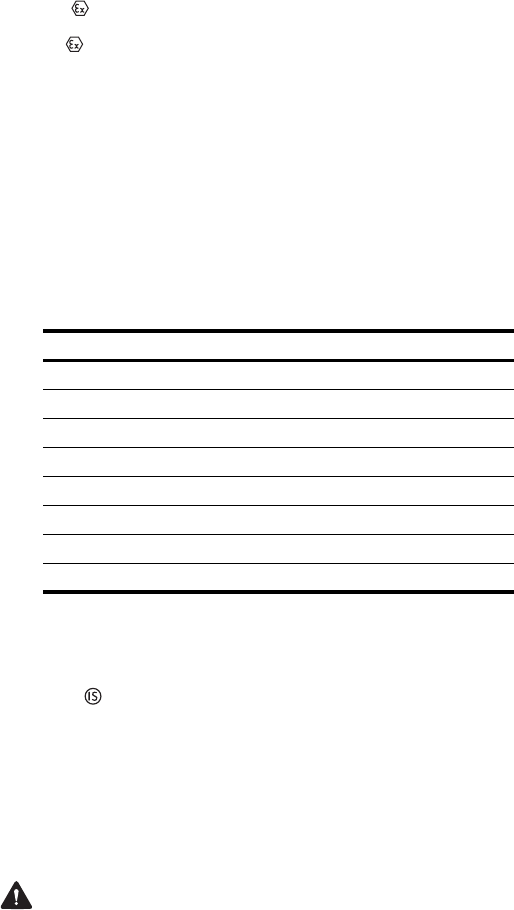
For your safety 11
■
II 2 G Ex ib IIC T4...T3 Gb (ATEX)
■
II 2 G Ex ib IIA T4...T3 Gb (ATEX)
■
Ex ib IIC T4...T3 Gb (IECEx)
■
Ex ib IIA T4...T3 Gb (IECEx)
T4: –20°C
≤
Ta
≤
+50 °C
T3: –20°C
≤
Ta
≤
+60 °C
Batteries
The following batteries have been approved for use with
TP9300/ TP9400 IS/NI portable radios.
Refer also to
"Rating matching" on page 14
.
Chargers
Chargers are common to IS and NI batteries. The
chargers for IS/NI batteries are marked with an IS circle
logo and have the following product code:
■
T03-22011-xAxx (AEx and Canada)
■
T03-22011-xDxx (IECEx and EU)
You must use these chargers with an IS/NI battery, as
their internal circuitry provides additional protection for the
IS circuitry in the battery and radio.
Warning Explosion hazard!
Do not use the charger in
a hazardous location. An explosion could cause serious
injury or death.
Description Product code
Li-Ion, 2300 mAh, AEx-USA, IIA T03-22001-AAAA
Li-Ion, 2300 mAh, AEx-USA, IIC T03-22001-AACA
Li-Ion, 2300 mAh, ATEX, IIA T03-22001-ABAA
Li-Ion, 2300 mAh, ATEX, IIC T03-22001-ABCA
Li-Ion, 2300 mAh, IECEx, IIA T03-22001-ADAA
Li-Ion, 2300 mAh, IECEx, IIC T03-22001-ADCA
Li-Ion, 2300 mAh, Ex-Canada, IIA T03-22001-AEAA
Li-Ion, 2300 mAh, Ex-Canada, IIC T03-22001-AECA
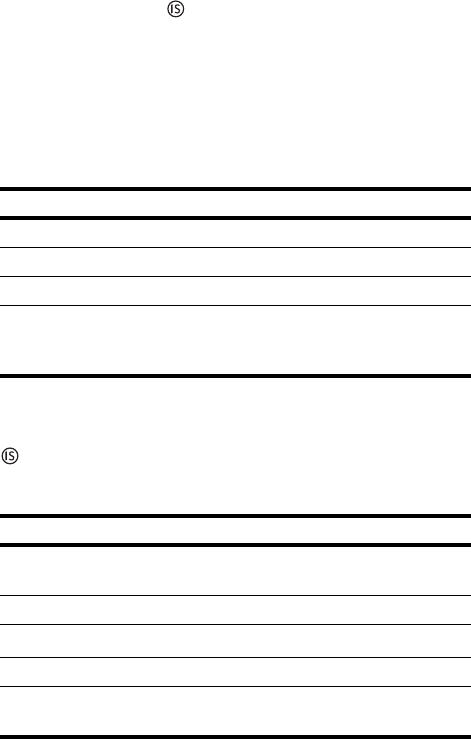
12 For your safety
Notice
The IS/NI battery can only be charged in the
chargers listed above. It will not charge in other TP8100/
TP9300/TP9400 chargers. However, the chargers listed
above can charge non-IS TP8100/TP9300/TP9400
batteries.
The operating temperature range for the charger is +32 °F
to +104 °F (0 °C to +40 °C).
Audio accessories
One or more of the following marks identifies a TP9300/
TP9400 audio accessory as an IS/NI audio accessory:
■
an IS circle logo on the audio accessory
■
a label on the audio accessory, showing IS/NI infor-
mation
The following audio accessories have been approved for
use with TP9300/ TP9400 IS/NI portable radios.
Refer
also to
"Rating matching" on page 14
.
Carry cases
IS/NI leather carry cases are marked with an IS circle logo
. The following carry cases have been approved for use
with TP9300/TP9400 IS/NI portable radios.
Description Product code
Headset, Heavy Duty, over-the-head T03-22008-BAAA
Headset, Heavy Duty, behind-the-head T03-22008-BABA
Earphone, in-ear, 2.5 mm jack T03-22008-CAAA
Speaker microphone, Storm, IP68-rated,
emergency button, High/Low volume button,
2.5 mm jack
T03-22008-AAAA
Description Product code
Carry case, heavy-duty, leather, belt loop with
D-stud
T03-22007-0001
Carry case, heavy-duty, leather, spring clip T03-22007-0002
Carry case, heavy-duty, leather, belt loop T03-22007-0003
1
Battery carry case, heavy-duty, leather T03-22007-0004
Battery carry case, heavy-duty, leather, belt
loop with D-stud
T03-22007-0005
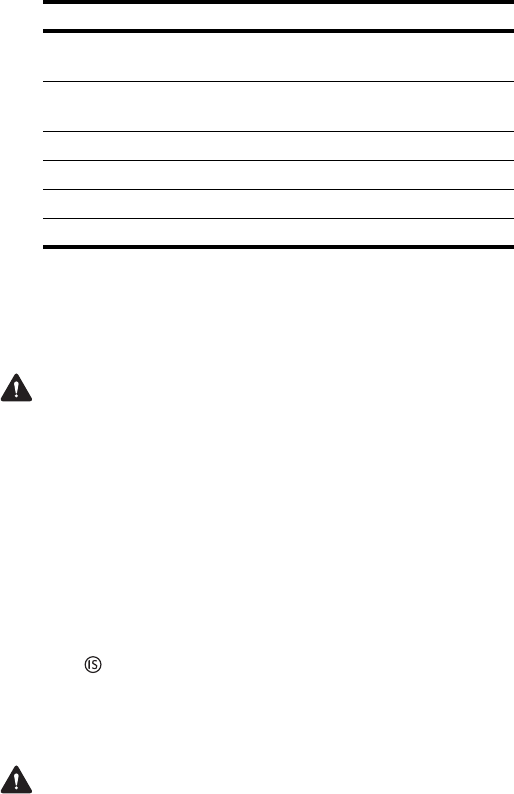
For your safety 13
Carry accessories are not specifically rated, and may be
used in any area, subject to the rating restrictions of the
overall radio system.
Warning Explosion hazard!
You must use a battery
carry case when carrying a spare battery into a hazardous
area.
Antenna
Use only genuine Tait-supplied antennas. Antennas are
not specifically rated and may be used in any area,
subject to the rating restrictions of the overall radio
system.
Programming adapter
The IS programming adapter is marked with an IS circle
logo and has the product code:
■
T03-22009-AAAA (AEx and Canada)
■
T03-22009-ADAA (IECEx and EU)
Warning Explosion hazard!
Do not use the IS
programming adapter in a hazardous location.
You must use the IS programming adapter with an IS/NI
radio, as its internal circuitry provides additional protection
for the IS/NI circuitry in the radio. All programming
activities are permitted. Calibration activities are only
permitted if the activity can be done with the programming
adapter alone. Other connections (e.g. antenna port) are
not permitted.
Battery carry case, heavy-duty, leather,
spring clip
T03-22007-0006
Battery carry case, heavy-duty, leather, belt
loop
T03-22007-0007
Belt loop for D-stud, 55 mm T03-00038-0022
Spring clip for D-stud, 40 mm T03-00038-0023
Belt clip, 55 mm TPA-CA-201
Belt clip adaptor for 55 mm belt clip TPA-CA-208
1. Must not be used with H7 band radios with whip antenna (TPA-AN-012).
Description Product code

14 For your safety
Equipment repair
Warning Explosion hazard!
IS/NI radios and
accessories are not user-serviceable. IS and NI radios
and accessories must be serviced only by an agency
certified by both the approval authority and by Tait Limited.
Any unauthorized repair or substitution of parts invalidates
the intrinsic safety or non-incendive rating and the third
party IS or NI approval. To have an IS and NI radio
serviced, return it to your regional Tait office.
Rating matching
The rating of the radio, battery and accessories must be
reviewed to ensure a safe IS/NI radio system. IS/NI
ratings must be “matched”, and the lowest approval level
determines the overall IS/NI radio system approval.
Equipment labels clearly identify the item’s ratings.
Zone ratings
■
Use only Gas Group IIC batteries with Gas Group IIC
radios.
Use only Gas Group IIA batteries with Gas Group IIA
radios.
■
Gas Group IIC rated accessories may be used with
IIA radios, but the combination may only be used in a
IIA Gas atmosphere.
■
Gas Group IIC and Dust Group IIIC rated accessories
may be used with Gas Group IIC or IIA radios, but the
combination may only be used in a gas atmosphere.
■
Gas Group IIC rated radios and accessories may be
used in Gas Group IIB or IIA areas.
■
Zone 1 rated radios and accessories may be used in
Zone 2 areas.
■
Any item approved to Gas Group IIA will limit the
radio system to a Gas Group IIA area. For use in a
Gas Group IIC area, all items must be approved to
Gas Group IIC.
For your safety 15
Division ratings
■
Use only Group D battery with Group D radios.
Use only Group A, B, C, D battery with Group A, B, C, D
radios.
■
Gas Class I and Dust Class II and Class III rated
accessories may be used with Gas Class I radios, but
the combination may only be used in a Gas Class I
hazardous (classified) location.
■
Division 2 rated radios and accessories may only be
used in Division 2 or Zone 2 hazardous (classified)
locations.
■
Division 2, Group A radios and accessories may be
used in Division 2, Group B, C, or D areas.
■
Any item approved to Group D will limit the radio sys-
tem to Group D areas. For use in a Group A area, all
items must be approved to Group A.
Temperature class
Different ambient temperature ranges apply for the T3
and T4 temperature classes. The item with the most
restrictive temperature range will determine the allowed
temperature range of the radio system. T4-rated radios
and accessories can be used in T3 areas, within the rules
stated above.
16 For your safety
Entity parameters
The Entity Concept allows interconnection of IS/NI
equipment with associated equipment when the following
is true:
Ui
≥
Uo, Ii
≥
Io, Pi
≥
Po, Ci
≤
Co, Li
≤
Lo, and Li/Ri
≤
Lo/Ro.
The installation must be in accordance with the following
standards:
■
National Electrical Code (NEC), ANSI/NFPA 70, Arti-
cles 504 and 505
■
Canadian Electrical Code (CEC) Part I, CAS C22.1
■
ANSI/ISA-RP12.06.01
■
EN/IEC 60079-25
■
relevant local regulations.
TP9300/TP9400 IS/NI radios have the following entity
parameters.
Radio accessory port:
Radio battery port:
■
Uo 7.2 V
■
Io 0.42 A
■
Po 1.3 W
■
Co 1.97
μ
F
■
Lo 100
μ
H
■
Lo/Ro 20
μ
H/
Ω
■
Ui 8.4 V
■
Ii IIA: 2.9 A
IIC: 1.9 A
■
Um 9.0 V (charging)
■
Ci 1.2
μ
F
■
Li 5.7
μ
H
For your safety 17
Battery:
Ambient pollution degree: 4
Overvoltage category: I
Certificates
Standards
Charging Terminals
■
Um 9.0 V
Battery Output (radio port)
■
Uo 8.4 V
■
Io IIA: 2.9 A
IIC: 1.9 A
■
Co 1.2
μ
F
■
Lo 5.7
μ
H
Radio: Battery:
■
MET E113958
■
TÜV 15 ATEX 7792X
■
TÜV 15 ATEX 7791X
■
IECEx ITA 15.0015X
■
IECEx ITA 15.0009X
■
ANSI/ISA-12.12.01-2015
■
CAN/CSA-C22.2 No. 213-15
■
ANSI/UL 60079-0
■
ANSI/UL 60079-11
■
CAN/CSA-C22.2 No. 60079-11:14
■
CAN/CSA-C22.2 No. 60079-0:15
■
EN 60079-0:2012/A11:2013
■
EN 60079-11:2012
■
IEC 60079-0:2011 6th edition
■
IEC 60079-11:2011 6th edition

18 For your safety
Radio frequency exposure information
For your own safety and to ensure you comply with the
radio frequency (RF) exposure guidelines of the United
States Federal Communication Commission’s (FCC),
Industry Canada, and those from other administrations,
please read the following information before using this
radio.
Using this radio
You should use this radio only for work-related purposes
(it is not authorized for any other use) and if you are fully
aware of, and can exercise control over, your exposure to
RF energy. To prevent exceeding FCC RF exposure
limits, you must control the amount and duration of RF
that you and other people are exposed to.
It is also important that you:
■
Do not remove the RF Exposure label from the radio.
■
Ensure this RF exposure information accompanies
the radio when it is transferred to other users.
■
Do not use the radio if you do not adhere to the guide-
lines on controlling your exposure to RF.
Controlling your exposure to RF energy
This radio emits radio frequency (RF) energy or radio
waves primarily when calls are made. RF is a form of
electromagnetic energy (as is sunlight), and there are
recommended levels of maximum RF exposure.
To control your exposure to RF and comply with the
maximum exposure limits for occupational/controlled
environments, follow these guidelines:
■
Do not talk (transmit) on the radio more than the rated
transmit duty cycle. This is important because the
radio radiates more energy when it is transmitting
than when it is receiving.
■
When listening and talking on the radio, hold it upright
in front of your face so that it is at least one inch
(2.5 cm) away from any part of your face. Keeping the
radio at the recommended distance is important
For your safety 19
because exposure to RF decreases rapidly the further
away the antenna is from your body.
■
Keep the antenna at least one inch (2.5 cm) from your
face at all times.
■
If you wear your radio, you must always put it in a car-
rying accessory that has been specifically approved
by Tait for this radio. Using non-approved body-worn
accessories may mean you expose yourself to higher
levels of RF than recommended by the FCC’s occu-
pational/controlled environment RF exposure limits.
■
Ensure you only use Tait-approved antennas, batter-
ies, and accessories.
For more information on what RF energy is and how to
control your exposure to it, visit the FCC website at
www.fcc.gov/oet/rfsafety/rf-faqs.html
.
Compliance with RF energy exposure standards
This two-way radio complies with these RF energy
exposure standards and guidelines:
■
United States Federal Communications Commission,
Code of Federal Regulations; 47 CFR §§ 1.1307,
1.1310, and 2.1093.
■
American National Standards Institute (ANSI) / Insti-
tute of Electrical and Electronic Engineers
(IEEE) C95.1-1992.
■
Institute of Electrical and Electronic Engineers (IEEE)
C95.1-1999 Edition.
■
European Directive 2004/40/EC on minimum health
and safety requirements regarding the exposure of
workers to the risks arising from physical agents
(electromagnetic fields).
This radio complies with the IEEE and ICNIRP exposure
limits for occupational/controlled RF exposure
environments at operating duty factors of up to 50% talk
to 50% listen.
20 For your safety
Conformité aux normes d’exposition à l’énergie
RF
Cette radio émetteur-récepteur se conforme aux normes
et aux règlements d’exposition à l’énergie RF :
■
La Commission fédérale de la communication des
Etats-Unis, Code de règlements fédéraux (CFR) Titre
47 Sections 1.1307, 1.1310 et 2.1091 (radios mobi-
les) ou 2.1093 (radios portatives).
■
American National Standards Institute (ANSI) / Insti-
tute of Electrical and Electronic Engineers (IEEE)
C95. 1-1992.
■
Institute of Electrical and Electronic Engineers (IEEE)
C95.1-1999 Edition.
■
La directive européenne 2004/40/EC concernant les
prescriptions minimales de sécurité et de santé relati-
ves à l'exposition des travailleurs aux risques dus aux
agents physiques (champs électromagnétiques).
Cette radio se conforme aux limites d’exposition de l’IEEE
(FCC) et ICNIRP pour les environnements d’exposition
au rayonnement RF professionnel et contrôlé aux cycles
de marche de 50% en mode transmission et 50% en
mode réception.
Radio frequency emissions limits in
the USA
CFR Title 47 Part 15.19 (a) (1) - Receivers
Part 15 of the FCC Rules imposes RF emission limits on
receivers. This radio complies with Part 15 of the FCC
Rules. Operation is subject to the condition that this
device does not cause harmful interference.
CFR Title 47 Part 15.19 (a) (3) - All other devices
This device complies with Part 15 of the FCC Rules.
Operation is subject to the following two conditions.
(1) This device may not cause harmful interference, and
(2) This device must accept any interference received,
including interference that may cause undesired
operation.
For your safety 21
Radio frequency emissions limits in
Canada
This device complies with Industry Canada licence
exempt RSS standard(s). Operation is subject to the
following two conditions: (1) this device may not cause
interference, and (2) this device must accept any
interference, including interference that may cause
undesired operation of the device.
Le présent appareil est conforme aux CNR d'Industrie
Canada applicables aux appareils radio exempts de
licence. L'exploitation est autorisée aux deux conditions
suivantes : (1) l'appareil ne doit pas produire de
brouillage, et (2) l'utilisateur de l'appareil doit accepter tout
brouillage radioélectrique subi, même si le brouillage est
susceptible d'en compromettre le fonctionnement.
USA public safety bands
(764 –776 MHz and 794 – 806 MHz)
The Code of Federal Regulations (CFR) Title 47
Subpart R deals with the use of frequencies in the 764 to
776 MHz and 794 to 806 MHz bands.
Low-power channels
This radio complies with § 90.531 (b) (3) and
§ 90.531 (b) (4) of 47 CFR. These sections state that only
low-power transmission is permitted on the
following channels:
■
Regional Planning channels, as defined in
§ 90.531 (b) (3).
■
Itinerant channels, as defined in § 90.531 (b) (4).
Use of encryption
This radio complies with § 90.553 (a) of 47 CFR. This
states that:
■
Encryption is not permitted on the nationwide Interop-
erability calling channels. These channels are defined
in § 90.531 (b) (1) (ii).

22 For your safety
■
Radios using encryption must have a readily accessi-
ble switch or control to allow the radio user to
disable encryption.
EMC regulatory compliance in
Australia
This product meets all ACMA regulatory requirements for
electromagnetic compatibility (EMC). For more
information about EMC compliance, visit the ACMA
website at
www.acma.gov.au
.
Frequency band reserved for
distress beacons
Frequency band 406 to 406.1 MHz is reserved for use by
distress beacons. Transmissions should not be made
within this frequency band.
Health, safety and electromagnetic
compatibility in Europe
In the European Community, radio and
telecommunications equipment is regulated by Directive
1999/5/EC, also known as the Radio and
Telecommunications Terminal Equipment (R&TTE)
directive. The requirements of this directive include
protection of health and safety of users, as well as
electromagnetic compatibility.
Intended purpose of product
This product is an FM radio transceiver. It is intended for
radiocommunication in the Private Mobile Radio (PMR) or
Public Access Mobile Radio (PAMR) services, to be used
in all member states of the European Union (EU) and
states within the European Economic Area (EEA).

For your safety 23
Restrictions
This product can be programmed to transmit on
frequencies that are not harmonized throughout the EU/
EEA, and will require a licence to operate in each member
state.
This product can be programmed for frequencies or
emissions that may make its use illegal. Where
applicable, a license must be obtained before this product
is used. All license requirements must be observed.
Limitations may apply to transmitter power, operating
frequency, channel spacing, and emission.
Declaration of conformity
Brief Declarations of Conformity appear on
page 172
of
this booklet. To download the formal declaration of
conformity, go to
www.taitradio.com/eudoc
.
Interference with electronic devices
Warning
Some electronic devices may be prone to
malfunction due to the lack of protection from RF energy
that is present when your radio is transmitting.
Examples of electronic devices that may be affected by
RF energy are:
■
aircraft electronic systems
■
vehicular electronic systems such as fuel injection,
anti-skid brakes, and cruise control
■
medical devices such as pacemakers and hearing
aids
■
medical equipment in hospitals or health care facili-
ties.
Switch off the radio before boarding an aircraft. Using your
radio while in the air is not permitted.
Consult the manufacturer (or its representative) of any
such electronic devices to determine whether electronic
circuits in those devices will perform normally when the
radio is transmitting.

24 For your safety
Warning
If you have a pacemaker:
■
immediately turn off the radio if you suspect it is inter-
fering with the pacemaker
■
keep the radio at least 6 inches (15 cm) from the
pacemaker while the radio is on
■
use the radio on the side opposite to the pacemaker
to minimize interference
■
never carry the radio in a breast pocket.
If there is interference between your hearing aid and the
radio, please discuss an alternative solution with the
hearing aid manufacturer.
Potentially explosive atmospheres and
blasting areas
Warning
Unless the radio is specifically certified for use
in a potentially explosive atmosphere, turn off the radio
before entering such an atmosphere. An explosion could
cause serious injury or death. Examples of potentially
explosive atmospheres include filling stations, and any
environment where there are flammable liquids, gases, or
dusts.
Warning
Turn off the radio before approaching blasting
caps, a blasting area, or any area where you are
instructed to turn off a two-way radio. Obey all signs and
instructions. Interference with blasting operations could
cause serious injury or death.
Radio installation and operation in
vehicles
Warning
Keep the radio away from airbags and airbag
deployment areas. Do not install, charge, or place a radio
near such areas. An activated airbag can propel a
portable radio with sufficient force to cause serious injury
to vehicle occupants. An airbag may not perform to
specification if obstructed by a radio.
Warning
To avoid damage to existing wiring, airbags,
fuel tanks, fuel and brake lines, or battery cables, refer to

For your safety 25
the installation guide for the radio, and to the vehicle
manufacturer’s manual, before installing electronic
equipment in the vehicle.
Using a handheld microphone or a radio while driving a
vehicle may violate the laws and legislation that apply in
your country or state. Please check the vehicle
regulations in your area.
Vehicle charger installation and
operation
For detailed instructions necessary to the safe installation
and operation of the vehicle charger, please refer to the
documentation supplied with the vehicle charger.
Multicharger safety information
Warning
This device must be connected to an earthed
mains socket-outlet.
Norsk (no): Apparatet må tilkoples jordet stikkontakt.
Suomi (fi): Laite on liitettävä suojamaadoituskoskettimilla
varustettuun pistorasiaan.
Svenska (sv): Apparaten skall anslutas till jordat uttag.
Electromagnetic compatibility in
European vehicles
In the European Community, radio equipment fitted to
automotive vehicles is regulated by Directive 72/245/EEC
and its amendments. The requirements of this directive
cover the electromagnetic compatibility of electrical or
electronic equipment fitted to automotive vehicles.

26 For your safety
Unapproved modifications or changes
to radio
The radio is designed to satisfy the applicable compliance
regulations. Do not make modifications or changes to the
radio that are not expressly approved by Tait. Failure to
do so could invalidate compliance requirements and void
the user’s authority to operate the radio.
Engraving and modification of intrinsically
safe radios
Warning
Intrinsically Safe (IS) and non-incendive (NI)
radios and batteries must not be engraved or modified in
any way. For more information on IS and NI radios refer to
"Intrinsically Safe and Non-Incendive radios and
accessories" on page 9
.
Attaching of labels
Warning
Do not obstruct the vent hole on the battery or
the vent hole on the radio chassis label. If the vent on the
battery is obstructed, the battery may explode, causing
personal injury and/or damage to property. If the vent on
the radio is obstructed, audio quality and/or key function
may deteriorate and radio seals may be damaged.
Caution
Tait recommends that you do not affix additional
labels to the surfaces between the radio chassis and the
battery. The fit between these surfaces is intentionally firm
and any added thickness will damage the points of
attachment between radio and battery. If you must attach
a customized label, use only a thin gummed paper label
applied to the bottom 25% of the radio chassis label and/
or to the top 25% of the battery label. Do not obstruct the
vent holes (see Warning above). Do not allow the paper
label to extend beyond the recessed label area or to
conceal relevant product information.
Use of lithium-ion batteries
Warning
A damaged battery can cause an explosion or
fire, and can result in personal injury and/or property
damage. To prevent personal injury and/or damage to
property, read the important safety information supplied
with the battery.

For your safety 27
Short-circuiting battery contacts
Warning
Do not short-circuit the battery contacts,
neither intentionally nor accidentally, e.g. by placing the
battery with conductive materials such as keys or jewelry
inside a pocket or container. Short-circuiting the battery
contacts can heat up the conductive material and cause
personal injury and/or damage to property.
28 Menu maps
Menu maps
This section shows the menus and submenus that may be
programmed for your radio. Some features are controlled by
software licenses and may not be available with your model.
Main menu (conventional mode)
Channels
Zones
Address book
Personal
Standard
Individual call
Phone call
Local calls
Set status
Dial radio call
Dial patch call
Services
Text message
Status update
Call alert
Radio check
Radio monitor
Radio inhibit
Radio uninhibit
Talkgroups
Wireless headset
Connect
Reconnect last
Disconnect
Connection info
Manage headsets
Find new devices
Options
Power-on option
Confirm connect
Radio settings
Functions
Scrambler
Lock radio
Low power tx
Monitor
Squelch o’ride
VOX
VOX sensitivity
Repeater
Talkaround
Voice annunciation
Call settings
Ignore 2-tone
Extra features
Lone worker
Alert settings
Indicator level
Keypress tones
Quiet operation
Silent operation
Display settings
Backlighting
Contrast adjust
Talk party ID
RSSI
Radio info
Radio ID
Key settings
Version info
Customer info
Serial number
Advanced
Program groups
Location Svs
Own location
Security
Encryption
Zeroize key
Zeroize all keys
Change mode
Diagnostics
Time and Date
Unify Apps
Menu maps 29
Main menu (trunked mode)
Preset calls
Address book
Personal
Standard
Set zone
Set workgroup
Go to homegroup
Scanning
Send
Status
Text message
Dispatcher call
Broadcast call
Conference call
Priority call
Emergency call
Wireless headset
Connect
Reconnect last
Disconnect
Connection info
Manage headsets
Find new devices
Options
Power-on option
Auto-connect
Workgroup setup*
My Workgroups**
Set homegroup
Subscribe all
Unsubscribe all
Radio settings
Functions
Scrambler
Lock radio
VOX
VOX sensitivity
Voice annunciation
Call settings
Call queuing
Do not disturb
Extra features
Lone worker
Alert settings
Indicator level
Keypress tones
Quiet operation
Silent operation
Display settings
Backlighting
Contrast adjust
Channel display
RSSI
Radio info
Trunked ID
Key settings
Version info
Customer info
Serial number
Alias
Call groups
Own location
Security
Encryption
Zeroize key
Zeroize all
Change network
Change mode
Diagnostics
Time and Date
Unify Apps
* This menu item may appear as
‘Group select’
** This menu item may appear as
‘Edit groups’.
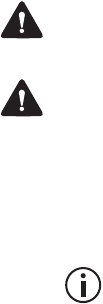
30 About this guide
1 About this guide
This user’s guide provides information about all
TP9300 portable radios, except the TP9310 (without
display and keypad).
The radio behavior described in this guide applies to
radios with firmware version 2.15. To check the
radio’s firmware version, see "Viewing radio
information" on page 170. If your radio does not
operate as you expect, contact your radio provider for
assistance.
Safety warnings used in this
guide
Please follow exactly any instruction that appears in
the text as an ‘alert’. An alert provides necessary
safety information as well as instruction in the proper
use of the product. This user’s guide uses the
following types of alert:
Warning This alert is used when there is a hazardous
situation which, if not avoided, could result in death or
serious injury.
Caution This alert is used when there is a hazardous
situation which, if not avoided, could result in minor or
moderate injury.
Notice This alert is used to highlight information that
is required to ensure procedures are performed
correctly. Incorrectly performed procedures could
result in equipment damage or malfunction.
This icon is used to draw your attention to
information that may improve your
understanding of the equipment or procedure.
About this guide 31
Related documentation
The following documentation is also available for your
Tait radio, which you can access from the Tait
Technical Support website (http://
support.taitradio.com):
■Safety and Compliance Information—supplied
with each radio. (The same information is included
in this user’s guide.)
■Li-ion Battery Safety Information—supplied with
each Li-ion battery.
■Battery Care and Charging Guide—supplied with
each charger. (The same information is in the sec-
tion "Charging and caring for batteries" on
page 156.)

32 Before using your radio
2 Before using your radio
Once you have unpacked your radio, there are a few
tasks you must do before you can use it. The most
important of these is to charge your battery for the first
time .
Warning Use only a Tait-supplied, IS and
NI-approved battery, charger, antenna, audio
accessory, carry accessory or programming adapter
with an IS and NI radio. Fitting a battery or accessory
that is not IS and NI-approved, using a charger that is
not IS and NI-approved, or failing to use the IS and NI
programming adapter, creates a risk of explosion
which could cause serious injury or death. For an up-
to-date list of approved accessories, contact your
regional Tait office. For detailed information about IS
and NI radios and how to identify them, see
"Intrinsically Safe and Non-Incendive radios and
accessories" on page 9.
Warning Do not charge the battery or change the
antenna in a hazardous location. An explosion could
cause serious injury or death.
This section covers:
■For your safety — battery warning
■Attaching labels to the radio or battery
■Charging the battery before first use
■Attaching the battery
■Removing the battery
■Attaching the antenna
■Removing the antenna
■Attaching a belt clip
■Removing a belt clip
■Installing an audio accessory

Before using your radio 33
For your safety — battery
warning
Warning This radio uses a Lithium-ion battery. If the
battery is damaged or handled in an unsafe manner, it
can cause personal injury and/or damage to property.
Read the important safety information included with
your battery.
Attaching labels to the radio or
battery
Warning Do not cover the battery vent hole or the
vent hole on the radio chassis. If the vent on the
battery is obstructed, the battery may explode,
causing personal injury and/or damage to property. If
the vent on the radio is obstructed, audio quality and/
or key function may deteriorate and radio seals may
be damaged.
Notice Tait recommends that you do not affix
additional labels to the surfaces between the radio
chassis and the battery. The fit between these
surfaces is intentionally firm and any added thickness
will damage the points of attachment between radio
and battery.
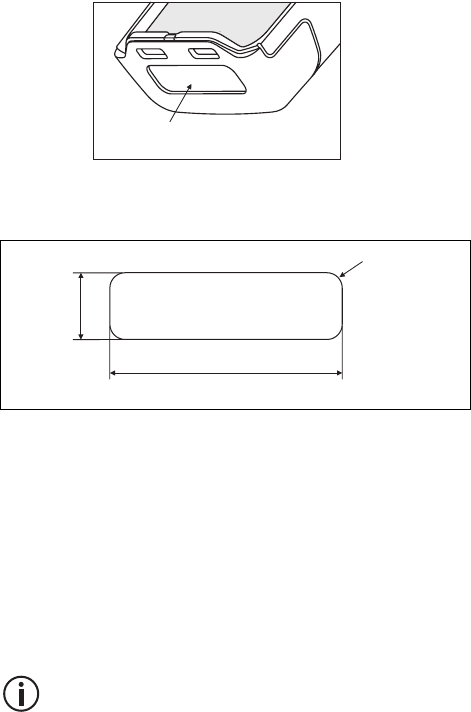
34 Before using your radio
Attaching a label to the front panel
If a customer requires an additional label, attach the
label in the spare label recess in the bottom edge of
the radio front panel. In this position, the label is still
visible while the battery is attached to the radio.
The diagram below shows the specified dimensions of
the label.
Charging the battery before first
use
Before using your battery for the first time, you must
charge it. Follow the instructions included with your
Tait charger. This information is repeated in the
section "Charging and caring for batteries" on
page 156.
For best charging performance, switch off the
radio before placing it in the charger.
spare label recess
R0.02 in
(0.5 mm)
maximum label thickness: 0.03 in (0.8 mm)
0.28 in
(7 mm)
1.22 in (31 mm)

Before using your radio 35
Attaching the battery
Warning Use only a Tait-supplied, IS and
NI-approved battery with an IS and NI radio.
Notice Fit the bottom edge of the battery to the radio,
then the top edge. Attempting to fit the top edge first
may damage the contacts.
1Rotate the power/volume control switch
counterclockwise to turn off the radio.
If the battery has been attached while the radio
is turned on, turn the radio off and then on again
before use.
2Holding the radio firmly, align the back of the
battery with the back of the chassis.
3Place the two lugs at the bottom edge of the
battery into the two slots in the bottom of the front
panel.
4Lightly press the top of the battery towards the
radio until the battery catch clicks.
5Make sure that the battery is firmly in position.
Removing the battery
The battery is secured to the radio by a battery catch
in the radio’s rear panel.
To remove the battery from the radio, so that the
battery can be charged or replaced:
1Rotate the power/volume control switch
counterclockwise to turn off the radio.
If the battery has been removed while the radio
is turned on, turn the radio off and then on again
before use.
2Slide the battery catch up.
3From the sides, pull the battery away from the
radio.

36 Before using your radio
Attaching the antenna
Before using the radio, screw the antenna clockwise
into the antenna connector. The antenna should be
screwed sufficiently tight so that it doesn’t unscrew
easily. This is important as it creates a seal.
Removing the antenna
Warning Do not change the antenna in a hazardous
location. An explosion could cause serious injury or
death.
Use a firm grip and turn the antenna counterclockwise
half a turn. Use a lighter grip to fully unscrew the
antenna, and carefully remove it.
Attaching a belt clip
To attach a belt clip to the radio:
1Slide the belt clip into the two grooves at the top of
the battery.
2Press down on the belt clip until it snaps into place.
Removing a belt clip
The belt clip has been designed to prevent accidental
removal, but you can take it off, if required.
To remove a belt clip from a battery:
1Insert a flat screwdriver blade or similar flat object
under the lip of the release lock (that is, between it
and the metal slider).
2Lift the release lock up (away from the metal slider)
and hold it in position.
3Slide the belt clip out.

Before using your radio 37
Installing an audio accessory
Warning Use only Tait-supplied, IS and NI-approved
audio accessories with IS and NI radios. Fitting an
audio accessory that is not IS-approved exposes the
customer to a risk of explosion which could cause
serious injury or death. For an up-to-date list of
approved audio accessories, contact your regional
Tait office. For detailed information about IS and NI
radios and how to identify them, see "Intrinsically Safe
and Non-Incendive radios and accessories" on
page 9.
Audio accessories plug into the radio’s accessory
connector. The accessory connector is protected by a
cover, which needs to be removed before an
accessory can be installed.
Notice The accessory cover protects the accessory
connector from electrostatic discharge. Keep the
cover in place unless the connector is in use.
To remove the accessory cover and install an audio
accessory:
1Use a coin or other blunt object to loosen the screw
that secures the accessory cover to the radio.
2Remove the accessory cover and store it in a safe
place.
3Plug the accessory into the accessory connector.
4Tighten the screw.
38 Getting started
3 Getting started
This section gives an overview of your DMR radio,
describes the radio’s controls and indicators, and
explains how the radio menus are organized.
This section covers:
■About your DMR digital radio
■About the radio controls
■Understanding the radio display
■Understanding the radio indicators
■Using function keys to access frequently used fea-
tures
■Navigating the radio’s menus
■Using the alphanumeric keys to search a list

Getting started 39
About your DMR digital radio
Your DMR digital radio can be programmed for DMR
conventional or DMR trunked operation. Analog
conventional and MPT operation is also available.
DMR and MPT trunking operation is controlled
by a software license (SFE) and may not be
available with your radio.
In DMR and MPT trunking operation, dual-mode
networks are able to receive both digital and analog
calls.
You may notice differences between digital and
analog calls in terms of:
■static noise in low signal areas, and
■radio coverage in marginal reception areas.
Lack of static noise
On digital networks there is no static noise, even in
low signal areas. This lack of static is because your
digital radio removes the ‘noise’ from the call, so that
you hear only clear voice.
Coverage
With digital networks, a call remains clear and then
drops off quickly at the border of a coverage area. The
reason for this is that a digital call is either received or
it isn't. With analog networks, the background noise in
a call gets progressively worse when you are in fringe
areas or even slightly outside normal coverage areas.
40 Getting started
What you hear on an analog channel
On analog channels, your radio may be programmed
so that you hear all conversations on a channel, or
your user group may be segregated from other user
groups by using special signaling. The special
signaling is used to control the muting and unmuting
of your radio, so that your radio is muted when other
user groups are talking and unmuted for members of
your user group.
There are two muting controls that operate in your
radio:
■signaling mute
■squelch
Signaling mute
The radio’s signaling mute only allows the radio to
unmute if the incoming call carries the tones specific
to your user group. Your user group may use tones
that are either audible, subaudible or both.
Squelch
The radio’s squelch allows the radio to unmute only
when the strength of the incoming signal is above a
predetermined threshold. This means that only
signals of reasonable intelligibility are made audible.
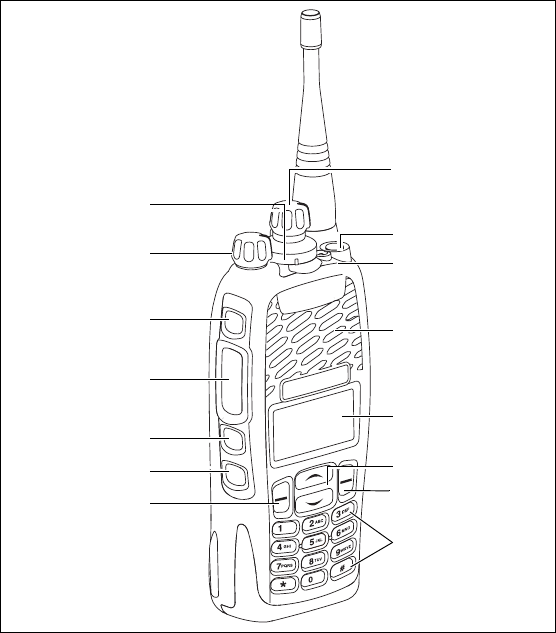
Getting started 41
About the radio controls
The radio controls are the PTT key, power/volume
control, channel selector, 3-way selector control
(optional), scroll keys, selection keys, and function
keys. Some keys have functions assigned to both
short and long key presses:
■a short key press is less than one second, and
■a long key press is more than one second.
The radio controls and their functions are described in
the following sections.
display
PTT key
(press-to-talk)
scroll keys
alphanumeric
keys
speaker /
microphone
power / volume
control
channel selector
status LED
right selection key
left selection key
function key 1
3-way selector
control (optional)
function key 2
function key 3
function key 4

42 Getting started
Name Function
PTT key Press and hold to transmit and release to
listen
Power/volume
control
Rotate to turn the radio on and change
the speaker volume
Channel
selector
Select and change channels
3-way selector
(optional)
Select frequently used features
Left and right
selection keys
Action determined by the text above the
selection key
Scroll keys Scroll up and down through a list of menu
options, scroll left and right in messages,
or access a pre-programmed menu
Function keys Programmed for frequently used options
Alphanumeric
keys
Used to enter letters and numbers
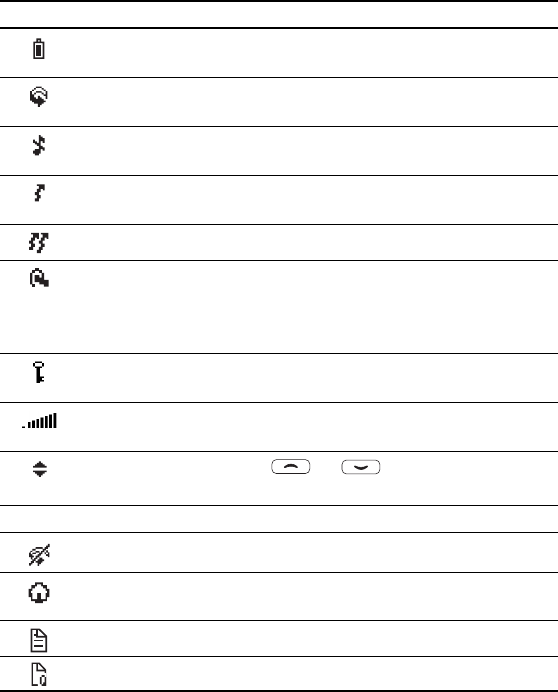
Getting started 43
Understanding the radio display
The messages and icons you see on your radio
display depend on the mode in which your radio is
operating and the way it is programmed.
Radio display icons
These are some of the icons you may see on your
radio display:
Icon Meaning
Battery indicator: shows how much charge is available in
the battery
Scanning: your radio is monitoring a group of channels or
workgroups for activity
Silent operation: your radio’s audible tones have been
turned off
Low-power transmit: your radio is set to transmit on low
power
Transmit: your radio is transmitting
Headset connected: there is a wireless headset connected
to your radio
Flashing: your radio is attempting to connect to a headset,
or the headset connection has been lost
Scrambler: the voice-inversion scrambler is turned on
(analog channels only)
Signal strength indicator: the more bars, the stronger the
signal being received by the radio
Scrolling: you can use or to move through a
list, or access a pre-programmed menu
Trunked mode icons
Scanning: scanning has been turned off
Homegroup: your radio has been returned to the
homegroup using the homegroup toggle function key
Call queuing: call queuing is turned on
Call queuing: there are calls in the call queue
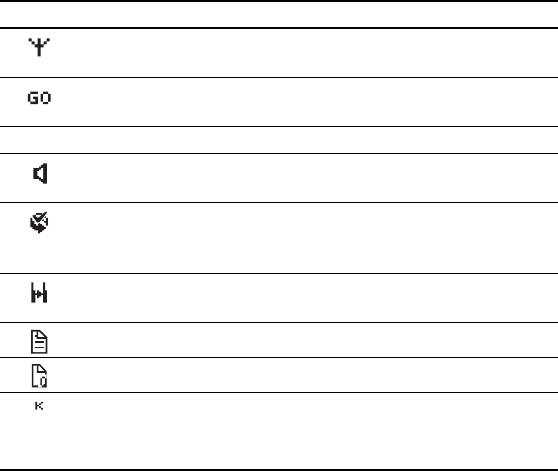
44 Getting started
Network (flashing): your radio is registered on a DMR or
MPT trunked network
Trunking: your radio has established a call and you are now
able to speak to the other party
Conventional mode icons
Monitor or squelch override: monitor or squelch override is
turned on
Scanning: your radio is monitoring a group of channels for
activity, and the currently selected channel is a member of
the scan group.
Repeater talkaround: your radio is operating in repeater
talkaround mode, or you are on a simplex channel
Text message: there is no text message in the call queue
Text message: there is a text message in the call queue
Zone: this letter represents the zone in which your radio is
operating, where A is zone 1, Z is zone 26 (for example, K
represents zone 11)
Icon Meaning
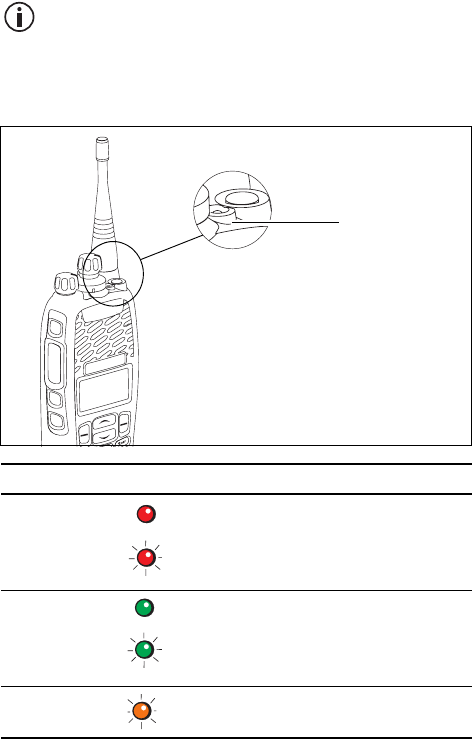
Getting started 45
Understanding the radio
indicators
The status LED indicator and the radio’s audible
tones—together with the radio display—all combine to
give you information about the state of your radio.
The most common way the indicators work is
described in the following sections.
The way these indicators behave may be
affected by the way your radio is programmed.
Status indicators
Color Meaning
Red
(transmit)
Glowing: your radio is transmitting
Flashing: your transmit timer is
about to expire
Green
(receive)
Glowing: the current channel is
busy
Flashing: you have received a call
(analog channel only)
Orange
(network)
Flashing: you are registered on a
trunked network
status LED
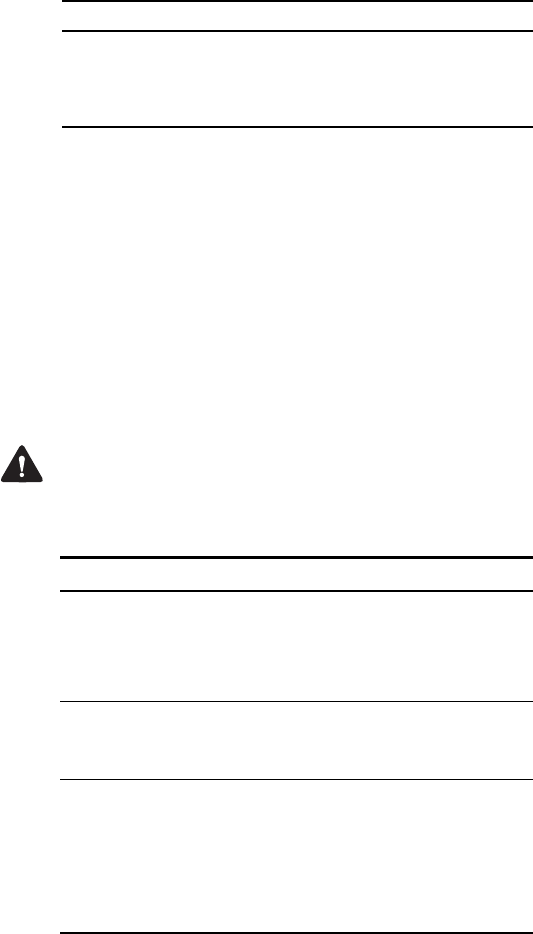
46 Getting started
Audible tones
The radio uses audible tones to alert you to its status:
■Radio controls and keypress tones—the tones
and beeps you hear when you press your radio’s
keys or use the controls.
■Incoming call tone—when the radio is receiving
a call.
■Warning tones—when there is an error, or the bat-
tery is low, for example.
Warning If quiet or silent mode is turned on, you will
not hear any alert tones.
Some of the more common audible tones are
described below:
All LEDs off Trunked: network not available, or
your radio is attempting to register
on a trunked network
Conventional: receive standby
Color Meaning
Tone Meaning
One short
beep
■Valid keypress: The action you have
attempted is permitted.
■Function activated: A function has
been turned on (using a function key).
One short,
low-pitched
beep
Function deactivated: A function has been
turned off (using a function key).
One long, low-
pitched beep
■Invalid keypress: The action you have
attempted is not permitted.
■Transmission inhibited: You have
attempted to transmit, but for some
reason you cannot make a call at
this time.

Getting started 47
Voice annunciation
In conventional mode, your radio may be programmed
to play a pre-recorded message for the start-up zone
and channel, and when changing the zone or channel.
Two short
beeps
■Radio turned on: The radio is powered
on and ready to use.
■Radio is revived: The radio has been
made operable by your service pro-
vider.
Three long
beeps
Transmit timeout imminent: Your transmit
timer will expire and your current
transmission will be terminated.
one short,
high-pitched
beep
Radio is stunned: The radio has been
made inoperable by your service provider.
two low-
pitched beeps
Radio’s temperature is high: The radio’s
temperature is in the high-temperature
range, but the radio will continue
to operate.
two high-
pitched beeps
Radio’s temperature is very high: The
radio’s temperature is in the very high
temperature range and all transmissions
will now be at low power; if the radio’s
temperature rises outside this range,
transmissions will be inhibited. Turn off
the radio and allow it to cool down.
Continuous
low-pitched
tone
Radio system error: A system error has
occurred and the radio may be inoperable.
Contact your radio provider.
two long high-
low pitched
tone pairs
Synthesizer is out-of-lock: The radio’s
synthesizer is out-of-lock on the current
channel and you cannot operate on that
channel (Out of lock appears on the
display).
Tone Meaning
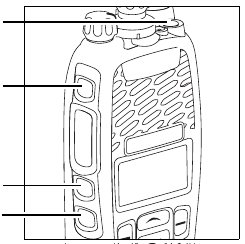
48 Getting started
In trunked mode, your radio may be programmed to
play a pre-recorded message for the start-up zone,
workgroup or preset, and when changing the zone,
workgroup or preset.
In both modes, your radio may be programmed to play
a pre-recorded message for the battery condition.
Using function keys to access
frequently used features
The function keys provide access to some of the
features you will use most often. These features are
assigned to the function keys when the radio is
programmed. Some keys may have a feature
associated with both a short key press and a long key
press.
Viewing the function key settings
Use the Main menu to check the features assigned to
your radio’s function keys:
1Press Menu and select Radio settings > Radio
info > Key settings.
2In the Key Settings menu, scroll through the list of
function keys.
3Press Select to view details of the function
associated with a particular function key.
function key 1
(emergency key)
function key 2
function key 3
function key 4
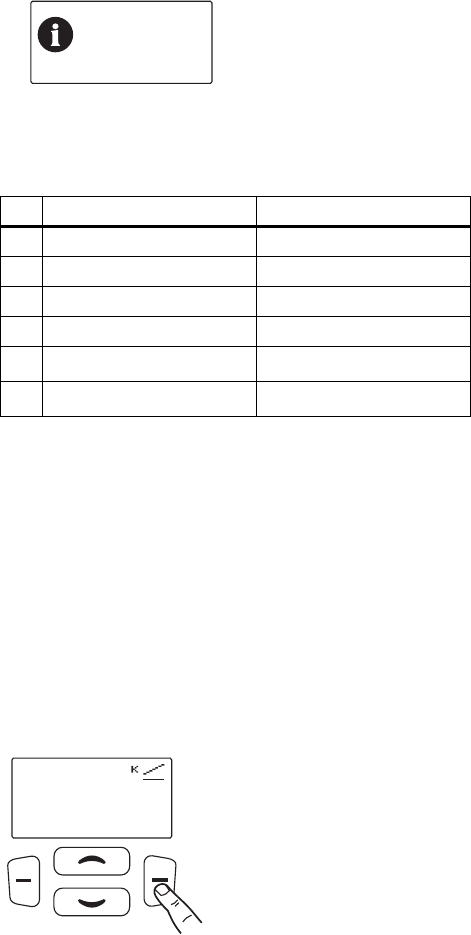
Getting started 49
The example shown is for a function key
programmed to turn backlighting on and off.
4Press Back to return to the Key Settings menu.
Use the following table to record the function keys
programmed for your radio:
For more information about the function keys that can
be programmed on your radio, contact your radio
provider.
Navigating the radio’s menus
Your radio has a number of menus, each containing
lists or submenus. The menus available depend on
the way your radio is programmed.
To access the Main menu, press the right selection
key whenever Menu appears above it.
Short key press Long key press
F1
F2
F3
F4
F51
1. On speaker microphone (if fitted)
F61
Backlighting
toggle
OKBack
Lock Menu
Channel 12
Zone 11

50 Getting started
Use the scroll keys to move through the menu list.
When the menu you want is highlighted, press Select
to open the menu you have chosen.
Your radio may be programmed to use the scroll keys
or the left selection key to directly access a menu.
To quickly exit the menu system, press and hold
the left selection key when the word Cancel or
Back appears above it.
Using the alphanumeric keys to
search a list
This feature is only available for radios with
alphanumeric keys.
If a blinking cursor appears when you select a list, you
are able to search for the menu item you want using
the alphanumeric keys. This is of particular benefit if
you have a large number of items in a list.
Lists that you may be able to search are channels,
zones, workgroups, and preset calls.
■To search a list, enter the required name using the
keypad.
Main menu
Zones
Address book
Back Select
Basic operation 51
4 Basic operation
This section describes the basic operation of your
radio.
This section covers:
■Turning the radio on and off
■Adjusting the speaker volume
■Locking and unlocking the keypad
■Using a wireless headset
■Changing the radio’s operating mode
■Setting and viewing the radio’s time and date

52 Basic operation
Turning the radio on and off
Rotate the power/volume control switch clockwise to
turn the radio on. Rotate the switch counterclockwise
to turn the radio off.
When the radio is first turned on, the status LED briefly
glows red, and the radio gives two short beeps.
Your radio may not turn on if your battery is very
low. (See "Low battery warning" on page 162.)
Security lock on power-up feature
Your radio may be automatically locked each time it is
powered-up. If the message Enter PIN appears on
the display, enter your assigned PIN (personal
identification number). See “Unlocking the radio”
below.
Locking the radio
1Press Menu and select Radio settings >
Functions > Lock radio. (Depending on how your
radio is programmed, you may be able to press a
function key to turn radio lock on and off.)
2Scroll to either On or Off and press Select.
(The current setting is highlighted.)
The radio is now locked, and the message Enter
PIN appears on the display.
The radio remains locked until the correct
sequence of keys is pressed. If you forget the
unlock sequence or you do not know it, contact
your radio provider for assistance.
Unlocking the radio
■To unlock your radio, use the unlock sequence
you have been given. (This is a pre-programmed
sequence of four keys.)

Basic operation 53
Adjusting the speaker volume
Rotate the power/volume control clockwise to
increase the speaker volume and counterclockwise to
decrease the volume.
The volume control also changes the volume
level of the radio’s audible indicators.
Locking and unlocking the
keypad
The keypad lock feature prevents you from pressing a
key accidentally. The number of keys that are locked
depends on the way your radio is programmed.
If you receive a call while the keypad is locked, press
any key to answer.
To lock the keypad:
■Press and hold the right selection key for about
one second.
(Depending on your radio model and the way it is
programmed, your radio may have a 3-way
selector that can be used to lock the keypad.)
The message Keypad locked briefly appears on
the display, and Unlock appears above the right
selection key, in place of Menu.
When any of the locked keys are pressed, the
message Keypad lock active appears.
To unlock the keypad:
■Press and hold the right selection key for about
one second.

54 Basic operation
Using a wireless headset
This feature is controlled by a software license
(SFE) and may not be available with your radio.
You may be able to connect a Bluetooth® wireless
headset to your radio, using the Wireless headset
menu or a function key.
When you have selected a menu option in the
Wireless headset menu, you can still receive
and reply to calls without interrupting the
selected operation.
Headset compatibility with Tait radios
Bluetooth wireless headsets may operate with Tait
radios, provided the headset:
■Is compatible with the Bluetooth Specification Ver-
sion 2.0 or higher. Tait recommends Bluetooth
Specification Version 2.1 or higher.
■Includes Bluetooth Headset Profile (HSP) adopted
version 1.1 or 1.2, or Bluetooth Handsfree Profile
(HFP) version 1.5 or 1.6.
Wearing the headset
Place the headset on your ear. Depending on which
ear you are going to wear the headset, simply adjust
the ear hook accordingly.
To get the best performance from your headset:
1Do not block the device’s internal antenna (see the
device’s user documentation). The human body
can interfere with a Bluetooth signal.
2If you usually use your radio with your right hand,
wear the headset on your right ear.
3Avoid coming in contact with the internal antenna
of a headset or radio.
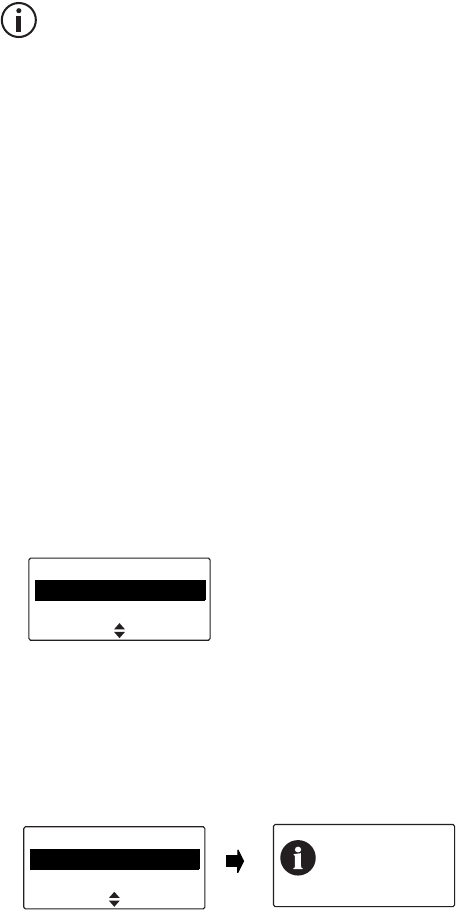
Basic operation 55
Pairing a wireless headset with the radio
Before attempting to connect a wireless
headset, Tait recommends that the headset is
fully charged. Refer to the headset installation
instructions for charging instructions.
Pairing creates a unique and encrypted wireless link
between the Bluetooth-capable radio, and the
Bluetooth headset. To use a headset with your radio,
the devices must first be paired.
When you connect to a wireless headset for the first
time, you need to instruct the radio to search for
compatible headsets using Bluetooth wireless
technology. The search should take less than one
minute.
To pair a wireless headset with the radio:
1Turn on the radio.
2Put the wireless headset into pairing mode.
Refer to the headset installation instructions for
instructions on how to do this.
3Press Menu and select Wireless headset > Find
new devices.
The New devices menu opens, and while the
radio searches for the new device, the message
Searching ... appears.
4Select Connect when the required headset
appears in the list of new devices, then Yes to add
the headset to My Headsets.
SelectBack
Wireless headset
Find new devices
Options
Yes
No
Add to My
Headsets?
ConnectCancel
New devices
HM1100
Searching ,,,
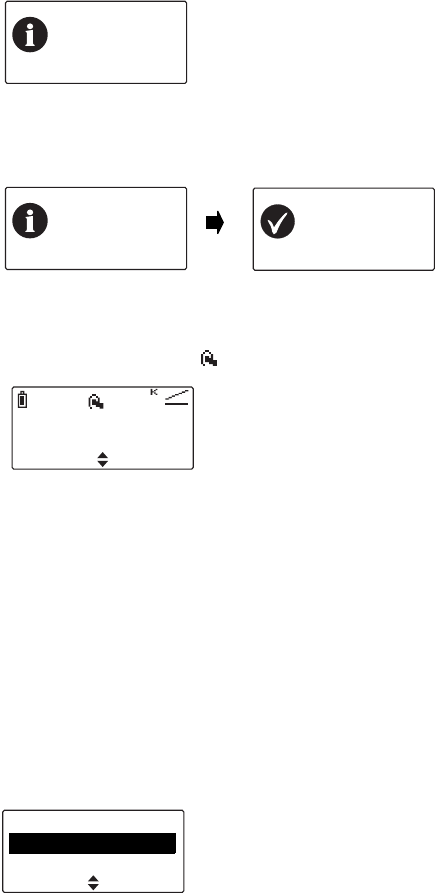
56 Basic operation
The message Connecting appears, while the
radio attempts to pair with the headset.
5When the message Calling. Answer on headset
appears, press the Answer button on the headset
to confirm the connection.
6Repeat the previous steps to add other headsets.
While the wireless headset is connected, the
wireless headset icon appears on the display.
Managing your headsets
Once a headset has been added to My Headsets, the
Manage headsets menu item appears under the
Wireless headsets menu. The Manage headsets
menu shows the headsets currently in My Headsets,
along with the following information:
■+ This headset is currently connected.
■a This headset will be automatically connected.
■c The radio will ask you for confirmation before
connecting this headset.
Clear
Connecting:
HM1100
Clear
Calling.
Answer on
headset
Clear
Headset
connected
Cancel
Channel 12
Menu
Options
Back
My Headsets
BlueAnt T1V1. +a
CSR-bc6 a
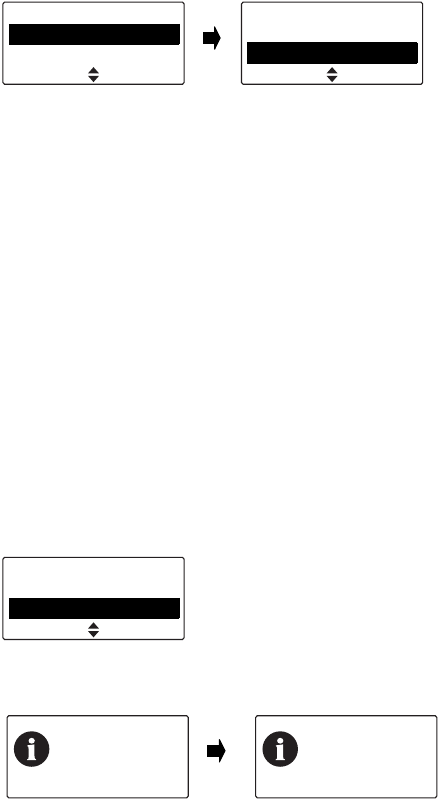
Basic operation 57
Press Options to disconnect or connect a headset
(Disconnect, Connect), change the priority order of
the headsets (Move down), or remove a headset
from My Headsets (Remove, Remove all).
Disconnecting the headset
To disconnect the headset from your radio:
■Press Menu and select Wireless headset >
Disconnect.
Alternatively, in the My headsets menu select
Options > Disconnect.
Reconnecting the headset
Your radio may be programmed so that each time the
headset is turned on, it will automatically reconnect to
the radio.
If the radio does not automatically reconnect to the
headset:
1On the radio, press Menu and select Wireless
headset > Reconnect last.
The radio then prompts you to connect to the
headsets in My Headsets, in priority order.
2Select Yes to connect, or No to choose another
headset.
SelectBack
My headsets
Disconnect
Move down
SelectBack
My headsets
Disconnect
Move down
SelectBack
Wireless headset
Connect
Reconnect last
No
Connect.
HM1100?
No
Connect
BlueAnt T1
V1?
Yes Yes

58 Basic operation
Changing the way your headset reconnects
You can use the Power-on option menu to change
the way your radio reconnects with a headset when
the radio is first turned on. The choices are:
■None: The radio does not connect to any head-
sets, and you will need to manually connect or
reconnect to your headset.
■Reconnect last: The radio connects to the previ-
ously connected headset.
■Connect: The radio will attempt to connect to the
headsets in My Headsets, in priority order.
To change the power-on option:
1Press Menu and select Wireless headset >
Options > Power-on option, and change to the
required option.
SelectBack
Power-on option
None
Reconnect last
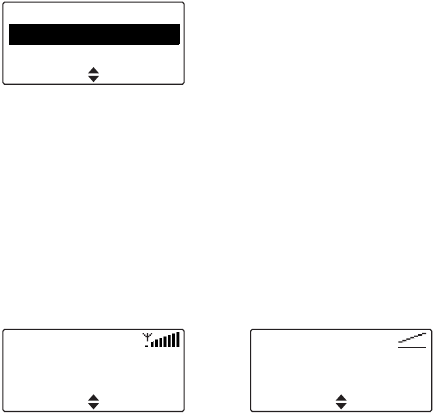
Basic operation 59
Changing the radio’s operating
mode
The way your radio performs basic functions, such as
sending and receiving calls, depends on the operating
mode of your network. The two operating modes that
may be available on your radio are:
■conventional mode (see "Operating in conven-
tional mode" on page 69), and
■trunked mode (see "Operating in trunked mode"
on page 108).
To change your operating mode:
1Press Menu and select Change mode.
(Depending on how your radio is programmed, you
may be able to press a function key to change
mode.)
2Select Yes to confirm your selection, and your
radio now shows the default display for either
trunked or conventional.
The following examples show typical default
displays for trunked and conventional modes.
SelectBack
Main menu
Change mode
Channels
trunked mode conventional mode
Network 1
200-20001-20
Menu
16A
Channel 1
Zone 2
Menu

60 Basic operation
Setting and viewing the radio’s
time and date
Your radio may be programmed to use its internal
real-time clock. You may be able to view the time and
date via a function key or via the radio menu. Other
features may also make use of the radio’s time and
date by showing entries based on the current clock
setting.
To set the time, date, and time format:
Your radio may be programmed to allow you to
set time and date manually, or time and date can
be updated using a GPS source.
1Press Menu and select Time and Date and the
corresponding option.
2Follow the prompts on the display.
To view the time and date:
■Press Menu and select Time and Date > View
clock (Depending on how your radio is pro-
grammed, you may be able to press a function
key to view the time and date).
Using the address book 61
5 Using the address book
Your radio may have a standard address book (with
pre-programmed entries) and a personal address
book which allows you to maintain your own entries.
The address book only shows entries that are relevant
to your radio’s current mode of operation
(conventional or trunked) and network.
The standard address book may be grouped by roles,
but you can also select to display all entries.
The standard address book can also contain entries
that are hidden from the radio user. These hidden
entries are used to identify incoming calls from known
sources.
This section covers:
■Opening the address book
■Changing the default address book
■Navigating the address book
■Filtering address book lists
■Maintaining personal address book entries
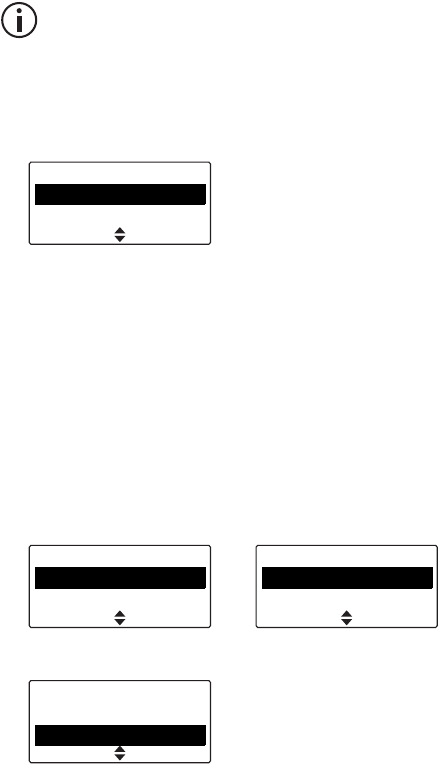
62 Using the address book
Opening the address book
To open the address book:
■Press Menu and select Address book.
Your radio may be programmed to use the left
selection key (Ad. book) or a function key to
open the address book.
When opening the address book for the first time
after turning on the radio or changing the mode,
you are asked to select the default address book:
The radio will now default to the selected address
book.
Changing the default address
book
To change the default address book:
1Press Menu and select Address book.
The standard or personal address book appears.
2Press Back.
You can now select the default address book.
SelectBack
Address book
Personal
Standard
SelectBack
Standard
All entries
Fire Truck
SelectBack
Personal
BILL
FIRE TRUCK 7
SelectBack
Address book
Personal
Standard
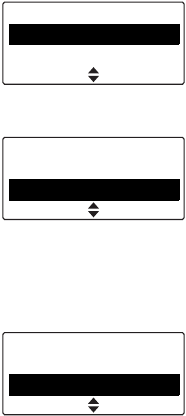
Using the address book 63
Navigating the address book
In the standard address book, each entry may have
been assigned to a role. Roles are used to categorise
entries into logical groups. When opening the
standard address book, you can view all entries or
filter the entries by a particular role.
The personal address book always lists all entries.
1Press Menu and select Address book.
In the standard address book, you can now select
to view all entries or select to view the entries of a
role.
2Scroll to the role you want, and press Select.
All entries associated with the selected role are
now displayed.
3Scroll to the entry you want.
4Press the PTT key to make a call.
5You can also press Options to:
■call the address or select the channel (same as
pressing PTT)
■send a status, text message, emergency or
priority call (depending on the type of entry)
■view the entry details
SelectBack
Standard
All entries
Technicians
SelectBack
Technicians
Jonathan
William
OptionsBack
Technicians
William
Tech Car
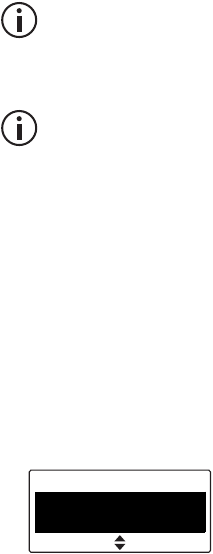
64 Using the address book
■add an entry of the standard address book to
your personal address book
If the number of an incoming or dialed call
occurs in both the standard and the personal
address books, the radio will display the name
defined in the personal address book.
When adding an entry from the standard
address book to the personal address, the role
is added as well.
■add, edit or delete entries in the personal
address book, including adding the last call
Filtering address book lists
You can use this method to select a role or entry if you
know its name.
■In the roles or entries list, start typing the name
(e.g. for ‘Jonathan’ press 5 (J) and 6 (o)) until the
desired role or entry appears.
OptionsBack
Standard
Jonathan
Technician
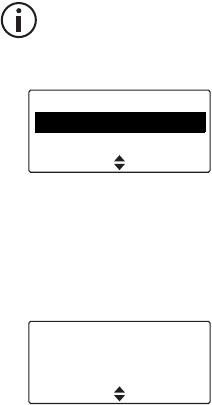
Using the address book 65
Maintaining personal address
book entries
The personal address books allows you to:
■create, edit and delete entries
■add the last caller
■copy entries from the standard address book
The personal address book can contain up to 100
entries.
New address book entries are only relevant to your
radio’s current mode of operation (conventional or
trunked) and network.
Creating, editing and deleting personal
address book entries
To manually create a personal address book entry:
To edit or delete entries, select the
corresponding option.
1Press Menu and select Address book.
If the standard address book appears, press Back
and switch to the personal address book.
2Press Options and select New entry.
3Enter the name.
Press Clear to correct any mistakes.
Press Options and select Next.
OptionsBack
Personal
BILL
FIRE TRUCK 7
OptionsClear
abc Name 4/14
Jack New entry
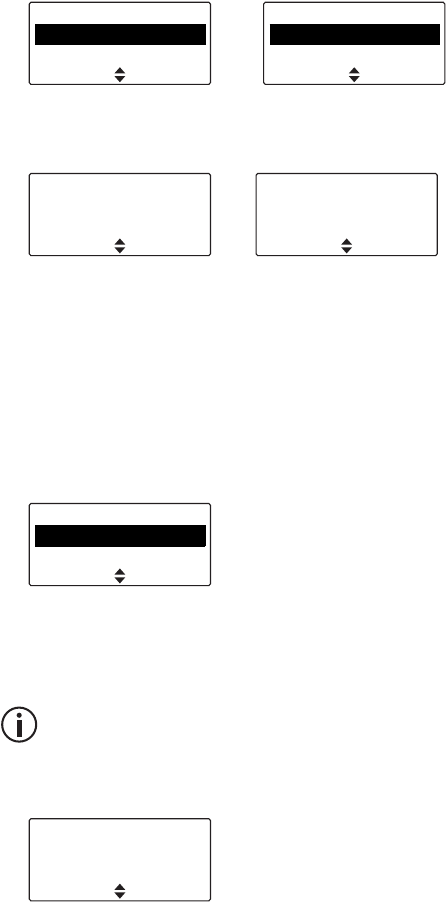
66 Using the address book
4In conventional mode, select the Entry type.
Press Select.
5Enter the number or channel.
Press Options and select Save.
Adding the last caller to the personal
address book
If you received an individual call or a text message,
you can add the caller to the personal address book:
1Press Menu and select Address book.
If the standard address book appears, press Back
and switch to the personal address book.
2Press Options and select Add last call.
Add last caller only appears, if you received an
individual call (all modes except analog
conventional) or a text message.
3Enter or edit the name.
Press Clear to correct any mistakes.
SelectBack
Entry type
individual call
Channel
SelectBack
Entry type
Channel
Text message ID
DMR conventional Analog conventional
OptionsClear
123 Number
09808242
OptionsClear
123 Channel
200New entry
OptionsBack
Personal
BILL
FIRE TRUCK 7
OptionsClear
abc Name 4/14
Jack New entry

Using the address book 67
Press Options and select Next.
4In trunked mode, the number of the last call
appears on the display.
If you want to edit the number, press Change.
Otherwise, press Options and select Save.
5In conventional mode, select the Entry details
screen appears showing the radio ID of the last
caller:
If you want to edit the details, press Change.
Otherwise, press Options and select Save.
Copying a standard address book entry to
the personal address book
To copy a standard address book entry to the
personal address book:
1Press Menu and select Address book.
If the personal address book appears, press Back
and switch to the standard address book.
2Select a standard address book entry (from a role
or all entries) and press Select.
OptionsClear
123 Number
203New entry
Change
OptionsClear
Entry details
Individual call
56179 entry
Change
OptionsBack
Standard
All entries
Jeff
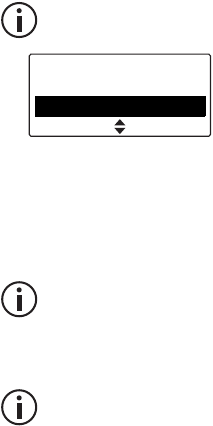
68 Using the address book
The entry types Talkgroup and Status Update
cannot be copied to the personal address book.
3Press Options and select Add to personal.
You can now go to the personal address book and
change the new entry to make corrections to the
name or number.
If the number of an incoming or dialed call
occurs in both the standard and the personal
address books, the radio will display the name
defined in the personal address book.
If the entry from the standard address book has
a role assigned, the role will also be copied to
the personal address book. In this case the
personal address book will display the role in a
second line.
OptionsBack
Technicians
William
Tech Car
Operating in conventional mode 69
6 Operating in
conventional mode
This section explains how to operate your radio on a
conventional network (digital and analog).
This section covers:
■Selecting a zone
■Selecting a channel
■Selecting a scan or vot-
ing group
■Understanding talk-
groups
■Making a call
■Making an individual
call
■Making a preset call
■Making a call using the
address book
■Making a local call
■Making a DTMF patch
call
■Making an emergency
call
■Setting your status (on
analog channels)
■Sending and receiving
status messages
■Sending and receiving
text messages
■Checking the queue
■Call alert
■Radio check
■Radio monitor
■Radio inhibit and unin-
hibit
■Resending calls auto-
matically
■Transmitting at low
power
■Ending active calls
■Using monitor and
squelch override
(on analog channels)
■Bypassing the repeater
(on analog channels)
■Receiving a call
■Using the radio in dif-
ferent repeater areas
■Scanning a group of
channels

70 Operating in conventional mode
Selecting a zone
Your radio may be programmed to use zones, which
are collections of channels and groups. When you
select a zone, only the channels and groups assigned
to that zone are available.
Using the Main menu:
1Press Menu and select Zones.
(Depending on how your radio is programmed, you
may be able to use the scroll keys or left selection
key to select the Zones menu.)
2In the Zones menu, scroll through the list of zones
until the one you want appears.
3Press Select, and the zone indication appears
either below the channel information, beside the
RSSI icon, or in both positions.
When changing a zone, the first channel in the new
zone is selected.
Using the 3-way selector (optional):
Rotate the 3-way selector to the zone you want. For all
other zones, use the Main menu to select a zone.
SelectBack
Main menu
Zones
Address book
SelectBack
Zones
Zone 2
Zone 3
Channel 12
Zone 11
MenuZones

Operating in conventional mode 71
If you turn the 3-way selector while pressing the
PTT key, the zone will change after you release
the PTT key.
Selecting a channel
For DMR digital channels, a talkgroup may be
assigned to a channel. For more information,
see "Understanding talkgroups" on page 74.
Using the scroll keys:
Your radio may be programmed use the scroll keys to
to scroll through the channels.
Using the Main menu:
1Press Menu and select Channels.
(Depending on how your radio is programmed, you
may be able to use the scroll keys, the left
selection key or a function key to select the
Channels menu.)
2In the Channels menu, scroll through the list of
channels until the channel you want appears.
3Press Select, and the programmed channel is now
shown on the display.
Using the channel selector
Depending on the radio model, the channel selector
can be used to either select channels 1 to 16, or
continuously scroll through all available channels.
SelectBack
Main menu
Channels
Zones
SelectBack
Channels
Channel 9
Scan 1

72 Operating in conventional mode
If you turn the channel selector while pressing
the PTT key, the channel will change after you
release the PTT key.
Dialing a channel
This feature is only available for radios with
alphanumeric keys.
Dialing a channel may be available from the radio’s
idle display but is always available while in the
Channels menu.
1Dial the number associated with the channel using
the alphanumeric keys.
2Press Select, and the programmed channel is now
shown on the display.
Selecting a scan or voting group
A scan or voting group is a collection of channels that
are grouped together for either scanning or voting. In
the Channels menu, the scan or voting group is
shown as being a single channel item, e.g. “Scan1”.
The sections "Using the radio in different repeater
areas" on page 101 and "Scanning a group of
channels" on page 102 explain how your radio
operates once a scan or voting group has been
selected.
Using the Main menu
1Press Menu and select Channels.
9
SelectClear
SelectBack
Main menu
Channels
Zones

Operating in conventional mode 73
(Depending on how your radio is programmed, you
may be able to use a function key, the scroll keys
or left selection key to select a group.)
2In the Channels menu, scroll through the list of
channels and groups until the group you want
appears.
3Press Select, and the programmed scan or voting
group is now shown on the display. The scanning
icon appears on the display.
Dialing a scan or voting group
This feature is only available for radios with
alphanumeric keys.
Dialing a scan or voting group may be available from
the radio’s idle display but is always available while in
the Channels menu.
To dial the group number from the default display:
1Dial the number associated with the scan or voting
group using the alphanumeric keys.
2Press Select, and the programmed scan or voting
group is now shown on the display. The scanning
icon appears on the display.
SelectBack
Channels
Channel 9
Scan 1
Scan 1
MenuChannels
12
SelectClear
74 Operating in conventional mode
Understanding talkgroups
This feature is available for DMR digital channels only.
A talkgroup is a collection of radio users with whom
you want to have private conversations. For example,
a state's public safety agencies could have the
following talkgroups:
■Local talkgroups—used by a specific agency to
communicate within their own local agency. It may
even be made up of a county of public safety offi-
cers.
■Regional talkgroups—used by large state agen-
cies that have regional divisions.
■Statewide talkgroups—used by an agency to com-
municate with public safety members in other
regions. Statewide talkgroups, as their name sug-
gests, enable public safety agencies to communi-
cate with each other from one end of the state to
the other.
■Special event talkgroups—may be used to man-
age emergencies encompassing a large area, or
even events such as visits by heads of state.
Talkgroups can be assigned to each channel, to allow
a users to:
■initiate a call to a talkgroup by pressing PTT
■listen and respond to conversations on none, one
or multiple talkgroups
The channel may be named to reflect its talkgroup
association. When making a call, the talkgroup name
will appear.
Your radio may also be programmed to show the
Talkgroups menu which allows you to change the
talkgroup you want to call and listen to on the current
channel.
Operating in conventional mode 75
Making a call
The radio’s behavior when making a call changes
depending on the type of channel selected.
Channels can be programmed for:
■DMR calls over a DMR network
■DMR calls between radios
■analog calls between radios
If you are on a channel programmed for calls over the
DMR network, the green LED indicates whether the
network is active. By default, the network is inactive
(green LED is off).
Initiating a call will activate the network which will
remain active for a programmed time. While the
network is active (green LED glows), you can
complete the call and start a new call.
If you are on a channel programmed for DMR or
analog calls between radios (without a radio network),
the green LED indicates activity on the channel, i.e.
whether someone is talking.
For all DMR calls (over the network or radio to radio),
you may hear a go-ahead double-beep after pressing
the PTT key (if programmed).
The radio may be programmed to ring or beep when a
new DMR call is received.
DMR calls have an inactivity timeout. If a pause in the
conversation exceeds the timeout, the next press of
the PTT key will establish a new call.

76 Operating in conventional mode
To make a call:
1Select the required channel or scan group.
You may need to select the zone you want first,
then select the channel or group from that zone.
2On channels programmed for DMR or analog calls
between radios (without a radio network): Check
that the channel is clear. If the LED is glowing
green, the channel is busy and you may not be
able to transmit.
3Hold the radio so that the microphone is about one
inch (2.5 cm) from your mouth and press the PTT
key to transmit.
4On a DMR channel: Wait for the go-ahead double-
beep (if programmed).
5Speak clearly into the microphone and release the
PTT key when you have finished talking.
While you are transmitting, the LED glows red and
the transmit icon appears on the display.
If you turn the channel selector while pressing
the PTT key, the channel will change after you
release the PTT key.
Limiting call time
Your radio may limit the amount of time you can talk
(transmit) continuously. This is known as the ‘transmit
timer’ or ‘time-out timer’ and allows other radio users
to make calls on that channel.
The message Transmit Timeout Imminent appears
on the display.
If the transmit timer has timed out, you must release
the PTT before you can transmit again.
Your radio may be unable to transmit for a short
time after the transmit timer has expired.
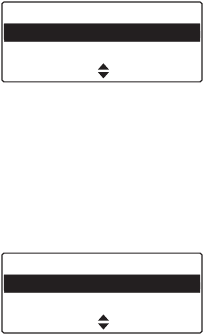
Operating in conventional mode 77
Making an individual call
This feature is available for DMR digital channels only.
To make a call to one person:
1Press Menu and select Individual call.
(Depending on how your radio is programmed, you
may be able to use a function key to select
individual calls.)
2If no address book is configured, a preconfigured
list appears. The person to whom you last made an
individual call is highlighted.
Scroll to the person you want to call and press the
PTT key to make the call immediately.
(Alternatively, you can press Call and then PTT.)
3If an address book is configured, you can select to
either dial a number or show the address book.
Making a preset call
Your radio may be programmed to use a function key
to initiate a call to an individual or group that may or
may not be part of your current talkgroup (e.g. the
dispatcher).
Making a call using the
address book
The Address book menu has a programmed list of
calls.
Individual call
Car 2
Car 1
Back Call
Send using
Dialed number
Address book
Back Select

78 Operating in conventional mode
When on a DMR conventional channel, the address
book will show the DMR entries available on the
current channel as well as all analog entries. When on
an analog channel, the address book will show all
analog entries. When selecting an analog entry, the
radio will change channel if necessary.
Address book calls may also be used to send status
information, such as “at lunch” or “on site”, or to
change to a channel or group. For more information,
see "Using the address book" on page 61.
1Press Menu and select Address book.
(Depending on how your radio is programmed, you
may be able to use the scroll keys, left selection
key or a function key to select the Address book
menu.)
2In the Address book menu, scroll through the list
of calls until the call you want appears.
3Press Options and Call, or press PTT.
The call details appear on the display, the LED
glows red, and appears on the display.
Making a local call
Each channel on your radio may have one or more
local calls programmed.
1Select the required channel.
2Press Menu and select Local calls.
3In the Local calls menu, scroll through the list of
local calls until the call you want appears.
SelectBack
Main menu
Address book
Local calls
SelectBack
Main menu
Local calls
Set status
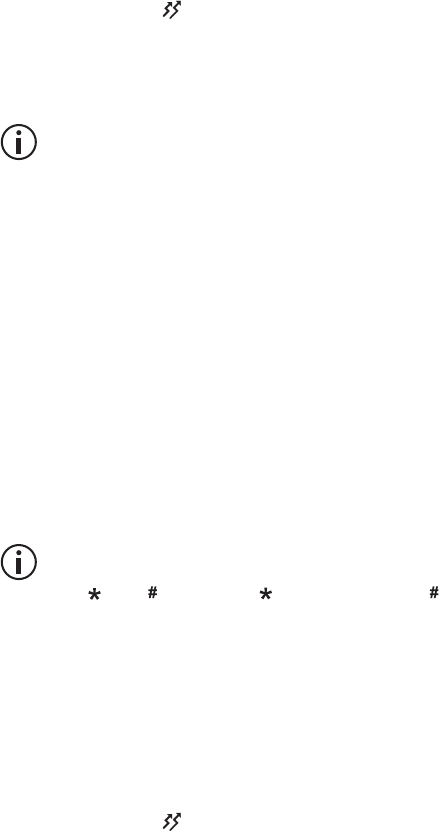
Operating in conventional mode 79
4Press Send.
The call details appear on the display, the LED
glows red, and appears on the display.
Dialing a radio call
This feature is only available for radios with
alphanumeric keys.
To dial a call to another radio, or group of radios
(analog only):
1Select the required channel.
2Press Menu and select Dial radio call.
Alternatively, your radio may be programmed so a
call can be dialed directly from the default display.
In this case, you can start dialing the call without
selecting the menu option.
On an analog channel, a series of X and S
characters may appear, prompting you to dial over
them.
3Dial the number using the alphanumeric keys.
On an analog channel, your radio may be
programmed so you can dial group tones using
the and keys. Dial to fill one X. Dial to
fill the current X and all subsequent X
characters in the current burst.
4For DMR conventional calls, press the PTT key to
make the call immediately. You can also press Call
and then PTT.
For analog calls, press Send.
The call details appear on the display, the LED
glows red, and appears on the display.
On an analog channel, when the called party
receives your call, the message Ack received
may appear on the display.
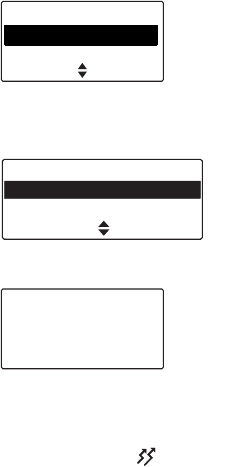
80 Operating in conventional mode
Making a phone call
This feature is available for DMR digital channels only.
You may be able to connect directly to a telephone
network by dialing the number yourself or using preset
dialing sequences.
1Select the required channel.
2Press Menu and select Phone call.
3If an address book is configured, you can select to
either dial a number or show the address book.
Otherwise you can only dial a number.
4Press Call.
The call details appear on the display, the LED
glows red, and appears on the display.
Making a DTMF patch call
You may be able use DTMF patch dialing to connect
to a telephone network or signal another device by
dialing the number yourself or using preset dialing
sequences.
You may be able to either:
■use a programmed function key
■use the Main menu to dial the call
SelectBack
Main menu
Phone call
Local calls
Send using
Dialed number
Address book
Back Select
12
CallClear

Operating in conventional mode 81
■make a local call (see "Making a local call" on
page 78)
■use your address book (see "Making a call using
the address book" on page 77)
■dial DTMF tones (overdialing)
Using a function key
Depending on how DTMF patch calls are
programmed, some or the following steps may
not be necessary.
1Select the required channel.
2Press the function key programmed for DTMF
patch call.
Your radio may send tones to capture the line.
3Press Send, or press the function key a second
time, to send the preset number.
You may hear telephone dialing and ringing tones.
4Proceed with your call.
5Press End, or give a long press on the function
key, to end the call.
Your radio may send tones to release the line.
Using the Main menu
This feature is only available for radios with
alphanumeric keys.
To dial a DTMF patch call by using the Main menu:
Depending on how DTMF patch calls are
programmed, some or the following steps may
not be necessary.
1Select the required channel.
2Press Menu and select Dial patch call.
3Dial the required number using the alphanumeric
keys.
4Press Send.

82 Operating in conventional mode
Your radio may send tones to capture the line.
5Press Send to send the number dialed in step 3.
You may hear telephone dialing and ringing tones.
6Proceed with your call.
7Once the call has finished, press End.
Your radio may send tones to release the line.
Dialing DTMF tones (overdialing)
Your radio may be programmed to allow dialing of
DTMF tones using the numeric keypad while on a
channel or in a call. The dialing may be either sent out
immediately (as you type) or sent after pressing Send.
Making an emergency call
You may be able to activate emergency mode by
using a programmed function key.
1Press the function key programmed for
Emergency Mode and an emergency call is sent to
your dispatcher, or some other predetermined
location.
While emergency mode is active, your radio may
automatically cycle between receive and transmit,
so that your dispatcher can hear any activity near
the radio. Alternatively, your radio may appear to
turn off but will actually remain in
emergency mode.
2Reset the radio to normal operation at any time by
turning the radio off and then on.
Emergency mode may be programmed to end
after a fixed period of time. In this case, there is
no need to turn the radio off and then on in order
to return the radio to normal operation.

Operating in conventional mode 83
Setting your status (on analog
channels)
For analog channels, your radio may be able to
maintain a record of your current status. This status
may be sent with outgoing calls programmed to
contain status information. If the radio receiving your
call has been programmed with the same status
messages, it will decode and display your status.
The status indicates your current activity or location,
such as “en route” or “at lunch”.
To change your current status:
1Press Menu and select Set status.
2In the Set status menu, scroll through the list of
status messages until the message you
want appears.
3Press Select. The message Status updated
appears on the display.
Sending and receiving status
messages
A status message is sent to another party to indicate
your current activity or location, such as “en route” or
“at lunch”. If the radio receiving your message has
been programmed with the same status messages, it
will decode and display your message. If you receive
a status message, the message is automatically
queued, since a response is not expected.
Status messages can also be used to control external
devices.
SelectBack
Main menu
Set status
Dial radio call
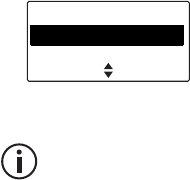
84 Operating in conventional mode
Sending a status message
1Press Menu and select Services > Status
update.
2In the Status update menu, scroll through the list
of status messages until the message you
want appears.
3When you have chosen a message, press Select.
Depending on how radio is programmed, the
message may be sent directly to a
preconfigured radio or group, or you are
presented with options to select a destination.
The call details appear on the display.
Receiving a status message
If the radio is programmed for call queuing, incoming
status messages are added to the queue. For more
information, see "Checking the queue" on page 89.
Press Options and select whether to reply, call or
delete.
Your radio may be programmed to automatically view
status messages on receipt.
If the radio is not programmed for call queuing,
incoming status messages are displayed briefly.
SelectBack
Status update
On site
In transit
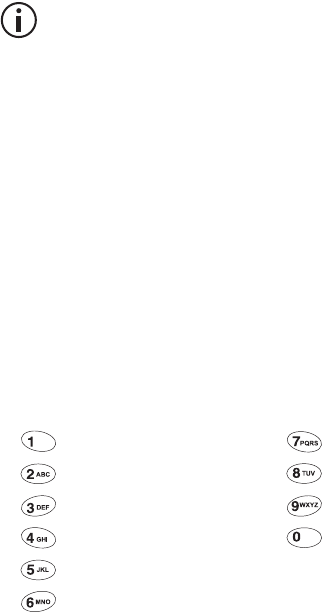
Operating in conventional mode 85
Sending and receiving text
messages
Your radio may be programmed so that you can send
text messages. The three options for creating text
messages are selecting a preset text message,
editing a draft text message, or creating a new text
message.
To either edit or enter a text message, your
radio must have alphanumeric keys.
Using the alphanumeric keys to enter text
When the alphanumeric keys are used to enter a text
message, they have special functions.
■Use the # key to select the type of text entry:
upper and lower case characters (ABC, abc), ini-
tial capitals (Abc), or numbers (123).
■Use the left selection key (Clear) to delete a char-
acter from the display.
■Use the scroll keys to move through a message.
Repeated presses of these keys will give you the
characters shown in the following table.
Key Characters Key Characters
.,?!-/1 PQRS7
ABC2 T UV8
DEF3 WX Y Z 9
GHI 4 space 0
JKL5
MNO6
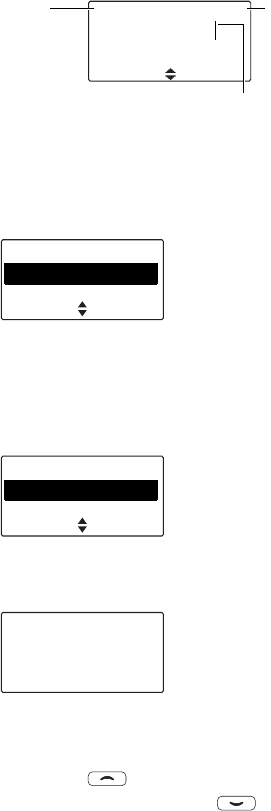
86 Operating in conventional mode
In the example below, a preset text message has
been selected, and is being edited.
Sending a preset text message
1Press Menu and select Services > Text message
> Preset message.
In the Preset message menu, a short label
representing each message is displayed.
2Scroll through the list of preset message labels
until the one you want appears.
3Press Select, and the text message you have
chosen is now displayed.
4Press Send to send the message, or Edit to
change the message.
Pressing will place the cursor at the start of
the message. Pressing will place the cursor
at the end of the message.
5When the message is complete, press Options
and select Send.
Options
Contact base now|
C lea r
abc 16/128
currently
selected text
entry option
(lower case)
number of characters
used/total number of
characters allowed
cursor: shows current point of text entry
SelectBack
Text message
Preset message
Edit message
SelectBack
Preset message
Contact
Site
Send
Contact base now
Back Edit

Operating in conventional mode 87
Creating a new text message
1Press Menu and select Services > Text message
> New message.
2Use the alphanumeric keys to add characters and
the Clear key to delete them. Use the scroll keys to
move through the characters.
3When the message is complete, press Options
and select Send.
If you decide to cancel out of editing a text message
or receive a call while editing, the current draft will be
saved and is available for editing later.
Editing a draft text message
1Press Menu and select Services > Text message
> Edit message.
The last sent or edited text message will appear.
2Use the scroll keys to move through the
characters. Use the alphanumeric keys to add
characters and the Clear key to delete them.
3When the message is complete, press Options
and select Send.
If you decide to cancel out of editing a text message
or receive a call while editing, the current draft will be
saved and is available for editing later.
Options
On site|
Clear
abc 7/100
Options
On site|
Clear
abc 7/100
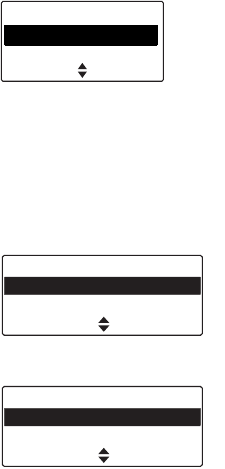
88 Operating in conventional mode
Sending a text message
1When you have chosen or entered a message,
press Options and the Text options menu opens.
2In the Text options menu, scroll through the list of
options until the choice you want appears.
3Select Send and press Select.
4If an address book is configured, you can select to
either dial a number or show the address book.
Otherwise a preset list of radios will appear.
The call details appear on the display.
Receiving a text message
If the radio is programmed for call queuing, incoming
text messages are added to the queue. For more
information, see "Checking the queue" on page 89.
Press Options and select whether to reply, call or
delete.
Your radio may be programmed to automatically view
text messages on receipt.
If the radio is not programmed for call queuing,
incoming text messages will not be stored or
displayed.
SelectBack
Text options
Send
Cancel sending
Send using
Dialed number
Address book
Back Select
Call alert
Richard
John
Send toCancel
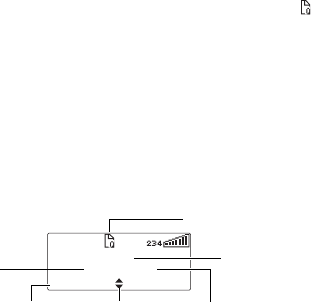
Operating in conventional mode 89
Checking the queue
If you have missed an incoming call, status message,
call alert or text message, it may be stored in the
queue. Information about the last call or message is
shown on the display and the queue icon appears.
Your radio may be also programmed to automatically
view the latest status update or text message on
receipt. Press Back to exit this view or Delete.
In the example below, a status message was received
from Car 1. This is the first of three calls or messages
stored in the queue.
If there are calls or messages in the queue, the radio
may emit a warble tone for a period of time.
The notification starts again when the radio is
restarted or another call is received.
Accessing the queue
1Use the scroll keys to move through the calls or
messages in the queue until the item you want
appears.
2Press Options.
The options available depend on the type of call it
is. For a voice call, select Call to return the call.
For a status message or a text message, select
View to read the message, Reply to reply, or Call
to return the call.
Your radio may be programmed to automatically view
status updates and text messages on receipt.
identity of last
unanswered caller
scroll through
the calls
type of call
position in the queue
(not for single-item
queue)
options available
depend on type of
call
queued calls or messages
MenuOptions
Car1
Status 1/3

90 Operating in conventional mode
You can also delete the selected call or messages, or
delete all queued calls and messages.
Call alert
This feature is available for DMR digital channels only.
You can let another radio user know that you want to
talk to them by sending them a call alert page. When
the other radio user receives the call alert page, they
can call you back when it is convenient.
If you are on a DMR conventional channel, you can
send a call alert to any other radio on the same DMR
conventional channel.
To send a call alert page:
1Press Menu and select Services > Call alert.
You can also send a call alert from the Options
> Services menu of an address book entry.
2If an address book is configured, you can select to
either dial a number or show the address book.
Otherwise a preset list of radios will appear.
3Select the radio you want to page.
4Press Send to.
A message appears in the display.
Send using
Dialed number
Address book
Back Select
Call alert
Richard
John
Send toCancel
Sending page
to Richard
Cancel
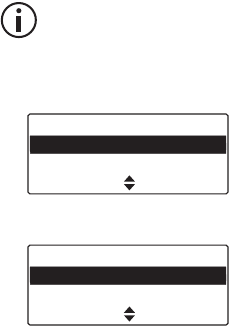
Operating in conventional mode 91
The LED glows red and a message will be
displayed to advise you whether the call alert has
been sent successfully or not.
If an acknowledgement is not received from the
recipient’s radio, you will have the option of either
canceling or resending the request.
Answering a call alert page
If you receive a call alert page from another radio user,
the message Call alert and the name of the caller
appears on the display.
Select Call to return the page or Clear to delete it.
If you miss the call alert page, a call alert entry is
added to the queue. See "Checking the queue" on
page 89.
Radio check
This feature is available for DMR digital channels only.
If you want to find out whether a particular radio is
available on the same DMR conventional channel,
you can use the radio check feature. This sends a
radio check message to the radio unit you have
specified.
1Press Menu and select Services > Radio check.
You can also check a radio from the Options
menu of its address book entry.
2If an address book is configured, you can select to
either dial a number or show the address book.
Otherwise a preset list of radios will appear.
Send using
Dialed number
Address book
Back Select
Radio check
Car 2
Car 3
Send toCancel

92 Operating in conventional mode
3Scroll to the radio you want to check.
4Press Send to.
The LED glows red and a message showing the
destination appears in the display.
If the radio is available on the system, an
acknowledgement message is displayed.
If an acknowledgement is not received from the
recipient’s radio, you will have the option of either
canceling or resending the request.
Radio monitor
The radio unit monitor feature can be used when you
are concerned about the safety of a radio user on the
same DMR conventional channel. When you send a
radio-unit monitor request to a radio, it calls you back
without giving any indication that it is making a call.
You can hear any activity near the radio for up to 120
seconds.
To send a radio unit monitor request:
1Press Menu and select Services >
Radio monitor.
You can also send a radio unit monitor request
from the Options menu of an address book
entry.
Sending
radio chk to
Car 2
Cancel
Ack received
OK
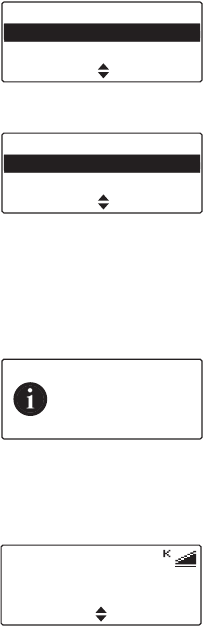
Operating in conventional mode 93
2If an address book is configured, you can select to
either dial a number or show the address book.
Otherwise a preset list of radios will appear.
3Scroll to the radio you want to monitor.
4Press Send to.
The LED glows red and a message appears in the
display.
If the other radio has received your request, it will
now call you, so that you can monitor activity near
the radio.
If an acknowledgement is not received from the
recipient’s radio, you will have the option of either
canceling or resending the request.
Send using
Dialed number
Address book
Back Select
Radio monitor
Car 2
Car 3
Send toCancel
Sending
R.U.M to
Car 2
Cancel
Call received
Car 2
Menu
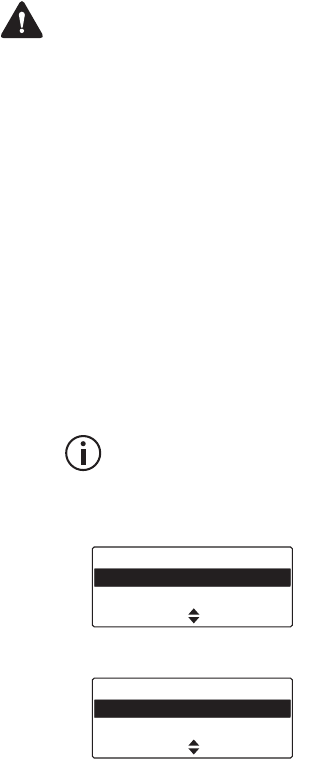
94 Operating in conventional mode
Radio inhibit and uninhibit
Warning When a radio is immobilized (‘inhibited’),
the encryption keys may be automatically deleted
from the radio.
If you want to inhibit another radio on the same DMR
conventional channel, you can use the radio inhibit
feature. This feature is also known as ‘stun’.
On the inhibited radio, Radio stunned will appear
briefly on the display, and the radio will return to the
idle display. The radio remains inoperable even if it is
turned off and then on again.
The radio cannot return to normal operation until it
receives an uninhibit request. This is also known as
‘revive’.
To send a radio inhibit request
1Press Menu and select Services > Radio inhibit.
You can also inhibit another radio from the
Options menu of its address book entry.
2If an address book is configured, you can select to
either dial a number or show the address book.
Otherwise a preset list of radios will appear.
3Scroll to the radio you wish to make inoperable.
4Press Send to.
Send using
Dialed number
Address book
Back Select
Radio inhibit
Car 2
Car 3
Send toCancel

Operating in conventional mode 95
The LED glows red and a message appears in the
display.
If the radio has been successfully immobilized, an
acknowledgement message is displayed.
To send a radio uninhibit request:
1Press Menu and select Services >
Radio uninhibit.
You can also uninhibit another radio from the
Options menu of its address book entry.
2If an address book is configured, you can select to
either dial a number or show the address book.
Otherwise a preset list of radios will appear.
3Scroll to the radio you wish to make operable.
4Press Send to.
The LED glows red and a message appears in the
display.
Sending
inhibit to
Car 2
Cancel
Ack received
OK
Send using
Dialed number
Address book
Back Select
Radio uninhibit
Car 2
Car 3
Send toCancel
Sending
uninhibit to
Car 2
Cancel

96 Operating in conventional mode
If the radio has been successfully returned to
operation, an acknowledgement message is
displayed.
The uninhibited radio will briefly display Radio
revived.
If an acknowledgement is not received from the
recipient’s radio, you will have the option of either
canceling or resending the request.
Resending calls automatically
On an analog channel, your radio may have been
programmed to resend individual and group calls
when transmission is refused because the channel is
busy.
There are two automatic callback features:
■deferred calling
■no acknowledgement retries
Deferred calling
When you attempt to make a call on a channel that is
busy, the radio can store and send the call once the
channel is free. The radio gives a low-pitched beep if
the channel is busy, and then waits until the channel
is free to retry the call.
A deferred calling time limit may have been
configured. Once the time limit has expired the
radio will no longer attempt to retry the call.
Any user interaction (such as pressing PTT) will
cancel a deferred call.
Ack received
OK
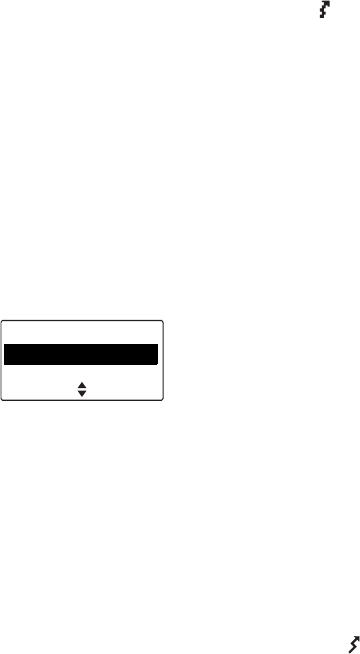
Operating in conventional mode 97
No acknowledgement retries
When you send a call and there is no reply, the call is
resent.
Any user interaction (such as pressing PTT) will
cancel a call that is being resent.
Transmitting at low power
If you are using your radio in conditions where signal
strength is high, you can extend the shift life of your
battery by transmitting at low power.
When low power transmit is turned on, appears on
the display and calls are made at low power rather
than at the programmed power setting.
Some channels may always transmit at low power.
To turn low power transmit on or off for all channels:
Using the Main Menu
1Press Menu and select Radio settings >
Functions > Low power tx.
2Scroll to On (or Off) and press Select. (The current
setting is highlighted.)
The message Low power tx activated
(or deactivated) appears on the display.
Using a function key
1Press the function key programmed for low-power
transmit to transmit at low power on your current
channel.
The message Low power tx activated appears
briefly, and the low-power transmit icon appears
on the display.
SelectBack
Low power tx
Off
On

98 Operating in conventional mode
2Press the low-power transmit function key again to
turn low-power transmit off, and the message Low
power tx deactivated appears on the display.
Ending active calls
For analog channels, you may have a function key
programmed to either end the current call, or end the
current call and all other active calls in your group.
This can be done either by:
■using the function key programmed for reset mon-
itor to end your current call,
■using the function key programmed for call clear-
down to end your current call and all other calls in
your group, or
■using the function key programmed for both reset
monitor and call cleardown.
Using a function key to end your current call
■Press the function key programmed for reset mon-
itor. The radio’s monitor is turned off, ending your
current call.
The LED stops flashing green, and the monitor
icon disappears from the display.
Using a function key to end all active calls
■Press the function key programmed for call clear-
down and monitor is turned off for all radios in
your radio group.
The LED stops flashing green, and the monitor
icon disappears from the display.
Using the function key programmed for reset
monitor/call cleardown to end active calls
The function key programmed for reset monitor may
be programmed so that a short key press ends your
current call, and a long key press ends all active calls
in your group.
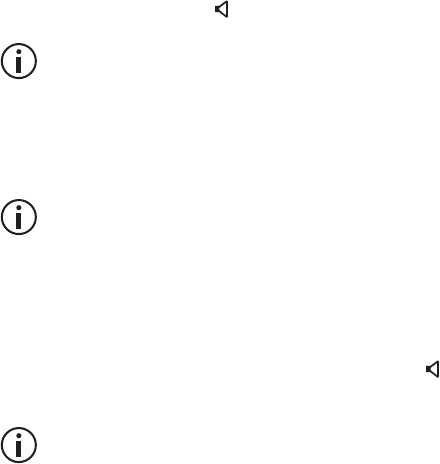
Operating in conventional mode 99
Using monitor and squelch
override (on analog channels)
The monitor function allows you to override some or
all of the radio’s mutes, and hear if there is any traffic
on a channel before you make a call.
The squelch override function lets the radio user
override the squelch (carrier) mute and hear all noise
on a channel, including weak signals that are below
the programmed squelch threshold.
To turn monitor on and off:
1Press Menu and select Radio settings >
Functions > Monitor.
(Depending on how your radio is programmed, you
may be able to press a function key to toggle
monitor on and off.)
2Scroll to On (or Off) and press Select.
While monitor is on, the LED slowly flashes green
and the monitor icon appears in the display.
Your radio may be programmed so that monitor
turns off automatically after a short time.
To turn squelch on and off:
1Press Menu and select Radio settings >
Functions > Squelch o’ride.
Squelch is often programmed as a long
keypress of the same function key that turns
monitor on and off.
2Scroll to On (or Off) and press Select.
This allows you to hear even faint and noisy
signals. While squelch override is on, the LED
flashes green, and the squelch override icon
appears on the display.
Press the monitor function key again to return
the radio to a quiet state.

100 Operating in conventional mode
Squelch cannot be overridden when the radio is
scanning.
Bypassing the repeater
(on analog channels)
For analog channels, you can bypass the radio
repeater and communicate directly with another radio.
This feature is known as repeater talkaround. You can
do this, for example, when you are out of range of the
repeater, or if the repeater is busy or stops working.
While repeater talkaround is active, all transmissions
are made on the receive frequency of the channel you
are on.
To activate repeater talkaround, you may be able to
either use a programmed function key, or use the
Main menu.
Using the Main menu
1Select the required channel.
2Press Menu and select Radio settings >
Functions > Talkaround.
3In the Talkaround menu, choose On.
4Press Select. The message Talkaround
activated appears briefly, and the repeater
talkaround icon appears on the display.
5Proceed with your call.
6To turn repeater talkaround off, either change the
channel, or choose Off in the Talkaround menu.
Using a function key
1Select the required channel.
2Press the programmed function key to turn
repeater talkaround on. The message Talkaround
activated appears briefly, and the repeater
talkaround icon appears on the display.

Operating in conventional mode 101
3Proceed with your call.
4To turn repeater talkaround off, either change the
channel, or press the function key again.
Receiving a call
When there is valid activity on your radio’s currently
selected channel or group, the radio then unmutes
and you can hear the call.
If an incoming call contains special signaling that
matches the signaling programmed for your radio, the
LED lights up green and your radio may give a ringing
tone.
Using the radio in different
repeater areas
Your radio may have a group of channels
programmed as a voting group. The channels in the
voting group all carry the same traffic, but from
different repeaters. As your radio moves in and out of
different repeater coverage areas, the best
communication channel is automatically selected for
you to use.
This channel is known as the ‘home’ channel, and will
be the channel you make and receive calls on. While
voting is active, the scanning icon appears on the
display.
The section "Selecting a scan or voting group" on
page 72 explains how to select a group. A group can
be either a voting or a scanning group.
Suspending a channel from a voting group
You may be able to use the function key programmed
for nuisance delete to temporarily delete one of the
channels from the voting group.

102 Operating in conventional mode
When that voting group is next selected, or after the
radio has been turned off and then on, the deleted
channel is again part of the voting group.
Alternatively, the function key programmed for voting
may be programmed so that a short key press turns
on voting, and a long key press activates nuisance
delete.
■Press and hold the function key programmed for
voting to remove the current channel from the vot-
ing group.
If the operation has been successful, the message
Channel nuisance deleted appears on the
display.
Scanning a group of channels
The scan function is used to monitor a programmed
group of channels, looking for activity. While the radio
is scanning for activity, the scanning icon appears
on the display. When activity is detected on a channel
in the scan group, the radio stops on that channel. The
radio unmutes and you can hear the call. Scanning
resumes once the channel is no longer busy.
The section "Selecting a scan or voting group" on
page 72 explains how to activate scanning.
Standard and background scanning
The two types of scanning that may be available on
your radio are standard scanning, and background
scanning. Background scan can only be activated by
using a function key programmed for background
scan. It differs from standard scanning in that the
channel that was selected when background scan
was activated is also included as a
scan-group member.
Making a call while scanning
If you wish to make a call while your radio is scanning:
Operating in conventional mode 103
1Press the PTT key to transmit. If background scan
is active, your radio will now call the currently
selected channel.
2If standard scan is active and there has been no
recent activity on the channel, then the channel
that is called depends on the way your radio has
been programmed. The possible options are:
■your radio calls a predetermined channel e.g.
your dispatcher,
■your radio calls the channel where activity was
last detected, or
■your radio calls the last free channel.
3When the called party responds, proceed with
your conversation.
Suspending a channel from a scanning group
If a member channel of a scan group is busy for a long
time and you do not wish to hear the conversation, you
may be able to use the function key programmed for
nuisance delete to temporarily delete it from the scan
group.
When the scan group is next selected, or after the
radio has been turned off and then on, the deleted
channel is again part of the scan group.
Alternatively, the function key programmed for
scanning may be programmed so that a short key
press turns on scanning, and a long key press
activates nuisance delete.
■Press and hold the function key programmed for
scanning to remove the current channel from the
scanning group.
If the operation has been successful, the message
Channel deleted from group appears on the display.
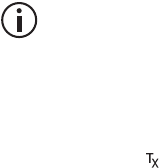
104 Operating in conventional mode
Adding or deleting member channels of a
group
Your radio may be programmed so you can add or
delete channels in a voting or scanning group.
Changes made are permanent, and will remain after
restarting the radio.
1Select the group. See "Selecting a scan or voting
group" on page 72.
2Press Edit.
If there is no edit option for the left selection key,
the group cannot be changed.
Alternatively, you may be able to edit groups by
pressing Menu and selecting Advanced >
Program groups, then select the group you wish
to edit.
3In the Edit group menu, choose Add channel or
Delete channel.
4Press Select.
5Press the scroll keys to select the channel that you
want to add or delete.
6Press OK.
If successful, the message Channel added or
Channel deleted appears.
To check the new group details, press Back
and select the Group members menu option.
Changing a group’s transmit channel
You may be able to change the transmit channel of a
standard scanning group. The transmit channel is
identified by the icon.
1Select the group. See "Selecting a scan or voting
group" on page 72.
2Press Edit.
If there is no edit option for the left selection key,
the group cannot be changed.
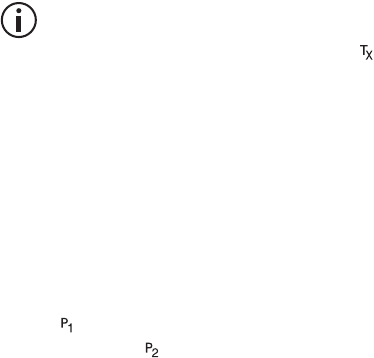
Operating in conventional mode 105
Alternatively, you may be able to edit groups by
pressing Menu and selecting Advanced >
Program groups, then select the group you wish
to edit.
3In the Edit group menu, choose Change tx.
4Press Select.
5Press the scroll keys to select the new transmit
channel.
6Press OK.
If successful, the message Tx channel changed
appears.
To check the new group details, press Back
and select the Group members menu option.
The new transmit channel has the icon next
to it.
Changing a group’s first or second priority
channel
You may be able to change the priority channels of a
scanning group. Priority channels are scanned more
frequently than other channels in the group. If valid
activity is found on another channel, the radio
continues to scan the priority channel or channels at
regular intervals. The first priority channel is identified
by the icon, and the second priority channel is
identified by the icon.
1Select the group. See "Selecting a scan or voting
group" on page 72.
2Press Edit.
If there is no edit option for the left selection key,
the group cannot be changed.
Alternatively, you may be able to edit groups by
pressing Menu and selecting Advanced >
Program groups, then select the group you wish
to edit.
3In the Edit group menu, choose Change P1 or
Change P2.
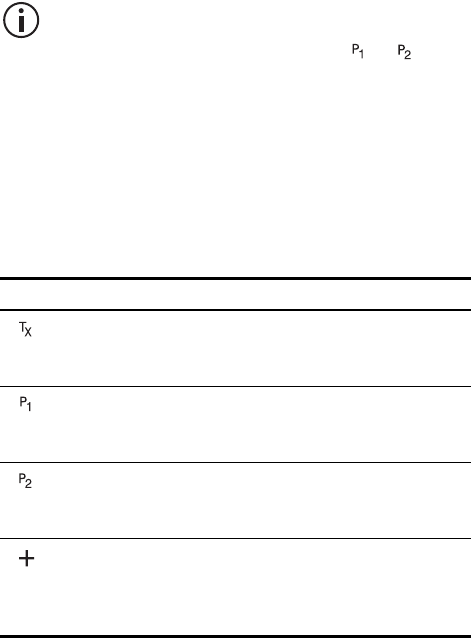
106 Operating in conventional mode
4Press Select.
5Press the scroll keys to select the new priority
channel.
6Press OK.
If successful, the message P1 channel changed or
P2 channel changed appears.
To check the new group details, press Back
and select the Group members menu option.
The new priority channel has the or icon
next to it.
Icon and messages that may appear when
changing group details
The following icons may appear when viewing group
membership details, adding or deleting channels from
a group, or changing a group’s transmit or priority
channels.
Icon Meaning
This channel is used to transmit on when there has
been no recent activity. You cannot delete this
channel (it will not appear under Delete channel).
This channel is the group’s first priority channel. You
cannot delete this channel (it will not appear under
Delete channel).
This channel is the group’s second priority channel.
You cannot delete this channel (it will not appear
under Delete channel).
There is more than one instance of this channel in
the group (the channel will be scanned more often).
If you delete this channel, the radio will attempt to
delete all instances of the channel.

Operating in conventional mode 107
The following messages may appear when using
nuisance delete to temporarily delete a channel from
a group, when adding or deleting channels from a
group, or changing a group’s transmit or priority
channels.
Message Meaning
Scanning not
on
You cannot use nuisance delete to temporarily
delete a channel from a group, as there is no
group currently selected.
No channel
captured
You cannot use nuisance delete to temporarily
delete a channel from the group, as there is no
channel currently captured.
Not enough
channels in
group
You cannot use nuisance delete to temporarily
delete the channel from the group, as the
captured channel is the last remaining group
member.
Cannot delete
channel
You cannot use nuisance delete to temporarily
delete the channel from the group. The captured
channel may be the selected channel in a
background scan group.
Cannot delete
priority chan
You cannot use nuisance delete to temporarily
delete the channel from the group, as the
captured channel is a priority channel.
Only two
channels in
group
You cannot delete a channel from the group, as
there would be only one group member left.
No items
in list
The action you are attempting is not allowed.
Either:
■the group does not have a preset transmit
channel or priority channels programmed, or
■you have added all the channels in the zone
to the current group.
Group full You cannot add any more channels to the group,
as the maximum number of members (50) has
been reached.

108 Operating in trunked mode
7 Operating in trunked
mode
This section explains how your radio operates on a
DMR (digital), MPT (analog) or dual-mode trunked
network.
These features are controlled by software
licenses (SFE) and may not be available with
your radio.
Your radio must have trunking functionality
programmed before it can operate in DMR or
MPT trunked mode.
This section covers:
■Checking that your network is available
■Changing your network
■Making a call using the address book
■Making a preset call
■About trunked zones and workgroups
■About emergency operation
■Dialing a PABX number
■Dialing a PSTN number
■Receiving a call
■Re-establishing a call
■Checking the queue
■About status messages
■About trunked text messages
■Placing the radio in do-not-disturb mode
■Switching to conventional channels or conven-
tional groups

Operating in trunked mode 109
Checking that your network is
available
Check that the orange LED is flashing and the
network icon appears on the display. These are the
indications that your radio has access to a trunked
network.
If the network icon is flashing and No service appears
on the display, your radio is attempting to access the
trunked network. If this icon remains flashing, your
radio may be out of the network coverage area.
If Limited service appears on the display, one of the
network sites or the connection between the network
sites has been interrupted. You can still make calls to
radios covered by the same site but not to radios on
other sites.
Changing your network
Your radio may be programmed to operate in up to
four completely separate trunking networks, either
DMR (digital), MPT (analog) or both (dual mode).
You may wish to change networks because you are
out of the network coverage area, or you need to have
access to another trunking network.
To change your radio’s operating network, you may
be able to either use the Main menu or dial the new
network using the alphanumeric keys.
Changing your radio’s workgroup may also
change the network in which you are operating.
See "Selecting a workgroup" on page 113.
Using the Main menu
1Press Menu and select Change network.
SelectBack
Main menu
Change network
Change mode

110 Operating in trunked mode
2In the Change network menu, scroll through the
list of networks until the network you want appears.
3Press Select.
The radio will restart and display the name of the
new network.
Dialing a new network
This feature is only available for radios with
alphanumeric keys.
1Dial *700# to display the name of the current
trunked network.
2Dial *70n# to change to a new network, where n is
the number of the new network (1 to 4).
The radio will restart and display name of the new
network.
Making a call using the
address book
The Address book menu programmed for your radio
may contain calls to other radios, to PABX extensions
or to PSTN numbers.
Address book calls may also be used to send status
information, such as “at lunch” or “on site”. For more
information, see "Using the address book" on
page 61.
1Press Menu and select Address book.
(Depending on how your radio is programmed, you
may be able to use the scroll keys, left selection
key or a function key to select the Address book
menu.)
SelectBack
Main menu
Address book
Local calls

Operating in trunked mode 111
2In the Address book menu, scroll through the list
of calls until the call you want appears.
3Press Options and Call, or press PTT.
The call details appear on the display, the LED
glows red, and appears on the display.
Making a preset call
The preset calls programmed for your radio may be to
other radios, to PABX extensions or to PSTN
numbers.
1Press Menu and select Preset calls.
(Depending on how your radio is programmed, you
may be able to use a function key, or left selection
key to select the Preset calls menu.)
2In the Preset calls menu, scroll through the list of
calls until the call you want appears, then press
Send.
While the call is being setup, you can cancel the
call by pressing Clear.
Dialing a preset call
This feature is only available for radios with
alphanumeric keys.
It may be possible to dial preset calls, if preset calls
are programmed for your radio and you know the
number associated with the preset call.
1Dial p, where p is the number of the preset call.
SelectBack
Main menu
Preset calls
Set zone

112 Operating in trunked mode
If your preset call number is the same as a call to
another radio, then you need to dial a leading 0.
For example, dial 23# to call radio 23 and dial 023#
for preset call number 23.
2Press Send or the # or PTT key.
While the call is being setup, you can cancel the
call by pressing Cancel.
About trunked zones and
workgroups
Trunked zones and workgroups are used to manage
the calls on the trunked system. Zones, if used,
typically define geographic areas (towns, suburbs or
counties), or branches of an organization.
Workgroups span multiple zones, and typically define
functions, work areas or job roles.
When your radio belongs to a workgroup, it is said to
be ‘subscribed’, and you receive all calls directed to
that group of users. A group’s members are dynamic,
in that a group only contains radios that are currently
registered on the system and subscribed to the
same group.
Your radio may be programmed to use different
names for a ‘zone’ and ‘workgroup’.
For example, ‘district’ or ‘area’ may be used in
place of zone, and ‘role’ or ‘group’ may be used
in place of workgroup.
23
SendClear
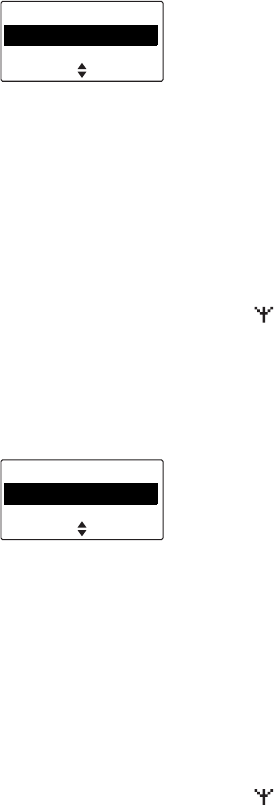
Operating in trunked mode 113
Selecting a zone
1Press Menu and select Set zone.
(Depending on how your radio is programmed, you
may be able to use the scroll keys, left selection
key, 3-way selector, or channel selector to select a
zone.)
2In the Set zone menu, scroll through the list of
zones until the zone you want appears.
3Press Select.
4Check that the network icon appears on the
display.
Selecting a workgroup
1Press Menu and select Set workgroup.
(Depending on how your radio is programmed, you
may be able to use the scroll keys, left selection
key, 3-way selector, or channel selector to select a
workgroup.)
2In the Set workgroup menu, scroll through the list
of workgroups until the workgroup you want
appears.
3Press Select.
4Check that the network icon appears on the
display.
Making a call to a workgroup
Different types of calls may be associated with your
workgroups. These calls can be any types of calls.
SelectBack
Main menu
Set zone
Set workgroup
SelectBack
Main menu
Set workgroup
Go to homegroup
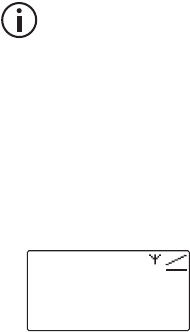
114 Operating in trunked mode
To make a call to a workgroup:
1Select the required zone. See "Selecting a zone"
on page 113.
2Select the required workgroup. See "Selecting a
workgroup" on page 113.
3Press the PTT key, and a call to that workgroup is
made.
Dialing a workgroup call
This feature is only available for radios with
alphanumeric keys.
It may be possible to dial workgroup calls, if you know
the number associated with the workgroup.
1Dial w, where w is the number of the workgroup.
If your workgroup call number is the same as a call
to another radio, then you need to dial a leading 0.
For example, dial 23# to call radio 23 and dial 023#
for workgroup call number 23.
2Press Send or the # or PTT key.
While the call is being setup, you can cancel the
call by pressing Cancel.
Selecting the homegroup
Your ‘homegroup’ is the workgroup in which your
radio usually operates. To return to your homegroup
at any time, you may be able to use the main menu, or
use a function key.
23
SendClear
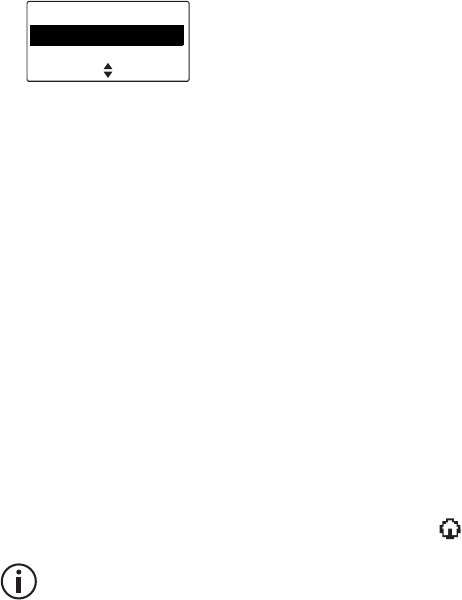
Operating in trunked mode 115
Using the Main menu
1Press Menu and select Go to homegroup.
2Press Select, and the radio now shows your
homegroup in the default display.
Using function keys
You may be able to use function keys to go to your
homegroup or to toggle between your homegroup,
and the currently selected zone and workgroup.
■Press the function key programmed to go to your
homegroup.
The radio now shows your homegroup on the
default display.
■Press the function key programmed to toggle
between your homegroup and the currently
selected zone and workgroup.
The radio now shows your homegroup on the
default display, along with the homegroup icon .
The homegroup icon only appears if you use a
function key to toggle between your homegroup
and the currently selected zone and workgroup.
Scanning workgroups
The ‘My Workgroups’ list comprises the current
workgroup, the homegroup, and other programmed
groups. When scanning is active, the radio will receive
activity from any subscribed groups in the My
Workgroups list.
To activate scanning:
SelectBack
Main menu
Go to homegroup
Scanning

116 Operating in trunked mode
1Press Menu and select Scanning.
(Depending on how your radio is programmed, you
may be able to use a function key to turn scanning
on or off.)
2Scroll to On (or Off) and press Select.
About emergency operation
In an emergency you may be able to summon help by
sending an emergency call. After making the call, your
radio may be programmed to enter emergency mode.
While emergency mode is active, your radio may
cycle between receive and transmit, so that your
dispatcher or the called party can hear any activity
near your radio.
On most networks, an emergency call takes
precedence over other call types, and existing calls
are cleared down so that the emergency call can
proceed.
To make an emergency call from your radio, you may
be able to either:
■use a function key programmed for emergency
mode
■make an emergency call using
■the address book (see "Making a call using the
address book" on page 110)
■a workgroup (see "Making a call to a
workgroup" on page 113)
■a preset (see "Making a preset call" on
page 111)
■dial the emergency call using the alphanumeric
keys
SelectBack
Main menu
Scanning
Send

Operating in trunked mode 117
Dialing an emergency call
Dialing is only available for radios with
alphanumeric keys.
1Dial *9.
2Press Send or the # or PTT key.
An emergency call is now sent to the emergency
location that has been programmed for your radio.
If you wish to send an emergency call to
another radio, you may be able to dial *9*n then
press the # or PTT key. In this case, n is the
radio unit number you wish to send the
emergency call to and may be a two- or three-
digit number.
Activating emergency mode
You can activate emergency mode using a function
key programmed for emergency mode. Alternatively,
you may be able to activate emergency mode using a
hidden switch or panic button. Once emergency mode
is activated, your radio makes an emergency call to
your dispatcher or some other predetermined
location. The radio then enters emergency mode.
While emergency mode is active, your radio may
cycle between receive and transmit, so that your
dispatcher can hear any activity near the radio.
Cancelling emergency mode
Reset the radio to normal operation at any time by
turning the radio off and then on.
Emergency mode may be programmed to end
after a fixed period of time. In this case, there is
no need to turn the radio off and then on in order
to return the radio to normal operation.

118 Operating in trunked mode
Dialing a PABX number
Dialing is only available for radios with
alphanumeric keys.
To dial a PABX extension:
1Dial n, where n is the PABX extension you wish
to call.
2Press Send or the # or PTT key.
The call details appear on the display. While the
call is being setup, you can cancel the call by
pressing Cancel.
Dialing a PSTN number
Dialing is only available for radios with
alphanumeric keys.
To dial a PSTN number:
1Dial 0n, where n is the PSTN number you wish to
call.
The numbers you dial before the 0 depend on
the way your network operates.
2Press Send or the # or PTT key.
The call details appear on the display. While the
call is being setup, you can cancel the call by
pressing Cancel.

Operating in trunked mode 119
Receiving a call
When you receive a call, your radio may:
■automatically accept the call. The icon appears
on the display. The radio may also be pro-
grammed to beep or ring. In this case, the caller
will usually talk first.
■ring like a telephone. Press Answer to accept the
call. The radio gives a beep and the icon
appears in the display. You may also be able to
accept the call if you press the PTT key. In this
case, you will usually talk first.
Once the icon appears, you can proceed with the
call, as follows:
1Hold the microphone about 2 inches (5 cm) from
your mouth.
2Press and hold the PTT key to transmit.
3Speak clearly into the microphone and release the
PTT key when you have finished talking.
While you are transmitting, the LED glows red and
appears in the display.
4End the call by pressing End. The network may
also end the call if neither you nor the other party
transmits for a predetermined time or if your call
time limit is exceeded.
120 Operating in trunked mode
Transmit timer
Your radio may have a transmit timer that limits the
amount of time you can transmit continuously.
When the transmit timer is about to expire, the
message Transmit timeout imminent appears in the
display, the LED flashes red, and the radio gives three
beeps.
If the transmit timer times out, the call clears down.
Call time limit
In trunked mode, the length of your call may be limited
by the network or by your radio. Your radio may be
programmed to display the time remaining for
your call.
Operating in trunked mode 121
Re-establishing a call
The last number recall, unanswered call and callback
functions may allow you to re-establish calls using the
PTT key.
Last number recall
When an outgoing call has ended, the message
Last call to and the called unit’s identity may appear
on the display.
To make a call to that person again, briefly press the
PTT key.
Unanswered call
When an incoming call is missed, the message
Missed call and the caller’s identity may appear in
the display.
To return the call, briefly press the PTT key.
Callback
When an incoming call has been ended, the message
Last call from and the caller’s identity may appear in
the display.
To make a call to that person, briefly press the PTT
key.
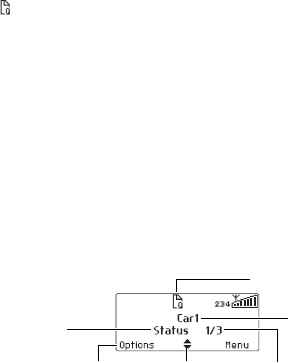
122 Operating in trunked mode
Checking the queue
If you have missed an incoming call or have received
a status message or text message, it may be stored in
the queue. Information about the missed call or
message is shown on the display and the queue icon
appears.
The queue can be programmed to store multiple calls
or messages or just the last call or message.
Your radio may also be programmed to automatically
view the latest status or text message on receipt.
Press Back to exit this view or Delete.
In the example below, a status message was received
from Car 1. This is the first of three calls or messages
stored in the queue.
If there are calls or messages in the queue, the radio
may emit a warble tone for a period of time.
The notification starts again when the radio is
restarted or another call is received.
Accessing the queue
1Use the scroll keys to move through the calls or
messages in the queue until the item you want
appears.
2Press Options.
The options available depend on the type of call it
is. For a voice call, select Call to return the call.
identity of last
unanswered caller
scroll through
the calls
type of call
position in the queue
(not for single-item
queue)
options available
depend on type of
call
queued calls or messages
Operating in trunked mode 123
For a status message or a text message, select
View to read the message, Reply to reply, or Call
to return the call.
Your radio may be programmed to automatically view
status updates and text messages on receipt.
You can also delete the selected call or messages, or
delete all queued calls and messages.
Changing your queue settings
Your radio may be programmed so that you are able
to change queuing between “unanswered” and “full”.
In “unanswered” queuing, incoming individual voice
calls are only queued if unanswered.
In “full” queuing, incoming individual voice calls are
queued immediately and you don’t get an option to
answer the call.
In both cases, all status and text messages are
queued immediately.
If your radio has alphanumeric keys, you may be able
to change your call queuing setting using the keypad.
To activate “full” queuing:
■press Menu and select Radio settings > Call
settings > Call queuing and choose On,
■press the function key programmed for Call queu-
ing, or
■dial *48 then press the # or PTT key.
The message Call queuing activated appears.
To change call queuing to “unanswered” queuing:
■press Menu and select Radio settings > Call
settings > Call queuing and choose Off,
■press the function key programmed for Call queu-
ing, or
■dial #48 then press the # or PTT key.
The message Call queuing deactivated appears.
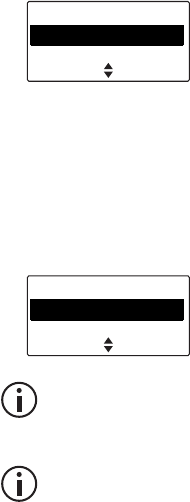
124 Operating in trunked mode
About status messages
A status message is sent to another party to indicate
your current activity or location, such as “en route” or
“at lunch”. If the radio receiving your message has
been programmed with the same status messages, it
will decode and display your message. If you receive
a status message, the message is automatically
queued, since a response is not expected.
Selecting a status message
1Press Menu and select Send > Status.
2In the Status menu, scroll through the list of status
messages until the message you want appears.
Sending a status message
1When you have chosen a message, press Send
and the Send to menu opens.
2In the Send to menu, scroll through the list of
options until the choice you want appears.
If your radio has alphanumeric keys, you can
choose the option Dialed, then dial the number
of the party you wish to call.
If you select Address book or Preset, scroll to
the entry you want and press Select.
3Press Select.
The call details appear on the display. While the
call is being setup, you can cancel the call by
pressing Cancel.
OptionsBack
Status
On site
In transit
SelectBack
Send to
Dispatcher
Address book
Operating in trunked mode 125
Dialing a status message
If your radio has alphanumeric keys, the status
messages programmed for your radio can be dialed.
To dial the message, you need to know the number
associated with the status message.
To dial a status message:
1Dial *0s*n, where s is the number of the status
message and n is the radio unit number you wish
to send the message to.
2Alternatively, dial *0s*p, where p is the number of
a preset call or workgroup. See "Dialing a preset
call" on page 111 or "Dialing a workgroup call" on
page 114 for more information.
3Press Send or the # or PTT key.
The call details appear on the display. While the
call is being setup, you can cancel the call by
pressing Cancel.
Receiving a status message
If the radio is programmed for call queuing, incoming
status messages are added to the queue. For more
information, see "Checking the queue" on page 122.
Press Options and select whether to reply, call or
delete.
Your radio may be programmed to automatically view
status messages on receipt.
If the radio is not programmed for call queuing,
incoming status messages will not be stored or
displayed.
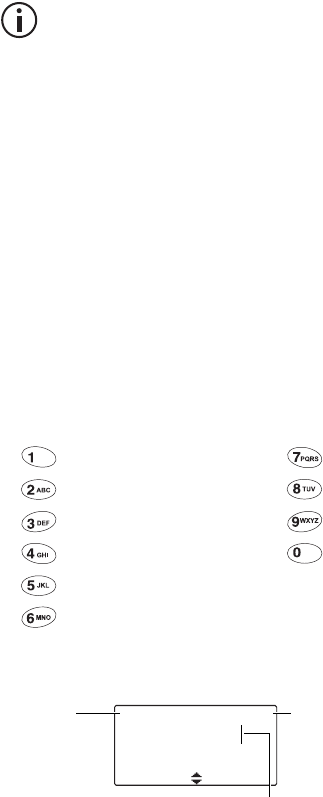
126 Operating in trunked mode
About trunked text messages
Your radio may be programmed so that you can send
text messages. The three options for creating text
messages are selecting a preset text message,
editing a draft text message, or creating a new text
message.
To either edit or enter a text message, your
radio must have alphanumeric keys.
Using the alphanumeric keys to enter text
When the alphanumeric keys are used to enter a text
message, they have special functions.
■Use the # key to select the type of text entry:
upper and lower case characters (ABC, abc), ini-
tial capitals (Abc), or numbers (123).
■Use the left selection key (Clear) to delete a char-
acter from the display.
■Use the scroll keys to move through a message.
Repeated presses of these keys will give you the
characters shown in the following table.
In the example below, a preset text message has
been selected, and is being edited.
Key Characters Key Characters
.,?!-/1 PQRS7
ABC2 T UV8
DEF3 WX Y Z 9
GHI 4 space 0
JKL5
MNO6
Options
Contact base now|
C lea r
abc 16/100
currently
selected text
entry option
(lower case)
number of characters
used/total number of
characters allowed
cursor: shows current point of text entry

Operating in trunked mode 127
Sending a preset text message
1Press Menu and select Send > Text message >
Preset message.
In the Preset message menu, a short label
representing each message is displayed.
2Scroll through the list of preset message labels
until the one you want appears.
3Press Select, and the text message you have
chosen is now displayed.
4Press Send to send the message, or Edit to
change the message.
Pressing will place the cursor at the start of
the message. Pressing will place the cursor
at the end of the message. When the message is
complete, press Options and select Send.
Creating a new text message
1Press Menu and select Send > Text message >
New message.
2Use the alphanumeric keys to add characters and
the Clear key to delete them. Use the scroll keys to
move through the characters.
SelectBack
Text message
Preset message
Edit message
SelectBack
Preset message
Contact
Site
Send
Contact base now
Back Edit
Options
On site|
Clear
abc 7/100

128 Operating in trunked mode
3When the message is complete, press Options
and select Send.
If you decide to cancel out of editing a text message
or receive a call while editing, the current draft will be
saved and is available for editing later.
Editing a draft text message
1Press Menu and select Send > Text message >
Edit message.
The last sent or edited text message will appear.
2Use the scroll keys to move through the
characters. Use the alphanumeric keys to add
characters and the Clear key to delete them.
3When the message is complete, press Options
and select Send.
If you decide to cancel out of editing a text message
or receive a call while editing, the current draft will be
saved and is available for editing later.
Sending a text message
1When you have finished editing the message,
press Options and the Text options menu opens.
2In the Text options menu, select Send.
3In the Send to menu, scroll through the list of
options until the choice you want appears.
Options
On site|
Clear
abc 7/100
SelectBack
Text options
Send
Cancel sending
SelectBack
Send to
Dispatcher
Address book

Operating in trunked mode 129
If your radio has alphanumeric keys, you can
choose the option Dialed, then dial the number
of the party you wish to call.
If you select Address book or Preset, scroll to
the entry you want and press Select.
4Press Select.
The call details appear on the display. While the
call is being setup, you can cancel the call by
pressing Cancel.
Receiving a text message
If the radio is programmed for call queuing, incoming
text messages are added to the queue. For more
information, see "Checking the queue" on page 122.
Press Options and select whether to reply, call or
delete.
Your radio may be programmed to automatically view
text messages on receipt.
If the radio is not programmed for call queuing,
incoming text messages will not be stored or
displayed.
Placing the radio in
do-not-disturb mode
If you do not want calls for a while, you can place the
radio in do-not-disturb mode, so that incoming calls
can be ignored. You can make outgoing calls in the
usual way.
While do-not-disturb mode is active, incoming
calls cannot be stored in the call queue.
Using a function key
1Press the function key programmed for do not
disturb, to activate the do-not-disturb function.
130 Operating in trunked mode
The message Do not disturb activated appears
on the display. Your radio will now ignore all
incoming calls.
2To deactivate the do-not-disturb function, press
the do-not-disturb function key again.
The message Do not disturb deactivated
appears on the display.
Using the Main menu
1Press Menu and select Radio Settings >
Call Settings > Do not disturb.
2In the Do not disturb menu, choose On.
3Press Select.
The message Do not disturb activated appears
on the display. Your radio will now ignore all
incoming calls.
Switching to conventional
channels or conventional
groups
You may be able to dial conventional channels or
groups, using 101 to 110. The channels or groups
called using these numbers are programmed for your
radio.
To call a conventional channel or group:
1Dial the number for the channel or group you wish
to call.
2Press Send or the # or PTT key.
Your radio switches to the conventional channel
programmed for that number.
Dialing calls in trunked mode 131
8 Dialing calls in trunked
mode
If your radio has alphanumeric keys, you can make
dialed calls from your radio. The numbers you dial and
dialing features available depend on the way your
radio is programmed and the way your network
operates. Contact your radio provider for further
assistance.
This section covers:
■MPT 1343 dialing
■DMR dialing
■Nokia ANN fleet calls
■Accessing common trunking functions

132 Dialing calls in trunked mode
MPT 1343 dialing
If your MPT or DMR trunked network uses the MPT
1343 dialing scheme, your radio’s unique number on
the network consists of:
■a three-digit prefix,
■a four-digit fleet number, and
■a two- or three-digit radio unit number.
You may also be part of a group, with a two- or three-
digit group number.
Finding your radio’s MPT number
To find your radio’s full MPT number:
1Dial *700.
2Press the # or PTT key.
The name associated with your network and your
radio’s full MPT number appears.
The number is in the form:
Radio unit number
234
Prefix
300
Fleet
3078
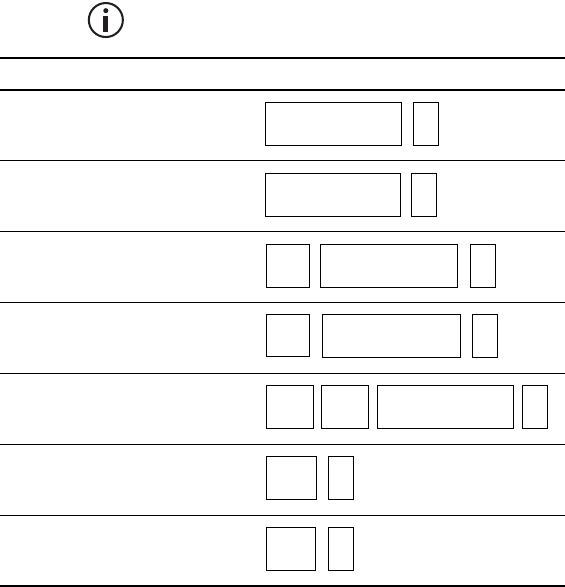
Dialing calls in trunked mode 133
MPT 1343 dialed calls
The following table summarizes the way you dial calls
to other radios and groups of radios using the MPT
1343 dialing scheme, and gives an example of each
type of call.
In the following examples, the final # may be
replaced by a short press of the PTT key.
Call to Dialing code and example
Radio 23 in the same fleet
as you
Radio 234 in the same fleet
as you
Radio 23 in fleet 3078 with the
same prefix as you
Radio 234 in fleet 3078 with
the same prefix as you
Radio 234 in fleet 3078 with a
different prefix to you (300)
Group 92 in the same fleet
as you
Group 923 in the same fleet
as you
Radio unit number
23 #
Radio unit number
234 #
Fleet
3078
Radio unit number
23 #
Fleet
3078 #
Radio unit number
234
Prefix
300
Radio unit number
234 #
Fleet
3078
Group
92 #
Group
923 #

134 Dialing calls in trunked mode
DMR dialing
If your trunked network uses the DMR dialing scheme,
your radio’s unique number on the network consists
of:
■a three-digit prefix
■a two-digit fleet number, and
■a three-digit unit number
You may also be part of a group, with a three-digit
group number.
Finding your radio’s DMR number
To find your radio’s full DMR number:
1Dial *700.
2Press the # or PTT key.
The name associated with your network and your
radio’s full DMR number appears.
The number is in the form:
Radio unit number
542
Prefix
330
Fleet
78
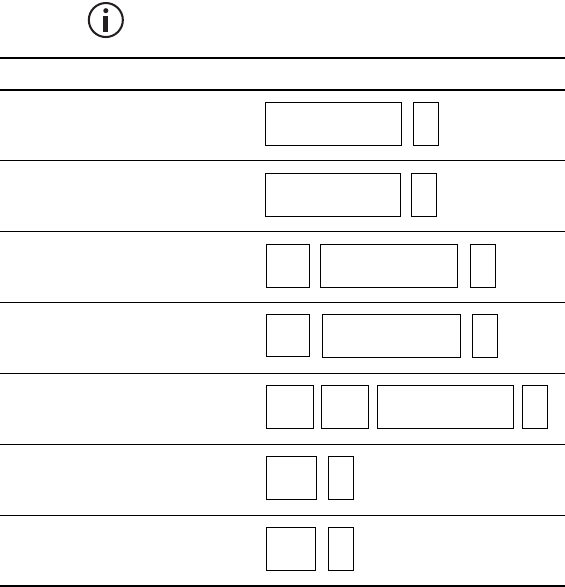
Dialing calls in trunked mode 135
DMR dialed calls
The following table summarizes the way you dial calls
to other radios and groups of radios using the DMR
dialing scheme, and gives an example of each type of
call.
In the following examples, the final # may be
replaced by a short press of the PTT key.
Call to Dialing code and example
Radio 332 in the same fleet
as you
Radio 521 in the same fleet
as you
Radio 332 in fleet 78 with the
same prefix as you
Radio 521 in fleet 78 with the
same prefix as you
Radio 332 in fleet 78 with a
different prefix to you (350)
Group 990 in the same fleet
as you
Group 923 in the same fleet
as you
Radio unit number
332 #
Radio unit number
521 #
Fleet
78
Radio unit number
332 #
Fleet
78 #
Radio unit number
521
Prefix
350
Radio unit number
332 #
Fleet
78
Group
990 #
Group
923 #

136 Dialing calls in trunked mode
Nokia ANN fleet calls
If your trunked network uses Nokia ANN dialing, the
numbers you dial depend on your fleet size. Fleets are
defined as either large, small or mini. Your radio’s
unique number on the network consists of:
■a lead number 7, 8 or 9, depending on the fleet
size,
■a zero-, one-, two- or three-digit prefix,
■a one- or two-digit fleet number, and
■a two- or three-digit radio unit number.
See your radio provider or network administrator for
Nokia ANN call details.
Finding your radio’s Nokia ANN number
To find your radio’s full Nokia ANN number:
1Dial *700.
2Press the # or PTT key.
The name associated with your network and your
radio’s full Nokia ANN number appears.
The number is in the form:
Radio unit number
209
Prefix
34
Fleet
2
Lead
7
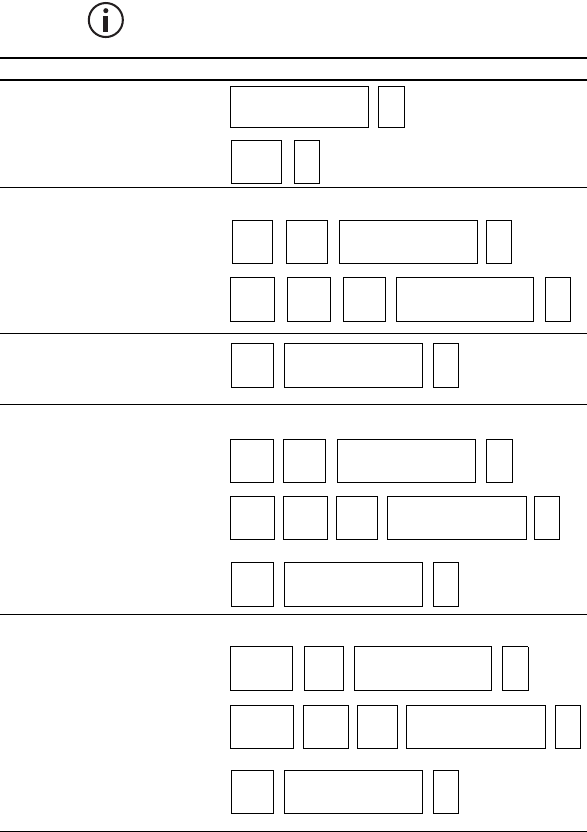
Dialing calls in trunked mode 137
Nokia ANN dialed calls
The following table summarizes the way you dial calls
to other radios and gives an example of each type of
call.
In the following examples, the final # may be
replaced by a short press of the PTT key.
Call to Dialing code and example
Radio 23 in the same fleet
as you
Group 923 in the same
fleet as you
Large fleet:
Call to radio 234 in fleet 1
with the same prefix as you
Call to radio 235 in fleet 2
with a different prefix to
you (32)
Call to radio 236 in fleet 2
with the same lead and
prefix1
Small fleet:
Call to radio 23 in fleet 51
with the same prefix as you
Call to radio 24 in fleet 52
with a different prefix to
you (126)
Call to radio 25 in fleet 53
with the same lead and
prefix1
Mini fleet:
Call to radio 23 in fleet 80
with the same prefix as you
Call to radio 24 in fleet 81
with a different prefix to
you (3)
Call to radio 25 in fleet 81
with the same lead and
prefix1
1. If 4-digit-dialing is configured in the programming application.
Radio unit number
23 #
Group
923 #
#
Radio unit number
234
Fleet
1
Lead
7
Lead
7#
Radio unit number
235
Prefix
32
Fleet
2
#
Radio unit number
236
Fleet
2
Lead
7#
Radio unit number
23
Fleet
51
Lead
7#
Radio unit number
24
Prefix
126
Fleet
52
#
Radio unit number
25
Fleet
53
Lead
7, 8 or 9 #
Radio unit number
23
Fleet
80
Lead
7, 8 or 9 #
Radio unit number
24
Prefix
3
Fleet
81
#
Radio unit number
25
Fleet
81
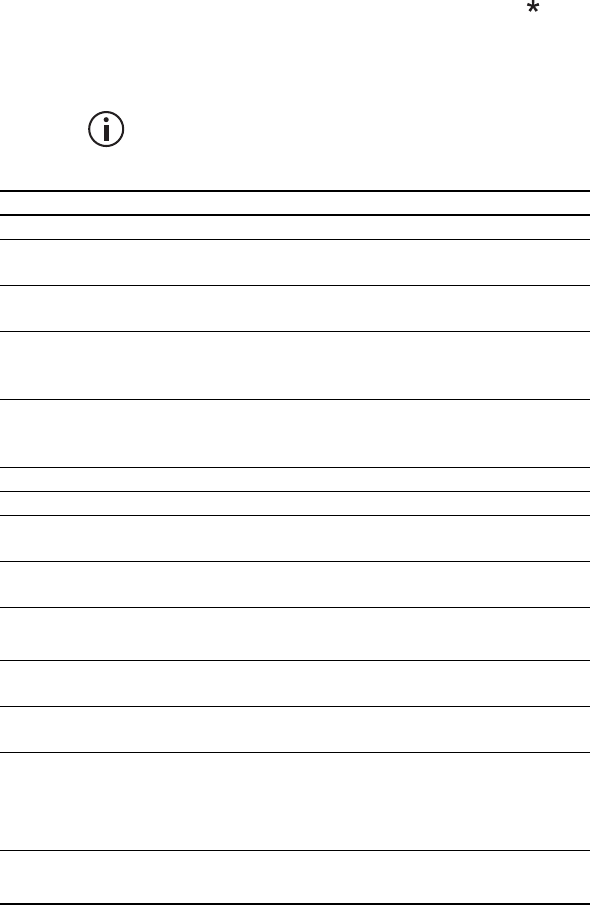
138 Dialing calls in trunked mode
Accessing common trunking
functions
The following tables explain how you can access
special MPT or DMR trunking functions using the
and # keys. The availability of these functions is
dependant on the way your radio is programmed and
the way your network operates.
In the following examples, the final # may be
replaced by a short press of the PTT key.
*... # functions
Dialing code Functions Example
#Accept an incoming FOACSU call
*# Clear call or displayed item, or decline an incoming
FOACSU call
*0#
#0#
Request base dispatcher to call you back
Cancel request
*0*n#
#0*n#
Request another dispatcher to call you
back
Cancel request
*0*234#
#0*234#
*0s*n#
*0s#
Status call to radio n (s = status 0
to 31, MPT, or 0 to 127, DMR)
Status call to dispatcher
*015*23#
*015#
g# Conference call to group g 92#
*11*g# Broadcast call to group g *11*92#
*41*n#
#41#
Divert own calls to radio n
Cancel divert
*41*23#
*41*0n#
#41#
Divert own calls to PSTN n
Cancel divert
*41*03456798#
*44*n*m# 1Divert 3rd party calls n to m *44*23*21#
44*n# 1Cancel divert of 3rd party calls #44*23#
*441*m#
#441#
Divert of speech calls to m
Cancel divert of speech calls
*441*21#
#441#
*442*m#
#442#
Divert of packet data calls to m
Cancel divert of packet data calls
*442*21#
#442#
*451# Cancel incoming call diversions (speech only)
*452# Cancel incoming call diversions (packet data only)
*453# 2Cancel incoming call diversions (SDM only)
*454# 2Cancel incoming call diversions (status only)
*46# 3Toggle encryption
*461# 3Turn encryption off

Dialing calls in trunked mode 139
*462# 3Turn encryption on
*47# 3Display the current network and your full radio number
*48#
#48#
Queue incoming calls
Cancel queue
*49#
#49#
Do not disturb
Cancel do not disturb
*491#
#491#
DMR: Do not disturb (SDM calls)
MPT: Do not disturb ( voice calls only)
DMR: Cancel do not disturb (SDM calls)
MPT: Cancel do not disturb ( voice calls only)
*492#
#492#
Do not disturb — data calls only
Cancel do not disturb — data calls only
*50*n# 1 Select channel n (site-select diagnostic function, enabled
during programming)
*50*xnnnnn#2Select channel xnnnn, where x is the logical channel and
nnnn is the physical channel (site-select diagnostic
function, enabled during programming)
#50# Resume normal channel hunting (site-select diagnostic
function, enabled during programming)
*700# Display the current network and your full radio number
*70n# Change to network n (1 to 4) *702#
*8*n# 4Priority call (highest) to radio n *8*23#
*8*g# 4Priority conference call (highest) to
group g *8*923#
*81*n# 4Priority call (highest) to radio n*81*23#
*81*g# 4Priority conference call (highest) to
group g*81*923#
*82*n# 4Priority call (high) to radio n*82*23#
*82*g# 4Priority conference call (high) to group
g*82*923#
*83*n# 4Priority call (medium) to radio n*83*23#
*83*g# 4Priority conference call (medium) to
group g*83*923#
*9*n# Emergency call to radio n *9*23#
*9*g# Emergency conference call to group g *9*923#
**n# 1Abbreviated dialed codes (1-49) **3#
1. MPT only.
2. DMR only.
3. DMR dialing scheme only
4. DMR has three priority levels and MPT has one priority level.
*8 and *81 are interchangeable. Dialing *82 or *83 in MPT mode has the same
effect as dialing *8 or *81.
*... # functions
Dialing code Functions Example

140 Location services
9 Location services
This section explains how to use the location services
that may be available on your radio.
This feature is controlled by a software license
(SFE) and may not be available with your radio.
This section covers:
■About location information
■About location statuses
■Viewing location information

Location services 141
About location information
While you may be able to view your location
information on analog channels, sending location
information is only available for digital channels.
If your radio is connected to the receiver of a satellite
navigation system, you can view location information
such as latitude and longitude, true course, speed,
and coordinated universal time. Your radio can also
display universal transverse mercator (UTM)
information such as the UTM zone, and northing and
easting coordinates.
Your radio may also be set up to send or receive and
log location information.
About location statuses
In the Own location screen, location status
information appears at the top right of the display.
■Trk: the receiver is displaying up-to-date satellite
information.
■stored: the receiver is having trouble connecting
to satellites and the radio is displaying stored
information that may not be current.
■no cnx: the radio has lost serial communications
with the receiver.
Your radio configuration may include the Send option.
This option is a digital feature, and is only available on
digital channels.
Zone: 55 Trk
Easting: 321025
Northing: 5812578
SendExit
location status
information
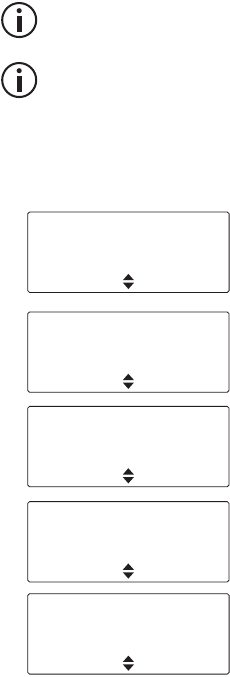
142 Location services
Viewing location information
1Press Menu and select Location Svs > Own
location.
(Depending on how your radio is programmed, you
may be able to press a function key to access the
Own location menu.)
Location information is now shown in the display, if
it is available.
Your radio may be programmed to show any of
these displays, in any order.
Immediately after the radio is turned on,
location reporting is set to all zeros, until the first
satellite fix is achieved.
2Use the scroll keys to scroll though the
Own location displays.
Zone: 59 Trk
Easting: 321025
Northing: 5812578
Exit
■Zone: UTM zone number
■Easting and Northing: Raw
Universal Transverse Mercator
(UTM) Cartesian coordinates
Location Trk
S 43°29'00.0''
E 172°33'05.0''
Exit
■Latitude and longitude in degrees,
minutes and decimal seconds
Location Trk
S 43°29.000''
E 172°33.083''
Exit
■Latitude and longitude in degrees,
minutes and decimal minutes (to
three decimal places)
Location Trk
S 43.488326°
E 172.563255°
Exit
■Latitude and longitude in decimal
degrees
Location Trk
Course: 010°
Speed: 045 km/h
Exit
■The radio’s current course and
speed
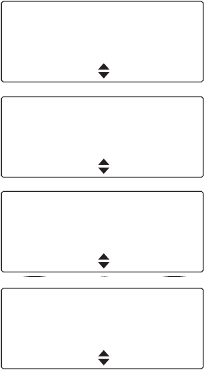
Location services 143
3Press Exit to exit the location display.
In certain situations, your radio may automatically exit
the location display.
Location Trk
UTC time: 23:36:20
Exit
■UTC: Coordinated Universal Time
24 hour clock
Location Trk
Altitude: 34m
Exit
■The radio’s altitude in metres
above or below mean sea level
MGA: Trk
Zone: 29N
PJ264837
Exit
■MGA: Map Grid of Australia
coordinate system
■Zone: UTM zone number
■PJ: The grid square
■264837: Easting and Northing to
the nearest 100 m
MGRS: Trk
59G PM
26406 83789
Exit
■MGRS: Military Grid Reference
System
■59G: UTM zone and band
■PM: The grid square
■26406 83789: Easting and
Northing to the nearest 1 m

144 Loneworker monitoring
10 Loneworker monitoring
Loneworker monitoring is a safety feature for people
who work alone. Loneworker monitoring may be
programmed to be on or off at all times, or can be
switched on and off by the user using a programmed
function key or the menu.
A loneworker alarm is activated if for a predetermined
period of time:
■the radio has been tilted by more than 60 degrees
(man down)
■the radio has not moved
■there has been no user activity
Your radio may be programmed to respond to a
combination of these events.
When the predetermined time has expired, an audible
warning is given and you have a predetermined time
to respond to the loneworker situation.
If you are unable to respond, the radio either enters
emergency mode or (in trunked mode) sends a status
update to a predetermined person or talkgroup.
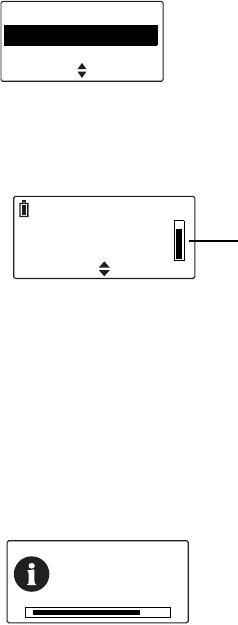
Loneworker monitoring 145
Activating loneworker
monitoring
1Press Menu and select Radio Settings > Extra
features > Loneworker. (Depending on how your
radio is programmed, you may be able to press a
function key to turn loneworker monitoring on and
off.)
2In the Loneworker menu, choose On.
A vertical scroll bar on the right-hand side of the
display indicates the remaining activity timeout.
Responding to a loneworker
alarm
If you hear a beep to indicate that the radio is
expecting a response from you to acknowledge that
you are safe. The message “Loneworker awaiting”
and a horizontal scroll bar appear indicating the
remaining time until an emergency action is triggered.
■Press any key.
■Move the radio
■If using the man down feature, restore the radio to
an upright position.
SelectBack
Extra features
Loneworker
Channel 12
Menu
remaining
activity
timeout
Loneworker
awaiting
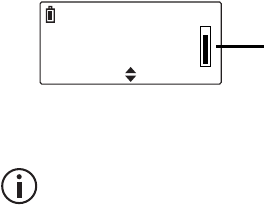
146 Loneworker monitoring
Otherwise the radio will activate emergency mode or
(in trunked mode) send a status update.
Delaying the emergency action
(conventional mode only)
In conventional mode, an additional emergency entry
delay may be programmed which allows you to press
a scroll key within a programmed time (usually 10
seconds) after the response time expires to delay the
emergency action.
You now have the opportunity to turn the radio off and
on to cancel the loneworker alarm.
The emergency action can be delayed only
once.
Channel 12
Menu
emergency
entry delay
timeout

Encryption 147
11 Encryption
This section describes how to use encryption to make
your communications completely private.
This feature is controlled by a software license
(SFE) and may not be available with your radio.
This section covers:
■About encryption
■Encrypting calls
■Making an encrypted call
■Receiving an encrypted call
■Removing encryption keys from the radio
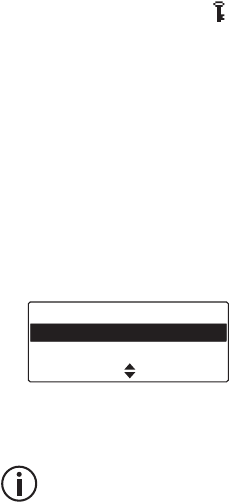
148 Encryption
About encryption
The encryption feature is available for digital and
dual-mode networks only.
To make communications with other users on your
system completely private, your radio may be able to
encrypt outgoing calls, using a confidential encryption
key. The radio receiving your call must have the same
encryption key installed before it can hear your
encrypted call.
Encrypting calls
Your radio may be able to turn encryption on and off.
While encryption is on, your outgoing calls are
encrypted on networks programmed for encryption,
and the encryption icon remains in the display.
This setting only affects outgoing calls. Incoming calls
will still be decoded by your radio so long as the key
required to decode the call is stored in your radio.
To turn encryption on or off:
1Press Menu and select Security > Encryption.
(Depending on how your radio is programmed, you
may be able to press a function key to turn
encryption on and off.)
2Scroll to On (or Off) and press Select.
The message Encryption activated
(or deactivated) appears in the display.
If you attempt to transmit with encryption turned
on but don’t have any keys loaded, the
message Key fail appears.
Encryption
On
Off
SelectBack
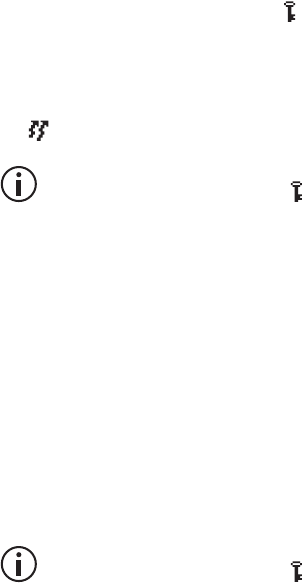
Encryption 149
Making an encrypted call
1Select the network you wish to operate on.
2Check that encryption is on ( is showing in
the display).
3Press and hold the PTT key to transmit.
While you are transmitting, the LED glows red and
appears in the display.
If you transmit or receive an unencrypted call on
an encrypted network, the disappears and
your radio may be programmed to issue an
audible alert.
Receiving an encrypted call
When you receive an encrypted call, your radio
unmutes and you can hear clear speech, so long as
the key required to decode the call is stored in
your radio.
If the key required to decode the call is not stored in
your radio, then your radio remains muted and the
message Key fail appears.
If you transmit or receive an unencrypted call on
an encrypted network, the disappears and
your radio may be programmed to issue an
audible alert.

150 Encryption
Removing encryption keys from
the radio
It may be possible for you to delete encryption keys
from your radio.
Warning When emergency mode is activated, or
when your radio is immobilized (‘inhibited’), your
encryption keys may be automatically deleted from
your radio.
If you attempt to transmit with encryption turned
on but don’t have any keys loaded, the
message Key fail appears.
Deleting an encryption key
1Press Menu and select Security > Zeroize key.
2Scroll to the key you want and press Select.
The message Single key zeroized briefly appears
in the display.
Deleting all encryption keys
1Press Menu and select Security > Zeroize all.
The message Zeroize all keys? appears in
the display.
2Press OK and the message All keys zeroized
briefly appears in the display and no longer
appears.

Customizing radio settings 151
12 Customizing radio
settings
This section describes the ways in which you can
customize your radio.
These features are common to radios operating
in either trunked or conventional mode.
This section covers:
■Changing the volume of all audible indicators
■Changing the volume of keypress tones
■Changing to quiet operation
■Changing to silent operation
■Turning on backlighting
■Adjusting the display contrast

152 Customizing radio settings
Changing the volume of all
audible indicators
You can set the volume of all the audible indicators to
either high or low. Audible tones include incoming call
tones, warning tones and confirmation tones.
To change the volume of your radio’s audible tones:
1Press Menu and select Radio settings >
Alert settings > Indicator level.
(Depending on how your radio is programmed, you
may be able to press a function key to change the
level of indicators.)
2Scroll to High (or Low) and press Select.
Changing the volume of
keypress tones
Whenever you press the radio keys, the keypress
tones give you an audible indication as to whether or
not your action is allowed. A short, medium-pitched
beep indicates that an action is allowed. A long, low-
pitched beep indicates that the action is not allowed.
To change the volume of your radio’s keypress tones:
1Press Menu and select Radio settings >
Alert settings > Keypress tones.
2Scroll to either Off, Low or High and press Select.
SelectBack
Alert settings
Indicator level
Keypress tones
SelectBack
Alert settings
Keypress tones
Quiet operation
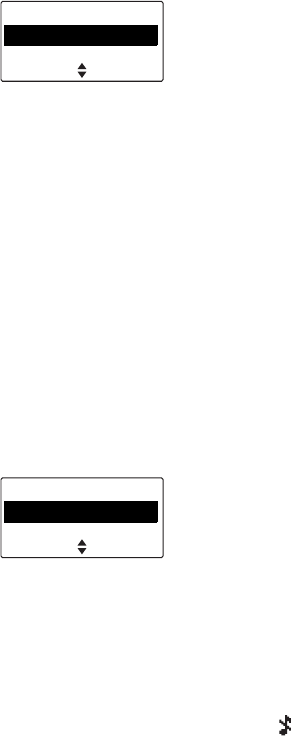
Customizing radio settings 153
Changing to quiet operation
When quiet operation is on, keypress tones and
confirmation tones are turned off. Incoming call tones,
signaling tones and warning tones all remain audible.
To turn quiet operation on or off:
1Press Menu and select Radio settings >
Alert settings > Quiet operation.
(Depending on how your radio is programmed, you
may be able to press a function key to toggle quiet
operation on and off.)
2Scroll to On (or Off) and press Select.
Changing to silent operation
When silent operation is on, all the radio’s audible
tones are turned off, and only channel traffic can be
heard.
To turn silent operation on or off:
1Press Menu and select Radio settings >
Alert settings > Silent operation.
2In the Silent operation menu, scroll to either On or
Off and press Select.
(Depending on how your radio is programmed, you
may be able to press a function key to toggle silent
operation on and off.)
While silent operation in on, the icon appears in
the display.
SelectBack
Alert settings
Quiet operation
Silent operation
SelectBack
Alert settings
Silent operation
External alert

154 Customizing radio settings
Turning on backlighting
Whenever a key is pressed or a call is received, the
keypad and display light up automatically.
Backlighting only remains on for a few seconds,
unless there is further radio activity. When
backlighting is turned on, it remains on until the setting
is changed to Off, regardless of radio activity.
To turn backlighting on or off:
1Press Menu and select Radio settings >
Display settings > Backlighting.
(Depending on how your radio is programmed, you
may be able to press a function key to toggle
backlighting on and off.)
2Scroll to either On or Off and press Select.
Turning backlighting on momentarily
You may be able to use a programmed function key to
turn backlighting on momentarily.
■Press the assigned function key to turn backlight-
ing on. Backlighting remains on for a few seconds,
and then turns off.
Alternatively, the function key may be programmed
so that:
■a short key press turns backlighting on momen-
tarily, and
■a long key press turns backlighting on, and it
remains on until there is a further long key press.
SelectBack
Display settings
Backlighting
Contrast adjust
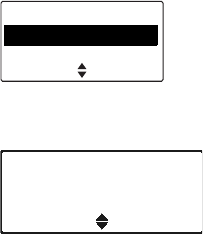
Customizing radio settings 155
Adjusting the display contrast
To change the contrast of your radio display to suit the
lighting conditions that you are working in:
1Press Menu and select Radio settings >
Display settings > Contrast adjust.
2Use the scroll keys to adjust the display contrast to
the level you want.
3Press Save to save this setting.
SelectBack
Display settings
Contrast adjust
RSSI
Use scroll keys
to adjust
SaveCancel
156 Charging and caring for batteries
13 Charging and caring for
batteries
This section describes how to charge your Tait radio
battery as well as care for it, to ensure safe operation,
maximum performance and prolonged battery life.
This section covers:
■About the chargers
■6-way charger safety information
■Special conditions when using IS/NI radios
■Before using the charger
■Charging temperatures
■Leaving the battery on charge
■Receiving calls while charging (not for battery-only
vehicle charger)
■Low battery warning
■Inserting the radio into the vehicle charger
■Charging a battery for the first time
■Charging a battery
■LED behavior
■Removing the battery from the charger
■Maintaining battery life and performance
■Storing batteries
■Disposing of batteries
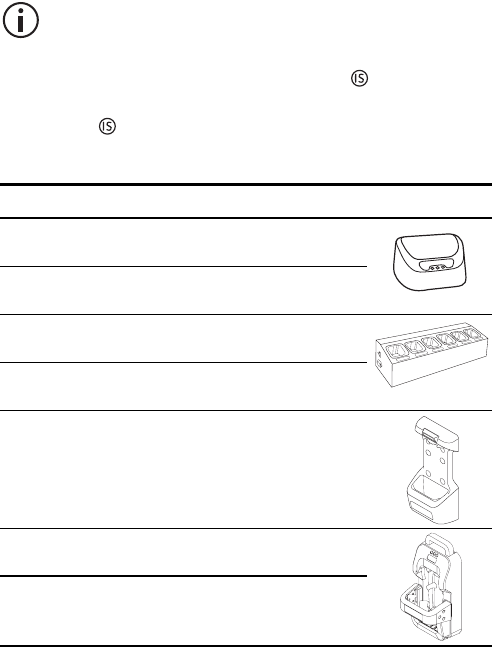
Charging and caring for batteries 157
About the chargers
Unless otherwise indicated, the charging advice and
instructions in this document apply to all chargers.
The following chargers are available for your Tait
radios and batteries:
Chargers for intrinsically safe (IS) and non-
incendive (NI) batteries contain circuitry for the
protection of IS/NI batteries. These chargers
are marked with an IS circle logo .
IS/NI radios are also marked with an IS circle
logo .
IS/NI batteries are identified on their labels.
IS/NI batteries can only be charged in the chargers for
IS/NI batteries. However, all chargers can charge
non-IS/NI batteries.
Part number range Designation
T03-00012-xxxx Desktop charger for
non-IS/NI batteries
T03-22011-Bxxx Desktop charger for
IS/NI batteries
T03-00013-xxxx 6-way charger for
non-IS/NI batteries
T03-22011-Cxxx 6-way charger for
IS/NI batteries
T03-00014-AAAA Battery-only vehicle
charger for non-IS/
NI batteries
T03-00014-Bxxx Vehicle charger for
non-IS/NI batteries
T03-22011-Dxxx Vehicle charger for
IS/NI batteries

158 Charging and caring for batteries
6-way charger safety
information
Warning This device must be connected to an
earthed mains socket-outlet.
Norsk (no): Apparatet må tilkoples jordet stikkontakt.
Suomi (fi): Laite on liitettävä suojamaadoitus-
koskettimilla varustettuun pistorasiaan.
Svenska (sv): Apparaten skall anslutas till jordat
uttag.
Special conditions when using
IS/NI radios
Intrinsically safe (IS) and non-incendive (NI) radios
and accessories are certified by a third party to be
safe to use in particular hazardous locations, or in
potentially explosive atmospheres.
Warning Explosion hazard! Use only a Tait-
supplied, IS/NI approved battery and charger with an
IS/NI radio. Fitting a battery or using a charger that is
not IS/NI-approved creates a risk of explosion which
could cause serious injury or death. For an up-to-date
list of approved accessories, contact your regional Tait
office.
Warning Explosion hazard! Do not charge the
battery in a hazardous location. An explosion could
cause serious injury or death.
For detailed information about IS/NI radios and
accessories, refer to the Safety and Compliance
Information provided with the radio:
■MPD-00013-xx for TP9300 and TP9400 with
ATEX and IECEx certification
■MPD-00027-xx for TP9300 and TP9400 with AEx,
Ex, and non-incendive certification.

Charging and caring for batteries 159
Before using the charger
Check the battery label and charger label to see if the
charger is compatible with the battery. See also
"About the chargers" on page 157.
Warning Handle the battery safely. Failure to
observe the following handling recommendations
could result in personal injury and/or equipment
damage.
■Before using a Li-ion battery, read the Li-ion Bat-
tery Safety Information (MPD-00024-xx for IS-bat-
teries and MPC-00006-xx for non-IS batteries)
included with your battery, and follow the instruc-
tions it provides. Incorrect use of a Li-ion battery
can cause explosion or fire.
■Do not short-circuit the battery contacts, neither
intentionally nor accidentally, e.g. by placing the
battery with conductive materials such as keys or
jewelry inside a pocket or container. Short-circuit-
ing the battery contacts can heat up the conduc-
tive material.
■Do not obstruct the vent hole(s) on the battery.
If the vent on the battery is obstructed the battery
may explode, causing personal injury and/or
equipment damage. If the vent on the radio is
obstructed, audio quality and/or key function may
deteriorate and radio seals may be damaged.
Notice Turn the radio off before removing the battery,
and turn it on again after attaching the battery. This
ensures that the radio powers down and up correctly.
Failing to follow this procedure may require the radio
to be turned off then on again to operate correctly.
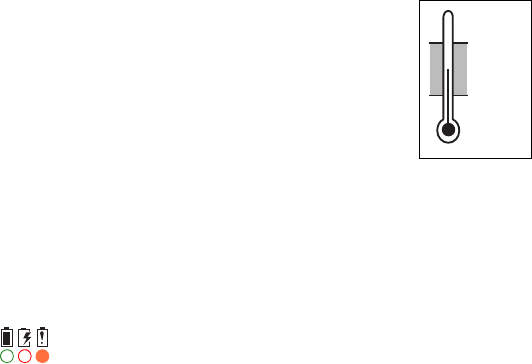
160 Charging and caring for batteries
Charging temperatures
Notice Do not expose a battery to very high or very
low temperatures for extended periods of time. Doing
so will shorten the usable life (‘service life’) of the
battery.
To achieve the best results when charging your
battery:
■Before you begin to charge your
battery, make sure that the battery
temperature is close to the room
temperature in which the battery is
to be charged.
■If possible, charge the battery in
temperatures between 50 °F
and 77 °F (between 10 °C and 25 °C).
This temperature range is the optimal charging
range.
Charging only starts when the battery is between
32 °F to 104 °F (0 °C to 40 °C).
When the battery temperature is outside the normal
charging range, the orange LED on the charger is lit.
Charging will start or resume once the temperature is
within normal limits, and no action is required by you.
Leaving the battery on charge
You can leave a battery/radio in the charger once
charging is complete. Leaving a battery in the charger
will not overcharge or damage it.
You can remove a battery/radio from the charger at
any time without harming the battery, the radio, or the
charger. When you return the battery/radio to the
charger, charging is automatically resumed.
77 °F
25 °C
50 °F
10 °C
Charging and caring for batteries 161
Vehicle chargers only
It is safe to switch off the ignition while there is still a
battery in the charger. But if the vehicle will not be
used again for some time, check whether charging will
continue while the ignition is off, and consider what
effect this might have on the vehicle battery.
To check, place the battery in the charger and switch
off the vehicle ignition:
■If no charger LED stays lit, the charger will resume
charging only when the ignition is switched on
again. Minimal charger standby power will be
drawn from the vehicle battery until then.
■If a charger LED stays lit, the charger will continue
to charge the radio battery even while the ignition
is off, and will continue to draw power from the
vehicle battery. Once the battery is charged, the
charger draws minimal current and has little effect
on a healthy vehicle battery.
Receiving calls while charging
(not for battery-only vehicle
charger)
Notice For best charging performance, switch off the
radio before placing it in the charger.
You can receive a call while the radio is in the charger,
but your radio performance may be degraded. If you
do remove the radio from the charger to answer a call,
the call will not be disrupted.
Removing the radio from the charger to make or
receive a call ends the charging process. Charging
safely recommences when the radio is reinserted into
the charger.
162 Charging and caring for batteries
If a radio was turned on while being charged, the
battery indicator may not be accurate when the radio
is initially removed from the charger. After a few
seconds, the battery indicator is updated to display
the amount of charge available in the battery.
Low battery warning
Notice Do not allow a radio battery to fully discharge
every time you use it, or you will shorten the service
life of the battery.
When the battery is low, your radio warns you in the
following ways:
■The battery symbol on the radio display looks
empty.
■The status LED on the radio slowly flashes red.
■A high-pitched beep sounds.
You should recharge or replace the battery as soon
as possible.
When the battery is completely empty, the message
Battery is flat appears on the display. The radio emits
a long, low-pitched beep and then stops working.
Turn off the radio.
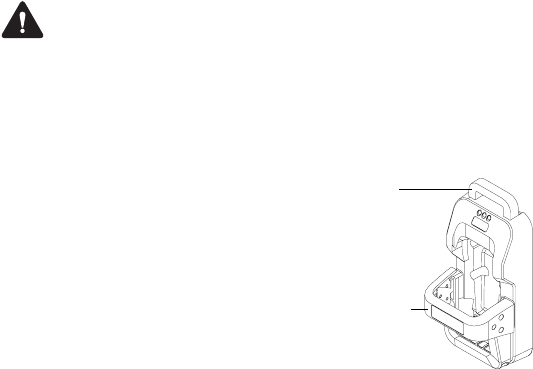
Charging and caring for batteries 163
Inserting the radio into the
vehicle charger
1Place the radio in the charger with the battery
attached.
Warning When the portable radio is used inside a
vehicle, radio performance is degraded. Use a mobile
radio for all critical communications. If the portable
radio must be left switched on while it is in the charger,
removing the radio from the charger will improve radio
performance. Check your local regulations about
using a portable radio in a vehicle.
2Firmly press the retention
bar towards the radio.
If the larger battery
(such as the IS/NI battery)
is attached to the radio,
there will be an audible
click as the catches
engage. If the smaller
battery is attached to the
radio, there will be two
audible clicks as the catches engage. If the
catches do not engage, remove the radio.
Press once firmly on the release bar, then try
again.
retention
bar
release
bar

164 Charging and caring for batteries
Charging a battery for the first
time
Fully charge a battery before using it for the first time.
The red LED stays lit while the battery charges.
Charging a battery
Notice For best charging performance, switch off the
radio before placing it in the charger (not for battery-
only vehicle charger).
1Desktop charger: Connect the charger to the
correct Tait power adaptor.
6-way charger and vehicle charger:
Power on the charger.
Initially, all three LEDs are lit for 2 seconds.
2Place just a battery in the charger, or a radio with
a battery attached (desktop charger or 6-way
charger only). There is no need to remove a belt
clip, antenna, or any accessory that is attached to
the accessory connector.
The red LED lights up, and stays lit while the
battery charges.
When charging is complete, the green LED stays
lit.
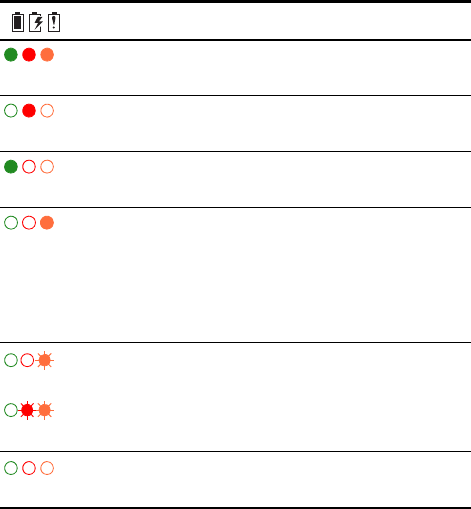
Charging and caring for batteries 165
LED behavior
If there is a battery in the charger when power is
supplied to the charger, the LEDs behave as follows:
If the charger does not behave as expected:
■Make sure the radio or battery is seated properly
in the charger. For the vehicle charger, see also
"Inserting the radio into the vehicle charger" on
page 163.
■Check that the charger is properly plugged into
the originally supplied power supply.
■Check that the battery and charger contacts are
clean. To clean, wipe the contacts with a dry lint-
free cloth to remove any dirt, oil or grease.
Meaning
briefly
The charger has been connected to a power
supply.
steady
The battery is charging.
steady
Charging complete. Remove the battery, or
leave it in the charger.
steady
■The battery temperature is outside the nor-
mal charging range. Charging will start or
resume once the temperature is within nor-
mal limits. No action is required by you.
■There is a fault. Contact your dealer.
or
flashing
If the LEDs for all charger slots continuously
flash orange, or red then orange, the charger
itself may be faulty (e.g. the 6-way charger fan
may be jammed). Contact your dealer.
all off
There is a fault. Contact your dealer.
166 Charging and caring for batteries
Removing the battery from the
charger
■Desktop charger and 6-way charger: Lift the bat-
tery/radio out of the charger.
■Battery-only vehicle charger: Pull up the top clip of
the vehicle charger, and then lift out the battery.
■Vehicle charger: Press down once firmly on the
release bar at the top of the vehicle charger, and
then lift out the radio.
You can remove a battery/radio from the charger at
any time without harming the battery, the radio, or the
charger. When you return the battery/radio to the
charger, charging is automatically resumed. You can
also leave a battery/radio in the charger once
charging is complete.
Maintaining battery life and
performance
With proper care and maintenance you will maintain
the performance and life of the battery. It is
recommended that you:
■Use only Tait chargers and batteries.
■Do not expose a battery to very high or very low
temperatures for extended periods of time. Doing
so will shorten the service life of the battery.
Very high: above 140 °F (60 °C)
Very low: less than –4 °F (–20 °C)
■Charge the battery at a room temperature of
between 50 °F and 77 °F (between 10 °C and
25 °C). This temperature range is the optimal
charging range.
■Wipe excess moisture and dirt from the radio,
radio contacts and battery contacts before charg-
ing the battery.

Charging and caring for batteries 167
■Store batteries properly when not in use.
See "Storing batteries".
Storing batteries
When not in use for a month or more, batteries should
be stored correctly to prolong their life.
■Remove the battery from the radio before storage.
■Fully charge the battery if storing for less than one
month.
■Charge non-IS batteries to about 30% if storing for
longer than one month.
■When storing IS batteries for any length of time,
fully charge the battery and check periodically as it
will discharge faster.
■Store in a cool dry place.
Batteries that have been stored for any length of time
must be charged before being used. See "Charging a
battery for the first time" on page 164.
Disposing of batteries
Run the battery flat before disposing of it. When
disposing of the battery, be sure to do so in an
environmentally sensitive manner. Please contact
your radio provider for information on recycling
programs in your area. See "Environmental
responsibilities" on page 8 for more information.
Troubleshooting 169
About troubleshooting
If you are experiencing difficulty operating your radio,
you may find the following sections helpful. Consult
your radio provider for assistance, if necessary.
When your radio won’t turn on
If the LED on your radio does not glow red when the
radio is turned on, it is probable that power is not
reaching the radio. Check the following:
■Is the battery firmly attached to the radio?
■Is the battery sufficiently charged?
■Is the battery charger working properly?
If all appears to be in order, but your radio still fails to
operate properly, contact your radio provider for
further assistance.
Identifying the radio’s audible
tones
The radio’s audible tones can help you identify a
potential problem. See "Audible tones" on page 46.
170 Troubleshooting
Viewing radio information
Your radio provider may ask you for the hardware
and firmware version of your radio, for
troubleshooting purposes.
Use the Radio info menu to view information such as
the hardware and firmware version of your radio,
function key settings, the radio serial number, and
various radio identities.
1Press Menu and select Radio settings >
Radio info.
2Scroll to the radio information you want to view and
press Select.
Checking the version of your radio using the
PTT key
1Turn off the radio.
2Hold down the PTT key and turn on the radio.
The firmware and hardware versions, and your
radio’s frequency band is briefly displayed.
General care
Your radio requires no regular maintenance other
than ensuring that the battery has sufficient charge
and that no damage has occurred to the antenna or
the battery.
Notice To prevent permanent damage to the radio
case, do not allow the radio to come into contact with
detergents, alcohol, aerosol sprays, or petroleum-
based products.
For general battery care, see "Maintaining battery life
and performance".
Troubleshooting 171
Cleaning the contacts of the battery
Notice Do not scratch or scrape the contacts of the
battery. If necessary, wipe the contacts of the battery
with a dry, lint-free cloth to remove any dirt, oil or
grease.
Cleaning the radio
If you need to clean the radio case, use a cloth
dampened with clean water.

172 Directive 1999/5/CE Declaration of Conformity
Directive 1999/5/CE Declaration of Conformity
da Dansk
Undertegnede Tait Limited erklærer
herved, at følgende udstyr TPDB1A,
TPDC0A, TPDH5A & TPDH7A overholder
de væsentlige krav og øvrige relevante
krav i direktiv 1999/5/EF.
Se endvidere:
www.taitradio.com/eudoc/
de Deutsch
Hiermit erklärt Tait Limited die Überein-
stimmung der Geräte TPDB1A, TPDC0A,
TPDH5A & TPDH7A mit den
grundlegenden Anforderungen und den
anderen relevanten Festlegungen der
Richtlinie 1999/5/EG.
Siehe auch:
www.taitradio.com/eudoc/
el Ελληνικά
Η Tait Limited δηλώνει ότι το TPDB1A,
TPDC0A, TPDH5A & TPDH7A
συμμορφώνεται προς τις ουσιώδεις
απαιτήσεις και τις λοιπές σχετικές διατάξεις
της Οδηγίας 1999/5/ΕΚ.
Βλέπε επίσηςι:
www.taitradio.com/eudoc/
en English
Tait Limited declares that this TPDB1A,
TPDC0A, TPDH5A & TPDH7A complies
with the essential requirements and other
relevant provisions of Directive 1999/5/EC.
See also:
www.taitradio.com/eudoc/
es Español
Por medio de la presente Tait Limited
declara que las radios TPDB1A, TPDC0A,
TPDH5A & TPDH7A cumplen con los
requisitos esenciales y cualesquiera otras
disposiciones aplicables o exigibles de la
Directiva 1999/5/CE. Véase también:
www.taitradio.com/eudoc/
fi Suomi
Tait Limited vakuuttaa täten että TPDB1A,
TPDC0A, TPDH5A & TPDH7A tyyppinen
laite on direktiivin 1999/5/EY oleellisten
vaatimusten ja sitä koskevien direktiivin
muiden ehtojen mukainen.
Katso:
www.taitradio.com/eudoc/
fr Français
Par la présente, Tait Limited déclare que
les appareils TPDB1A, TPDC0A, TPDH5A
& TPDH7A sont conformes aux exigences
essentielles et aux autres dispositions
pertinentes de la directive 1999/5/CE.
Voir aussi:
www.taitradio.com/eudoc/
it Italiano
Con la presente Tait Limited dichiara che
questo TPDB1A, TPDC0A, TPDH5A &
TPDH7A è conforme ai requisiti essenziali
ed alle altre disposizioni pertinenti stabilite
dalla direttiva 1999/5/CE.
Vedi anche:
www.taitradio.com/eudoc/
nl Nederlands
Hierbij verklaart Tait Limited dat het toestel
TPDB1A, TPDC0A, TPDH5A & TPDH7A
in overeenstemming is met de essentiële
eisen en de andere relevante bepalingen
van richtlijn 1999/5/ EG.
Zie ook:
www.taitradio.com/eudoc/
pt Português
Tait Limited declara que este TPDB1A,
TPDC0A, TPDH5A & TPDH7A está
conforme com os requisitos essenciais e
outras provisões da Directiva 1999/5/CE.
Veja também:
www.taitradio.com/eudoc/
sv Svensk
Härmed intygar Tait Limited att denna
TPDB1A, TPDC0A, TPDH5A & TPDH7A
står I överensstämmelse med de
väsentliga egenskapskrav och övriga
relevanta bestämmelser som framgår av
direktiv 1999/5/EG.
Se även:
www.taitradio.com/eudoc/
Tait Software Licence Agreement 173
Tait Software Licence Agreement
This Software License Agreement
("Agreement") is between you
(“Licensee”) and Tait Limited (“Tait").
By using any of the Software items
embedded and pre-loaded in the
related Tait Designated Product,
included on CD, downloaded from the
Tait website, or provided in any other
form, you agree to be bound by the
terms of this Agreement. If you do not
agree to the terms of this Agreement,
do not install or use any of the
Software. If you install or use any of
the Software, that will be deemed to be
acceptance of the terms of this
Agreement.
For good and valuable consideration,
the parties agree as follows:
SECTION 1 DEFINITIONS
“Confidential Information” means all
or any information supplied to or
received by Licensee from Tait,
whether before or after installation or
use and whether directly or indirectly
pertaining to the Software and
Documentation supplied by Tait,
including without limitation all
information relating to the Designated
Products, hardware, software;
copyright, design registrations,
trademarks; operations, processes,
and related business affairs of Tait;
and including any other goods or
property supplied by Tait to Licensee
pursuant to the terms of this
Agreement.
“Designated Products” means
products provided by Tait to Licensee
with which or for which the Software
and Documentation is licensed for
use.
“Documentation” means product and
software documentation that specifies
technical and performance features
and capabilities; user, operation, and
training manuals for the Software; and
all physical or electronic media upon
which such information is provided.
“Executable Code” means Software
in a form that can be run in a computer
and typically refers to machine
language, which is comprised of native
instructions the computer carries out in
hardware. Executable code may also
refer to programs written in interpreted
languages that require additional
software to actually execute.
“Intellectual Property Rights” and
“Intellectual Property” mean the
following or their substantial
equivalents or counterparts,
recognized by or through action before
any governmental authority in any
jurisdiction throughout the world and
including, but not limited to all rights in
patents, patent applications,
inventions, copyrights, trademarks,
trade secrets, trade names, and other
proprietary rights in or relating to the
Software and Documentation;
including any adaptations, corrections,
de-compilations, disassemblies,
emulations, enhancements fixes,
modifications, translations and
updates to or derivative works from,
the Software or Documentation,
whether made by Tait or another party,
or any improvements that result from
Tait processes or, provision of
information services.
“Licensee” means any individual or
entity that has accepted the terms of
this License.
“Open Source Software” means
software with freely obtainable source
code and license for modification, or
permission for free distribution.
“Open Source Software License”
means the terms or conditions under
which the Open Source Software is
licensed.
174 Tait Software Licence Agreement
“Person” means any individual,
partnership, corporation, association,
joint stock company, trust, joint
venture, limited liability company,
governmental authority, sole
proprietorship, or other form of legal
entity recognized by a governmental
authority.
“Security Vulnerability” means any
flaw or weakness in system security
procedures, design, implementation,
or internal controls that if exercised
(accidentally triggered or intentionally
exploited) could result in a security
breach such that data is compromised,
manipulated, or stolen, or a system is
damaged.
“Software” (i) means proprietary
software in executable code format,
and adaptations, translations, de-
compilations, disassemblies,
emulations, or derivative works of
such software; (ii) means any
modifications, enhancements, new
versions and new releases of the
software provided by Tait; and (iii) may
contain one or more items of software
owned by a third-party supplier. The
term "Software" does not include any
third-party software provided under
separate license or not licensable
under the terms of this Agreement.
“Source Code” means software
expressed in human readable
language necessary for
understanding, maintaining,
modifying, correcting, and enhancing
any software referred to in this
Agreement and includes all states of
that software prior to its compilation
into an executable programme.
“Tait” means Tait Limited and
includes its Affiliates.
SECTION 2 SCOPE
This Agreement contains the terms
and conditions of the license Tait is
providing to Licensee, and of
Licensee’s use of the Software and
Documentation. Tait and Licensee
enter into this Agreement in
connection with Tait delivery of certain
proprietary Software and/or products
containing embedded or pre-loaded
proprietary Software.
SECTION 3 GRANT OF
LICENSE
3.1. Subject to the provisions of this
Agreement and the payment of
applicable license fees, Tait grants to
Licensee a personal, limited, non-
transferable (except as permitted in
Section 7), and non-exclusive license
to use the Software in executable code
form, and the Documentation, solely in
connection with Licensee's use of the
Designated Products for the useful life
of the Designated Products. This
Agreement does not grant any rights to
source code.
3.2. If the Software licensed under this
Agreement contains or is derived from
Open Source Software, the terms and
conditions governing the use of such
Open Source Software are in the Open
Source Software Licenses of the
copyright owner and not in this
Agreement. If there is a conflict
between the terms and conditions of
this Agreement and the terms and
conditions of the any applicable Open
Source Software Licenses, the terms
and conditions of the Open Source
Software Licenses will take
precedence. For information about
Open Source Components contained
in Tait products and the related Open
Source licenses, see:
http://support.taitradio.com/go/
opensource
SECTION 4 LIMITATIONS ON
USE
4.1. Licensee may use the Software
only for Licensee's internal business
purposes and only in accordance with
the Documentation. Any other use of
the Software is strictly prohibited.
Without limiting the general nature of
these restrictions, Licensee will not
make the Software available for use by
Tait Software Licence Agreement 175
third parties on a "time sharing,"
"application service provider," "service
bureau" basis, or for any other similar
commercial rental or sharing
arrangement.
4.2. Licensee will not, and will not
directly or indirectly allow or enable
any third party to: (i) reverse engineer,
disassemble, extract components,
decompile, reprogram, or otherwise
reduce the Software or any portion
thereof to a human perceptible form or
otherwise attempt to recreate the
source code; (ii) modify, adapt, create
derivative works of, or merge the
Software; (iii) copy, reproduce,
distribute, lend, or lease the Software
or Documentation to any third party;
(iv) grant any sublicense or other rights
in the Software or Documentation to
any third party; (v) take any action that
would cause the Software or
Documentation to be placed in the
public domain; (vi) remove, or in any
way alter or obscure any copyright
notice or other notice of Tait or third-
party licensor’s proprietary rights; (vii)
provide, copy, transmit, disclose,
divulge or make the Software or
Documentation available to, or permit
the use of the Software by, any third
party or on any machine except as
expressly authorized by this
Agreement; or (viii) use, or permit the
use of, the Software in a manner that
would result in the production of a copy
of the Software by any means
whatsoever other than what is
permitted in this Agreement. Licensee
may make one copy of the Software to
be used solely for archival, back-up, or
disaster recovery purposes; provided
that Licensee may not operate that
copy of the Software at the same time
as the original Software is being
operated. Licensee may make as
many copies of the Documentation as
it may reasonably require for the
internal use of the Software.
4.3. Unless otherwise authorized by
Tait in writing, Licensee will not, and
will not enable or allow any third party
to: (i) install a copy of the Software on
more than one unit of a Designated
Product; or (ii) copy or transfer
Software installed on one unit of a
Designated Product to any other
device. Licensee may temporarily
transfer Software installed on a
Designated Product to another device
if the Designated Product is inoperable
or malfunctioning. Temporary transfer
of the Software to another device must
be discontinued when the original
Designated Product is returned to
operation and the Software must be
removed from the other device.
4.4. Licensee will maintain, during the
term of this Agreement and for a
period of two years thereafter,
accurate records relating to this
license grant to verify compliance with
this Agreement. Tait, or a third party
nominated by Tait, may inspect
Licensee’s premises, books and
records, upon reasonable prior notice
to Licensee, during Licensee’s normal
business hours and subject to
Licensee's facility and security
regulations. Tait is responsible for the
payment of all expenses and costs of
the inspection, provided that Licensee
shall indemnify Tait for all costs
(including audit costs and legal costs
on a solicitor client basis) if Licensee
has breached the terms of this
Agreement. Any information obtained
by Tait during the course of the
inspection will be kept in strict
confidence by Tait and used solely for
the purpose of verifying Licensee's
compliance with the terms of this
Agreement.
SECTION 5 OWNERSHIP AND
TITLE
Tait, its licensors, and its suppliers
retain all of their Intellectual Property
Rights in and to the Software and
Documentation, in any form. No rights
are granted to Licensee under this
Agreement by implication, estoppel or
176 Tait Software Licence Agreement
otherwise, except for those rights
which are expressly granted to
Licensee in this Agreement. All
Intellectual Property developed,
originated, or prepared by Tait in
connection with providing the
Software, Designated Products,
Documentation, or related services,
remains vested exclusively in Tait, and
Licensee will not have any shared
development or other Intellectual
Property Rights.
SECTION 6 LIMITED
WARRANTY; DISCLAIMER
OF WARRANTY
6.1. The commencement date and the
term of the Software warranty will be a
period of one (1) year from Tait
shipment of the Software. If Licensee
is not in breach of any obligations
under this Agreement, Tait warrants
that the unmodified Software, when
used properly and in accordance with
the Documentation and this
Agreement, will be free from a
reproducible defect that eliminates the
functionality or successful operation of
a feature critical to the primary
functionality or successful operation of
the Software. Whether a defect has
occurred will be determined solely by
Tait. Tait does not warrant that
Licensee’s use of the Software or the
Designated Products will be
uninterrupted, error-free, completely
free of Security Vulnerabilities, or that
the Software or the Designated
Products will meet Licensee’s
particular requirements. Tait makes no
representations or warranties with
respect to any third-party software
included in the Software.
6.2 Tait sole obligation to Licensee,
and Licensee’s exclusive remedy
under this warranty, is to use
reasonable efforts to remedy any
material Software defect covered by
this warranty. These efforts will involve
either replacing the media or
attempting to correct significant,
demonstrable program or
documentation errors or Security
Vulnerabilities. If Tait cannot correct
the defect within a reasonable time,
then at Tait option, Tait will replace the
defective Software with functionally
equivalent Software, license to
Licensee substitute Software which
will accomplish the same objective, or
terminate the license and refund
Licensee’s paid license fee. If Tait
investigation of the perceived defect
reveals that no such defect in fact
exists, Tait may recover its costs in
respect of such investigation from
Licensee.
6.3. Tait disclaims any and all other
warranties relating to the Software or
Documentation other than the express
warranties set forth in this Section 6.
Warranties in Section 6 are in lieu of all
other warranties whether express or
implied, oral or written, and including
without limitation any and all implied
warranties of condition, title, non-
infringement, merchantability, or
fitness for a particular purpose or use
by Licensee (whether Tait knows, has
reason to know, has been advised of,
or is otherwise aware of any such
purpose or use), whether arising by
law, by reason of custom or usage of
trade, or by course of dealing. In
addition, Tait disclaims any warranty
to any person other than Licensee with
respect to the Software or
Documentation.
SECTION 7 TRANSFERS
7.1. Licensee will not transfer the
Software or Documentation to any
third party without specific prior written
consent from Tait. Tait may withhold
such consent or at its own discretion
make the consent conditional upon the
transferee paying applicable license
fees and agreeing to be bound by this
Agreement.
7.2. In the case of a value-added
reseller or distributor of Tait
Designated Products, the consent
Tait Software Licence Agreement 177
referred to in Section 7.1 may be
contained in a Tait Reseller or Tait
Distributor Agreement.
7.3. If the Designated Products are
Tait vehicle-mounted mobile products
or hand-carried portable radio
products and Licensee transfers
ownership of the Tait mobile or
portable radio products to a third party,
Licensee may assign its right to use
the Software which is embedded in or
furnished for use with the radio
products and the related
Documentation; provided that
Licensee transfers all copies of the
Software and Documentation to the
transferee.
7.4. For the avoidance of any doubt,
Section 7.3 excludes TaitNet
Infrastructure, or the products listed at
any time under network products at:
http://www.taitradio.com.
7.5. If Licensee, as a contractor or
subcontractor (integrator), is
purchasing Tait Designated Products
and licensing Software not for its own
internal use but for end use only by a
Customer, the Licensee may transfer
such Software, but only if a) Licensee
transfers all copies of such Software
and the related Documentation to the
transferee and b) Licensee has first
obtained from its Customer (and, if
Licensee is acting as a subcontractor,
from the interim transferee(s) and from
the ultimate end user sub license) an
enforceable sublicense agreement
that prohibits any other transfer and
that contains restrictions substantially
identical to the terms set forth in this
Software License Agreement. Except
as stated in the foregoing, Licensee
and any transferee(s) authorised by
this Section may not otherwise
transfer or make available any Tait
Software to any third party nor permit
any party to do so. Licensee will, on
request, make available evidence
reasonably satisfactory to Tait
demonstrating compliance with all the
foregoing.
SECTION 8 TERM AND
TERMINATION
8.1. Licensee’s right to use the
Software and Documentation will
commence when the Designated
Products are supplied by Tait to
Licensee and will continue for the life
of the Designated Products with which
or for which the Software and
Documentation are supplied, unless
Licensee breaches this Agreement, in
which case this Agreement and
Licensee's right to use the Software
and Documentation may be
terminated immediately upon notice by
Tait.
8.2. Within thirty (30) days after
termination of this Agreement,
Licensee must certify in writing to Tait
that all copies of the Software have
been removed or deleted from the
Designated Products and that all
copies of the Software and
Documentation have been returned to
Tait or destroyed by Licensee and are
no longer in use by Licensee.
8.3. Licensee acknowledges that Tait
made a considerable investment of
resources in the development,
marketing, and distribution of the
Software and Documentation and that
Licensee's breach of this Agreement
will result in irreparable harm to Tait for
which monetary damages would be
inadequate. If Licensee breaches this
Agreement, Tait may terminate this
Agreement and be entitled to all
available remedies at law or in equity
including immediate injunctive relief
and repossession of all non-
embedded Software and associated
Documentation. Licensee shall pay all
Tait costs (on an indemnity basis) for
the enforcement of the terms of this
Agreement.
SECTION 9 CONFIDENTIALITY
Licensee acknowledges that the
Software and Documentation contain
proprietary and Confidential
Information valuable to Tait and are
178 Tait Software Licence Agreement
Tait trade secrets, and Licensee
agrees to respect the confidentiality of
the information contained in the
Software and Documentation.
SECTION 10 LIMITATION OF
LIABILITY
10.1. In no circumstances shall Tait be
under any liability to Licensee, or any
other person whatsoever, whether in
Tort (including negligence), Contract
(except as expressly provided in this
Agreement), Equity, under any
Statute, or otherwise at law for any
losses or damages whether general,
special, exemplary, punitive, direct,
indirect, or consequential arising out of
or in connection with any use or
inability of using the Software.
10.2. Licensee’s sole remedy against
Tait will be limited to breach of contract
and Tait sole and total liability for any
such claim shall be limited at the
option of Tait to the repair or
replacement of the Software or the
refund of the purchase price of the
Software.
SECTION 11 GENERAL
11.1. COPYRIGHT NOTICES. The
existence of a copyright notice on the
Software will not be construed as an
admission or presumption of
publication of the Software or public
disclosure of any trade secrets
associated with the Software.
11.2. COMPLIANCE WITH LAWS.
Licensee acknowledges that the
Software may be subject to the laws
and regulations of the jurisdiction
covering the supply of the Designated
Products and will comply with all
applicable laws and regulations,
including export laws and regulations,
of that country.
11.3. ASSIGNMENTS AND
SUBCONTRACTING. Tait may assign
its rights or subcontract its obligations
under this Agreement, or encumber or
sell its rights in any Software, without
prior notice to, or consent of, Licensee.
11.4. GOVERNING LAW. This
Agreement shall be subject to and
construed in accordance with New
Zealand law and disputes between the
parties concerning the provisions
hereof shall be determined by the New
Zealand Courts of Law. Provided
however Tait may at its election bring
proceedings for breach of the terms
hereof or for the enforcement of any
judgment in relation to a breach of the
terms hereof in any jurisdiction Tait
considers fit for the purpose of
ensuring compliance with the terms
hereof or obtaining relief for breach of
the terms hereof.
11.5. THIRD-PARTY
BENEFICIARIES. This Agreement is
entered into solely for the benefit of
Tait and Licensee. No third party has
the right to make any claim or assert
any right under this Agreement, and no
third party is deemed a beneficiary of
this Agreement. Notwithstanding the
foregoing, any licensor or supplier of
third-party software included in the
Software will be a direct and intended
third-party beneficiary of this
Agreement.
11.6. SURVIVAL. Sections 4, 5, 6.3, 7,
8, 9, 10, and 11 survive the termination
of this Agreement.
11.7. ORDER OF PRECEDENCE. In
the event of inconsistencies between
this Agreement and any other
Agreement between the parties, the
parties agree that, with respect to the
specific subject matter of this
Agreement, this Agreement prevails.
11.8. SECURITY. Tait uses
reasonable means in the design and
writing of its own Software and the
acquisition of third-party Software in
order to limit Security Vulnerabilities.
While no software can be guaranteed
to be free from Security Vulnerabilities,
if a Security Vulnerability is
discovered, Tait will take the steps
specified in Section 6 of this
Agreement.
Tait Software Licence Agreement 179
11.9. EXPORT. Licensee will not
transfer, directly or indirectly, any
Designated Product, Documentation
or Software furnished hereunder or the
direct product of such Documentation
or Software to any country for which
New Zealand or any other applicable
country requires an export license or
other governmental approval without
first obtaining such license or
approval.
11.10. SEVERABILITY. In the event
that any part or parts of this Agreement
shall be held illegal or null and void by
any court or administrative body of
competent jurisdiction, such
determination shall not affect the
remaining terms which shall remain in
full force and effect as if such part or
parts held to be illegal or void had not
been included in this Agreement. Tait
may replace the invalid or
unenforceable provision with a valid
and enforceable provision that
achieves the original intent and
economic effect of this Agreement.
11.11. CONSUMER GUARANTEES.
Licensee acknowledges that the
licenses supplied in terms of this
agreement are supplied to Licensee in
business, and that the guarantees and
other provisions of prevailing
consumer protection legislation shall
not apply.
11.12. WHOLE AGREEMENT.
Licensee acknowledges that it has
read this Agreement, understands it
and agrees to be bound by its terms
and conditions. Licensee also agrees
that, subject only to the express terms
of any other agreement between Tait
and Licensee to the contrary, this is
the complete and exclusive statement
of the Agreement between it and Tait
in relation to the Software. This
Agreement supersedes any proposal
or prior agreement, oral or written, and
any other communications between
Licensee and Tait relating to the
Software and the Designated
Products.
180 Tait Software Licence Agreement
